The Northlands Saga Complete by Libertad!
Hagalaz, Hail!
Original SA post The Northlands Saga Complete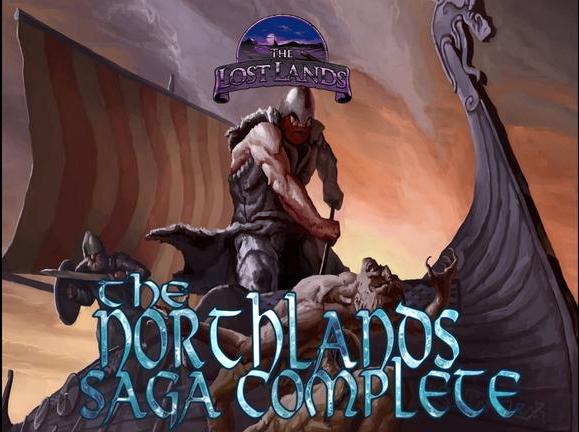
The Northlands Saga Complete is a Norse-themed sword-and-sorcery campaign setting and adventure path. Made for both Pathfinder and Swords & Wizardry (OD&D retroclone), it is a far-ranging epic inspired by the culture and folklore of the Viking era, and for the past year I have been running it for a weekly Sunday group. Although like any level 1 to 20 Pathfinder campaign it has its system-related warts, it helped create a campaign that has been lots of fun like no other, and with all the notes and work I’ve done on it I decided to make an in-depth review.
First, a brief history of the publication. Back in 2011 when Skyrim was the next big thing and the hills were alive with the sounds of thu’um, Frog God Games began working on a playtest for a Viking-themed adventure. One of the chief writers, Ken Spencer, was an archaeologist and history teacher with a deep passion for medieval Scandinavia and its legends. He sought to create a setting which borrowed heavily from that region’s cultural aspects, and four adventures were made in total for this new setting. But the line was put on hold for five years until a successful KickStarter produced a massive book, including not just the original adventures but eight new ones and an expanded setting to boot.
The Northlands Saga Complete is split into two major sections: the Northlands Saga Campaign Guide and the Northlands Saga Adventure Path. After that are several appendices of player handouts and maps (both player-friendly and GM eyes’ only versions), pregenerated player characters, and a bonus stand-alone adventure. We are going to cover the Campaign Guide here first.
Hagalaz, Hail!

This is the introductory chapter covering the overall feel of the world, the regions’ history, and a discussion on Kennings (compound expressions with metaphorical meanings often used in poetry). Basically the Northlands is part of the wider Lost Lands campaign setting published by Frog God Games, but the influence of the rest of the world is minimal enough that the Northlands may as well be on its own for most games. The Northlands is a low magic sword-and-sorcery style realm where most of civilization are villages at best and the largest city is about 4,000 people strong. While some magic is socially acceptable in the form of cunning women and folkloric charms it is rarely understood and almost never a regular occurance. The setting has fantasy races, but is humanocentric in a Ravenloftian vein where dwarves and elves are isolated, halflings and gnomes don’t exist at all in the region, and cannon fodder baddies tend to rival Vikings, cultists, and various kinds of giant-kin instead of kobolds, goblins, and orcs.
The Northlands proper is sits on the northern reach of Akados, the major continent of the Lost lands, and the southern reach of the arctic continent of Boros. It has a Meditteranean-style geography where a central North Sea dominates the center and the various lands circle around it. Due to this, sea travel is a vital aspect of life for most people if only due to trade.
History
The region has been home to thousands of years’ worth of immigration, with the ethnic Northlander humans the most recent arrival (about 800 years ago). The first settlers were the Andøvans, who mastered bronze-working and whose cultural legacy is only known via the large amount of haunted mountain ruins and barrow mounds left behind. They went to war against invading trolls and lost, causing their culture to cease to be. A thousand years later the next group of settlers were a tribe of elves known as the Nûk who were on a religious pilgrimage. With the forest the only place unclaimed by the numerous trollish tribes they and settled there in secret.
1,500 years later, a tribe of humans known as the Uln arrived and unsuccessfully warred against the trolls. They went further north and settled into newly-discovered city ruins. For a while they lived well, but then some people stumbled upon buried texts dedicated to the demon lord Althunak, Lord of Ice and Stone. In a short time his growing cult plunged the cities into bloody war. The Uln driven from the cities soon became the Ulnat, the fantasy counterpart-Inuit people of the Northlands. Althunak's cult held sway for a time until a hero, Hvran the Half-born, earned the trust of several tribes and led a band of mighty warriors. They fought a great battle against the demon-god himself, and Hvran sacrificed himself to trap Althunak beneath a frozen lake.
150 years later a group of Hel worshipers were contained in a walled-off peninsula after years of continuous war with a greater empire. There was a dude named Swein Sigurdson who thought that Hel had it all wrong, so he fought and escaped with like-minded people into the not-Underdark. In these dire depths Swein received a vision from Wotan, head of the Æsir, who told him of a new place to settle and to follow the tunnels north. Traveling through the Under Realms for months they finally found light in what is now the Northlands, and fought a war against the trolls there. The humans won, the giants were driven off, Swein Sigurdson was declared the High Køenig, and the society of modern Northlanders came into being.
TL;DR Barrow-building humans fight and lose against trolls, elves migrate to the forests, the not-Inuit defeat not-Sauron, not-Nordics are led by Odin through the Underdark to the Northlands and drive off the trolls. And if you’re wondering what the deal with the seeming disconnected events is, they tie into the later campaign to various extents. Especially Althunak who is more or less the BBEG of the Northlands Saga.
Kennings
Along with a pronunciation guide on Nordic spellings not present in English, the last section of the introduction discusses the concept of kennings, or word pictures expressed by skalds and reciters of oral traditions. Quite a bit of in-game text and NPC conversation makes use of such kennings, although not overly so (mostly important and well-spoken NPCs). Basically they are ways to paint a picture of common concepts via metaphors, references to godly traits, and the like. It gives a sample list of common kennings as a means of using them in your own campaign. Although I admit that I did not use this often, I did enjoy this personal touch in spite of the "blood-worm" jokes spawned.
Word on Pronunciation posted:
Pronunciation of words from a Nordic base is no easy task to a non-Nordic tongue, and many of the place names, and names of gods and heroes are just that. They are not, for the most part, intended to be a true rendering of Norwegian or even ancient Norse words and names, but they are meant to convey that flavor. As a result, there are some spelling habits that are perhaps strange to the eyes of many gamers. As a result, we’ve included a little bit of a pronunciation guide, though it is no way meant to be a didactic or exhaustive discussion of the subject in any real-life context. It merely explains the conventions we have used in the Northlands Saga. As with anything game related, they are there for you to use or ignore as you see fit.
Of immediate note is undoubtedly the fact that many names end in an ‘r’ that do not normally do so. This final ‘r’ of Nordic origin is often left off in Western renderings, but to lend the air of legitimacy to our Northlands setting, we have opted to go for the older, more obscure spelling. However, in general the final ‘r’ is silent unless it follows a vowel, so that ‘Thor’ is still ‘Thor’, but ‘Grimr’ would be pronounced ‘Grim’. In the case of ‘Baldr’, however, conventional use would still pronounce it ‘Balder’, so this rule is far from absolute.
For vowels, ‘Æ, æ’ is usually pronounced like ‘eye’ or ‘ay’; ‘Á, á’ is pronounced like ‘ow’; ‘Ö, ö’ and ‘Ø, ø’ are pronounced like ‘oeh’, and the other accented vowels are held longer. Unaccented vowels usually have their long sound. The letter ‘Ð, ð’ is called ‘eth’. It is pronounced as a ‘th’ sound and is sometimes used interchangeably with the letter ‘Þ, þ’ (called ‘thorn’ and also pronounced with a ‘th’ sound).
While these hints by no means create a fully authentic pronunciation in terms of real ancient Nordic and Germanic languages, they will help you to catch the intended flavor and feel. However, if it is easier, just use the spellings for the look of them and make your pronunciations whatever is simplest for you. Use them as best fits your tastes.
Kennings posted:
Common Kennings of the Northlands
Alfar dwimmer: magic
Baldr’s bane: mistletoe
battle-dew: blood
blood-ember: axe
blood-worm: sword
breaker of rings: Køenig or jarl
Corpse-ripper: the dragon Nídhöggr, chews
upon the corpses of murderers, adulterers, and
oath-breakers
easer of raven’s hunger: generous leader
feeder of ravens: warrior
Freyja’s tears: amber
Hanged God: Wotan
Frigg’s thread: gold
icicle of blood: Sword or spear
Loptr’s favor: fire
Loptr’s mead: lies/deception
mind’s worth: courage/honor
moon distaff’s thread: silver
Rán’s hammer: waves
raven harvest: corpse
ring-giver: Køenig or jarl
sea-steed: ship
shame of swords: shield
Sif’s hair: gold
sky-candle: the sun
slaughter-dew: blood
Slayer of Giants: Donar
spear-din: battle
swan of blood: raven
sword-sleep: death
wave-cutter: ship
wave-swine: ship
wave thread: sea serpent
Wotan’s children: raven
weather of weapons: war
whale road: sea
wolf-hearted: coward, oath-breaker, one
without mind’s worth
wound-hoe: sword
wound-sea: blood
Chapter 1: Mannaz, The Peoples
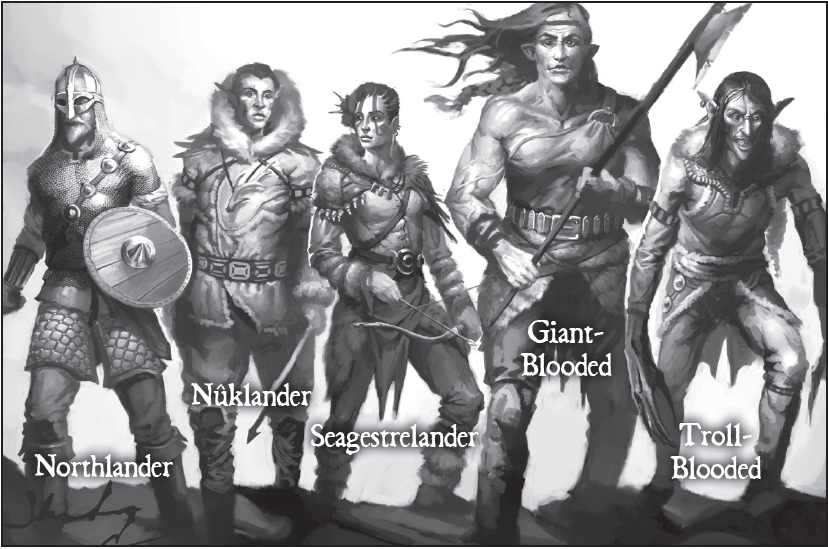
The chapter starts off by mentioning that in terms of D&D races the Northlands is not as varied as the typical setting or other places in the Lost Lands. Only humans and Nûklander elves have any significant population size (with a few half-elves around), and the few dwarves around are relegated in small communities in the two largest towns. Halflings, gnomes, and elves of other tribes are individual foreigners if they come into the region. Orcs, half-orcs, goblins, bugbears, and gnolls are virtually absent, but replacing their niche are all varieties of giant. Just about every type of Monster Manual giant can be found in the Northlands along with some new ones in this book, and there are many varieties of trolls. The setting mentions that giants in the Northlands are always of Evil alignment, and giant and troll-blooded people merely have it as a strong tendency rather than an inherent trait. Funny enough, although the pre-generated PCs include a dwarf and are kind of a big deal in Norse mythology, they don’t get a write-up in this chapter at all and are more or less “invisible” in the adventure path.

There is a brief entry on languages, with some interesting notes: one, there is a “Common” tongue but it’s spoken far south in lands once dominated by an expansive empire and so isn’t a language you start play with automatically. The lingua franca of ethnic Northlanders is Nørsk, with the written version known as Runic and treated as a separate language because literacy is rare and effectively an art all its own. Andøvan is now a dead language, and Nûklander, Seagestrelander, and Ulnat are spoken by their respective cultures. Two demonic cults, the Beast Cult and the Children of Althunak, use Beast Cult Sign Language and Old Uln as secret code tongues respectively.
The Northlanders are the most populous human cultural group in the setting and you guessed it, fantasy counterpart Scandinavians. Although no strangers to battle, most Northlanders live an agricultural lifestyle of growing crops and animal husbandry. Still, their economy is supplemented by warfare, trade, and raiding and almost every family owns several weapons for self-defense and chainmail if they’re well-to-do. They have a hierarchy of social classes ranging from thralls (slaves, usually foreigners or those in debt), freemen (majority of Northlanders), and jarls (leaders who have enough wealth and goodwill to get the other social classes to pledge their lives to them). Northlander social structure is not ironclad; thralls can buy their freedom, and in some lands a jarl’s influence is tempered by democratic assemblies known as Things and can fall out of influence if their competence falters.
The rest of the section is rather wordy, but I can point out a few interesting things: Northlanders don’t use horses for warfare, as they are meant for travel. Many Northlander realms have a social gathering known as a Thing where every person can cast a vote for matters of laws, crimes, and public works projects. There is a cultural tradition known as laws of housing where a guest and host have mutually-beneficial social contracts. Religion is a low-key affair where local priests known as godi are a part-time local position. Actual spellcasting clerics and druids are very rare specialized godi who forged a bond with a specific deity. And kinship is broken up into small extended familes, with are part of a clan akin to a widely extended family which can be far-flung. The heads of families and clans have the same rights and duties as a jarl, and two of the realms (Gatland and Hrolfland) use the family/clan social system as the basis for their society.
Next up are the Nûk or Nûklanders, elves who are more or less fantasy counterpart-Sami. They are the descendants of a persecuted cult whose god said that he would lead his people north to a bountiful land. After several civil wars encouraged them to move thousands of miles to the promised realm, they found that their dream destination was far from hospitable. Betrayed, the people turned against the more devout followers and leaders in a night of slaughter and forsook worship of the gods in favor of calling out to the spirits of nature.
Nûklanders primarily live in the forests and tundras of the Northlands’ northernmost reaches and beyond as nomadic reindeer herders. They have some limited trade with the Northlanders of Estenfird and are on generally positive terms with them. Nûk societies are governed entirely by direct democracy councils (the concept of one person commanding many is a strange concept to them). Their society also greatly distrusts arcane magic, and practitioners face exile or death if they cannot conceal their talents. Druids, oracles, and rangers are the most common classes, with fighters rarer but when they do show up make for amazing cavalry with war-trained reindeer.
In game terms Nûklanders share the racial traits of Pathfinder elves, save that instead of gaining typical enchantment/sleep resistance and spell resistance/spellcraft bonuses they get cold resistance 5 and the silent hunter trait (reduce stealth penalties for higher speed by 5 and can use Stealth while running at -20). This is not exactly a bad trade-off, and overall I found cold damage more common than enchantment and sleep.
The other human ethnic group detailed in this chapter are the Seagestrelanders, and I am unsure what real-world culture they are meant to replicate; my closest guess are Celtic peoples. The term “Seagestrelander” is a catch-all for the hundreds of warring tribes that live between the southwest shores of the North Sea and the southern plains of the Sea of Grass. Most of them live within the forests of their namesake and the coastal shores, with expansion blocked off by natural geography. They are mostly farmers, herders, and fishermen and their lands are poor in mineral wealth. As Northlanders have metal goods, they are willing to trade their iron weapons and armor in exchange for amber, gold, and slaves. This last commodity exacerbated the violence among the Seagestrelanders themselves and with Northlanders as well. Rival tribes sell off prisoners of war, and Northlander vessels come to raid as well as trade.
Seagestrelanders build their villages around god-trees, the stumps of massive hollowed-out trunks where idol representations of their deities are placed. Funerary and worship rites take place here, and Seagestrelander spellcasters gain automatic Maximize Spell on all spells cast within 30 feet of a god-tree. Magic is even less common among them than the Northlanders, but when it does show up they are almost always honored regardless of their type of magic. All spells, arcane or divine, are viewed as gifts from the gods.
Seagestrelander characters are usually of the martial variety. The section mentions that Seagestrelander PCs will face difficulty in the Northlands, as the vast majority of them are thralls and generally assumed to be such by the populace. It mentions the idea of a slave PC, but doesn’t go in much on actual advice beyond being a “role-playing challenge for experienced and mature groups.” Interesting thing is, slavery and thralldom isn’t really touched upon in the adventure path, and demographics-wise thralls make up a very small portion of the population (one to five percent in places and almost never past ten percent). It's more or less a vague backdrop of the setting.
Although not detailed here, one human ethnic group I wanted to touch on are the Ulnat or fantasy counterpart Inuit. They live in the Far North, an arctic region beyond the Northlands dominated by tundra and mountains. Like the Northlanders they are a heavily maritime people, relying upon the sea for their livelihood. They are a society of hunters and trappers because their native environs are unsustainable for agriculture, and their main method of transportation on land are sled dogs. The sourcebook does not make much mention of their religious and cultural traditions beyond the fact that the heroes who overthrew the Cult of Althunak are buried in small tombs with their prized possessions.
The Giant-blooded are one of the 2 entirely new races of the setting. They are like half-elves or half-orcs in that they are a hybrid people living among a more dominant culture. Giant-blooded are either the product of a human-giant union or more rarely two human parents (a recessive trait). Giant-blooded infants are usually killed at birth, and those who are spared are relegated to the fringes of society. A few jarls keep giant-blooded around for their great physical strength for both farming and warfare purposes, but others treat them as freak shows to show off to entertain guests. Giant-blooded rarely if ever appear among the Seagestrelanders, and given the Ulnat’s geographic position are unknown among them. They are quite likely to be adventurers on account of societal prejudices and innate wanderlust pushing them to move.
Stat-wise giant-blooded are almost entirely built to be melee warriors. They have +4 Strength, +2 Constitution, -2 Dexterity, and -2 Charisma. They are Large, have a Reach of 10 feet and speed of 40 feet on account of their large frames, and to offset the size and Dexterity penalties to AC they have +1 natural armor. Low-light Vision is their only ability not explicitly “muscle-based,” so if you’re going to be giant-blooded your role is more or less determined for you unless you’re going for a self-imposed challenge.
The other new race are the Troll-blooded who are much like the giant-blooded save they are even rarer, more physically monstrous, even more vilified, and have a strong persistent hunger that is a drain on larders during wintertime. Those not slain at birth are either hidden away from the rest of society or treated as expendable thralls to be thrown in battle against one’s enemies. Troll-blooded adventurers become so mostly to find a means to satiate violent drives and their hunger (the book notes that heroes eat well no matter their ancestry).
Stat-wise troll-blooded are melee-friendly, but not as much as the giant-blooded. They have +2 Strength, +4 Constitution, and -4 Charisma. They are Medium size and have darkvision to a range of 60 feet, along with a pair of claws that deal 1d4 damage and the Ferocity trait which is similar to the half-orc’s save that you are staggered when you fall below 0 hit points. In line with their heritage, their last two traits are the ability to safely eat any organic substance and immunity to ingested poisons from this. Their weakness is fire, and take 1 more point of damage per damage die from fire-based attacks.
Troll-blooded are a bit more versatile than giant-blooded on account that their racial traits are a bit all over the place. Their claws and ability to eat anything are very situational, but ferocity is effectively a free Diehard feat. The Strength and Constitution bonuses are nice, although the giant-blooded’s natural reach is a more attractive option for melee types.
Classes
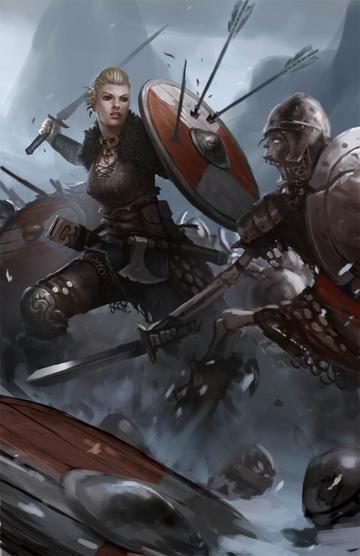
Picture from bobkehl of deviantart and not in the book but did not want this to be too wall of texty
Although technically covered in the Northlander section, there an in-depth discussion on classes. Unlike many other settings Northlands has classes which are “banned” or at least heavily discouraged or changed around. The realm is more or less Early Middle Ages/Viking Era in technology and aesthetics: alchemists, cavaliers, gunslingers, inquisitors, monks, ninja, and samurai are almost invariably foreigners from the Southlands (catch-all term for everyone south of the Northlands). The book notes that the PCs are meant to be heroes of an epic saga, and should be able to break the mold via a good backstory of how they came upon these strange traditions.
Classes which are reflavored for the setting include Barbarians, who are holy men and women of Wotan (Odin) who struggled with violent impulses but learned to tame their inner fires via divine guidance. They are either Bearsarkars or Ulfhanders, new archetypes described later in new rules in Chapter 4. Bards are known as skalds and well-respected for their inspiring abilities and knowledge of history and culture in spite of their arcane powers (which they try to disguise as “natural ability”). Clerics and Druids are a rare sort of godi who made a pact with a specific deity to carry out their will. Nûklander druids are an exception, who don’t worship the gods but instead call upon the spirits of nature to grant them power. Fighters are perhaps the most common PC class among the Northlands in general, but Monks are typically seen as having a near-supernatural control over their bodies and distrusted. Paladins are all-female spear maidens who pledged their services either to Baldr, Donar (Thor), or Wotan (Odin) but are seen less as holy warriors but rather defenders of home and clan whose abilities are derived from the blessings of wyrd (fate). Rangers are the next most common class after Fighters, usually of the non-magic-using archetypes (I don’t know if any such exist in Pathfinder beyond 3rd party). Rogues are surprisingly rare, the justification that theft is a major crime, there are not many locks and mechanical traps save in the ruins of the Andøvans, and what “organized crime” exists in the Northlands are less thieves’ guilds and more bandits, raiders, and the Jomsvikings who are decidedly more martial in nature. Arcane spellcasters of all stripes are exceedingly rare to the point of only being known in myth and legend these days. When encountered most people assume them to be dangerous, and summoners are particularly hated for belief that their minions come from the Ginnungagap (primordial cosmic void) or the creations of demons and giants. The only two exceptions to this mistrust are the aforementioned bards and cunning women, an all-female sorcerous bloodline supplemented with healing powers. Both of these disciplines are well-respected professions. Seagestrelanders are more open and view magic of all kinds as blessings of the gods, whereas Nûklanders outlaw all types of magic save non-deific druidism.
And so ends our first chapter!
Next up is Odal, the Lands!
Odal, the Lands
Original SA postBinaryDoubts posted:
This is very cool. I love seeing APs and settings get dissected.
Thank you for the vote of confidence. In spite of its KickStarter and high praise from Endzeitgeist, talk about it has been rather rare in the tabletopsphere.
Chapter 2: Odal, the Lands
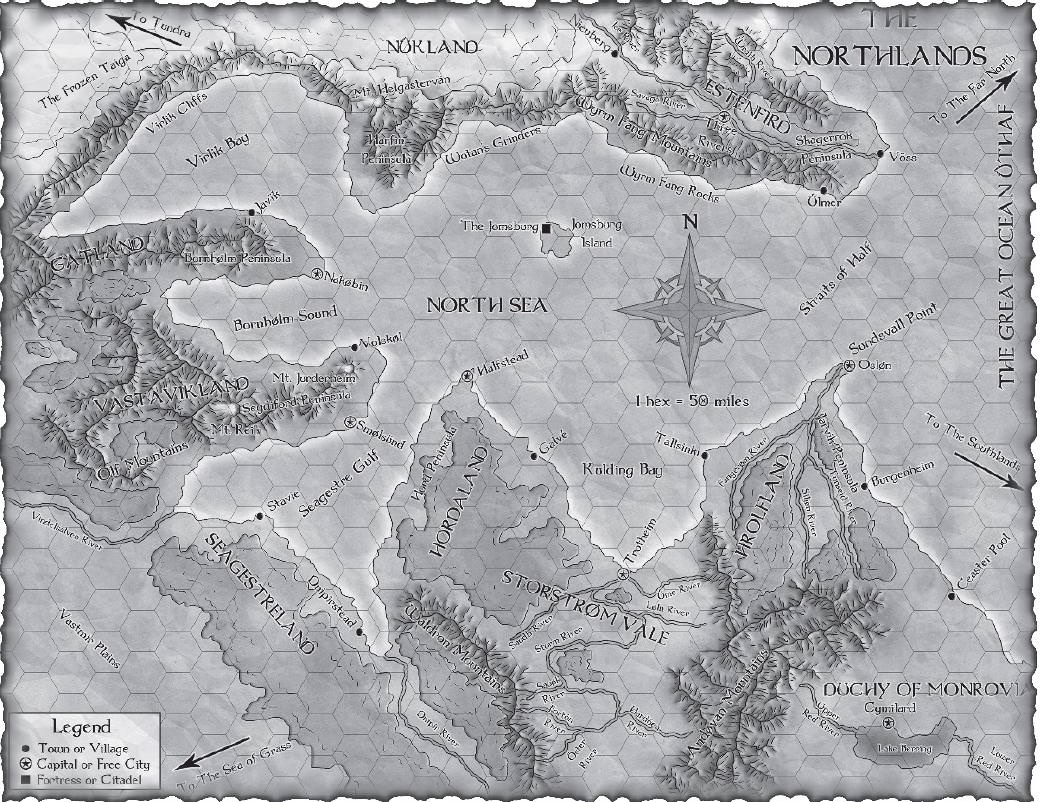
This is a big-picture view of the Northlands' eight major regions, along with known lands beyond. With the exception of Hrolfland, they are more akin to geographic regions than unified kingdoms, with most lands a political patchwork of ever-shifting alliances between jarldoms and tribes. Or in some areas like Estenfird there are entire territories unclaimed or lost to the wilderness. As you can tell by the mountainous divisions in the map above, most regional trade and travel is done via ship and the peaks make for good natural defenses against invasions by land.
A constant throughout this chapter are Technology Levels. Frog God Games books rate regions by a general progression of societal inventions and organization, from Stone Age all the way to Industrial Revolution, but the only Technology Levels in the Northlands are Stone Age (Nûkland, Seagestreland, mountain tribes in Hrolfland), High Middle Ages (Hrolfland and Hordaland), and Dark Ages (everywhere else). This is not a cosmetic choice; a region's technology level determines what items you have access to including at character creation. As it would be easier to cover what you cannot buy and what's most useful for PCs, Dark Ages settlements cannot fashion adamantine or mithral equipment, half-plate and full plate, tower shields, composite longbows, greatsword, lances, bastard swords, crossbows, and rapiers. High Middle ages grants access to all the aforementioned save full plate, tower shields, bastard swords, crossbows, and rapiers. And you are not going to find gunpowder or firearms anywhere. Stone Age characters get the rawest deal, only able to get hide armor (not even leather), and their only weapons of choice are daggers, javelins, shortbows, and spears. And forget about any kind of special weapons materials!
Finally, there are no "magic item marts" in the Northlands. No settlement has listed numbers of magical items for purchase. Owners of such things treat them more akin to heirlooms and are given to trusted people for favors and services. Godi and cunning women capable of magic use their spells to tend to their local villages first and tend to have a barter economy (a cunning woman may give you a potion if you hunt down some pesky wolves or restock her larder of rare herbs). Although in line with the setting's relative rarity of the supernatural, it does not work for the Pathfinder system of progression. The Adventure Path tries to compensate for this by loading the PCs down with oodles of treasure, magic items, and various artifacts, but all it really does is encourage party spellcasters to get magic item feats and make the weapons they'd want to get anyway (spell prerequisites can be ignored for crafting by adding +5 to the crafting DC). If you run the Northlands and don't want magic-marts, I suggest you use Pathfinder's Automatic Bonus Progression so the boring yet necessary attack/saves/etc boosts are inherent parts of a character to leave room for the more novel items. Or instead of a "mart" let PCs use their loot to "buy" magic items via a network of alliances and gifts from grateful families and villages saved.
First stop is Estenfird, the farthest and newest Northlander colony. It is a frontier even by the region's standards, and they are peculiar for their odd form of government. There are no warlords or jarls, with the only semblance of governance direct democracies at the local Things, with the Althing at Three Rivers for the regional level. Most travel in this territory is via one of the many rivers, and the vast amounts of untamed land encourage many settlers and homesteaders to make a new life here. Estenfird is still a dangerous region. The mountains are home to all kinds of monsters, the region is famed for its giant animals, and the growing influence of the Beast Cult of Shibauroth is growing to the point that Estenfird's only hope to counter is a united force (a hard sell to the people's anarchistic bent).
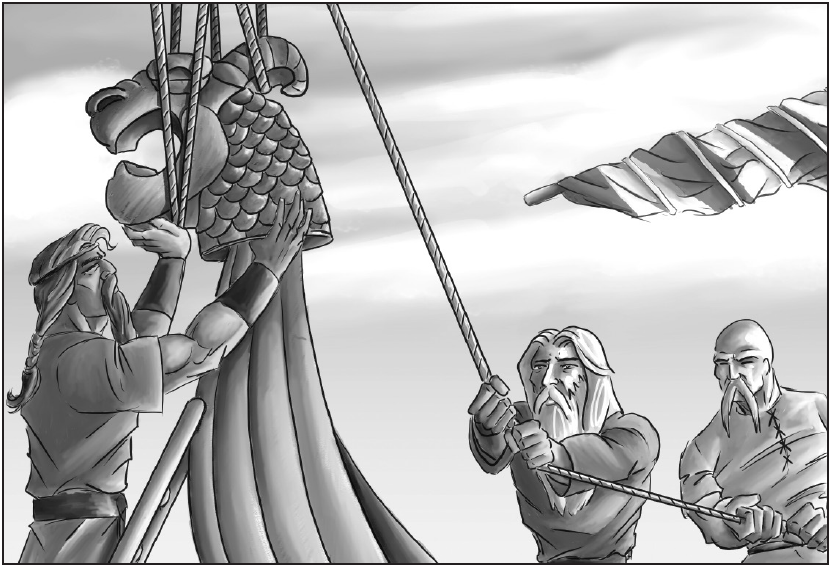
One of the western mountainous regions is Gatland, settled by the Gat clan who chose to settle here 300 years ago in protest of the Things which were rising up as a popular form of government. Here the Gat clan is ruled by autocratic jarls part of the extended family. The Gats get along like a heard of cats and even their eldest patriarch leads them informally. Gatland's spoil and terrain makes for poor farming, which caused the people here to become the best fishermen and sailors in the Northlands. In fact, there are many Gats who gave up farming completely to make a living as full-time merchants and vikings! The Gats are the sworn enemies of the Hrolfs, and their centuries-long feuds became such a fact of life that nobody recalls the real reason for its origin.
Hordaland is the relative center of the Northlanders and its most cosmopolitan. The town of Halfstead is the largest settlement in the Northlands, and the nominal Køenig is a 10-year-old boy whose father passed to illness last year. This has made for divisive politics, as there are some who feel that the former ruler's adult bastard son is a better choice while others insist the seat should be held by the boy and wait for him to come of age as the legitimate ruler. And the Gats and the Hrolfs both prize Hordaland's strategic center and seek to to bribe, manipulate, and threaten jarls into favorable deals. Most of the peninsula is heavily forested, but in the deep center is the Forest of Woe with an evil reputation of ruins, giants, and strange fey. There is also the Barrow Lands, a place home to the restless dead.
Home to the other powerful clan of the Northlands, Hrolfland is a different beast than the rest of the Northlands. For one, its ruler Jarl Magnus Hrolfsblood exerts a far tighter reign over the lands. There are no Things or Althing to contest his rules, and the local jarls are more or less subservient to his will. To more effectively fight the Gats, Jarl Magnus employed and built upon technological innovations from Southlander realms, including the building of the first castle in the region, siege engines, and even crossbows and even mounted cavalry. In a way, Hrolfland is approaching a more feudal form of government; too bad its ruler is Lawful Evil.
Nûkland is a region where Northlanders and humans in general are the minority. The evergreen forests and tundra stretch for an unknown length, and huge hardy animals such as mammoths, bears, and woolly rhinoceroses. Although not quick to go to war, the Nûk firmly stated to the Northlanders of Estenfird that encroachments into their domain will not be tolerated. The elves' strange home features a sole river somehow unfrozen which flows from unknown lands and Mount Helgastervän, which is said to be home to a dragon of enormous size known as the Great Serpent. Legend holds that further north, are World's Edge Mountains where beyond them is nothing but the void. Those who cross are said to be able to sail the stars to the domains of the gods.
Seagestreland is the other not-technically-Northlands-but-is place. It is a heavily forested region where even vikings tread lightly, and its only permanent settlement is the tiny trading post of Dnipirstead which acts as more or less a "gate town" to the rest of the region. In some cases Seagestrelanders come here as part of a trade moot, and sometimes merchants from even farther lands.
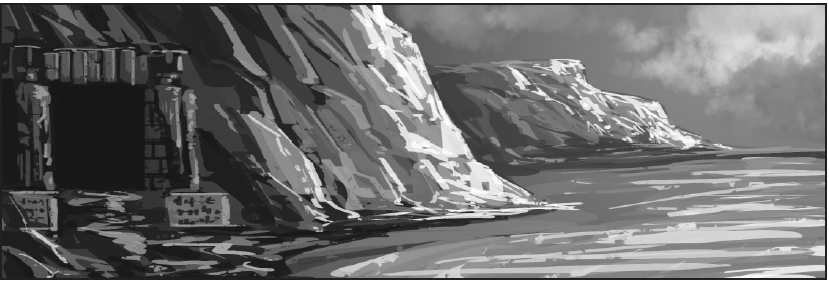
Storstrøm Vale is home to the oldest continuously-settled domains of the ethnic Northlanders. It may not be as technologically advanced as Hrolfland, nor have the trade advantages of Hordaland or the legendary sailors of Gatland, but what earns it universal respect is being the heart of Northlands history and culture. It is home to the Hall of the Hearth Stone, the most sacred godshouse of the Northlands, and it is here some of the greatest heroes have been buried. Politically the Vale is divided into various jarldoms governed by a Køenig whose position is determined by a vote at the Althing. The Althing meets once every 10 years, and is host to some of the most vicious politicking in the Northlands. Storstrøm Vale is also home to Trotheim, the only other town of significant size in the Northlands.
Last but not least is Vastavikland, a realm which breeds extra-tough people. It is home to the tallest mountains in the Northlands with just enough gold to make people desperate. Mount Reik is an active volcano which sees many mages come to it for sorcerous experiments, and just about every inch of land in the whole of Vastavikland is vulnerable to earthquakes. The people are warlike even by Northlander standards, with every Køenig and jarl's ascension the product of ritual combat, and just about everyone is encouraged to be a warrior. The Althing does not have much authority, given that most disputes are settled between individuals and families via duels and revenge-killings.
Topping off this chapter is a collection of places and things which make for good adventure material. Jomsburg Island is home to the Jomsvikings, an amoral band of mercenaries feared across the Northlands. The three lairs of the Daughters of Skuld are located across the Northlands, and heroes who earn their favor can receive great boons. The Tomb of High Køenig Kraki Haraldson, home to the man who united the entire Northlands under his banner, is said to hold the legendary sword which will make its wielder the next High Køenig of all the Northlands. We have miscellaneous hooks for Black Dragonships crewed by undead vikings, the Hearth Stone which is rumored to be the home of the first Northlanders who followed Swein Sigurdson into this new land, and lands beyond such as the Duchy of Monrovia whose mounted knights are a match for even the mightiest vikings.
And thus we end our bird's eye view of the Northlands.
Next up is Ansuz, the Gods!
Ansuz, the Gods
Original SA post
Chapter 3: Ansuz, the Gods
When it comes to day-to-day living, the Northlanders have a hands-off approach to worship. Religious issues come to the fore generally during feasts and festivals, or when beseeching blessings for a certain activity like invoking Donar's name before riding into battle. In a way worship is akin to a business transaction: make the proper sacrifices and the gods will do right by you. Many Northlanders make comparisons to their own social structures as a way of understanding: a spellcasting cleric serving their patron deity is like a huscarl serving a jarl.
Amusingly, a bit of in-universe bias slips out during discussion:
quote:
This is different from the situation in the Caliphate or Monrovia and the Southlands where one serves one’s gods as a thrall, bowing and scraping, and spending endless hours in worship and veneration. The Northlanders do not so much worship their deities as they carry out customs that have been occurring for centuries and that the mortal and divine find pleasing and beneficial.
There are times in the book where things read like the narrator is a very jingoistic Northlander, but this is far from the norm and it can feel confusing when objective narration suddenly becomes subjective. What’s even funnier is that in the rest of Frog God Games’ books, their setting is quite varied in gods and styles of worship.
The gods of the Northlands are separated into divisions of tribes. There are the Æsir, inhabitants of Asgard who are the principal deities of ethnic Northlanders; the Vanir, a more "worldly" pantheon who have strong connections to the natural world; the Ginnvaettir, inhabitants of the Ginnungagap and generic "evil gods;" and then there are foreign pantheons of deities worshiped by other cultures, which include demon cults and the Tibaz of the Seagestrelanders. Another thing to note is that the Northlands provides both the Germanic and Nordic names for deities but defaults to the Germanic version in regular conversation. One of the writers explained somewhere alone (I can’t recall the specific place) that this made the religions of the setting feel a bit more novel, but not so much to feel completely foreign.
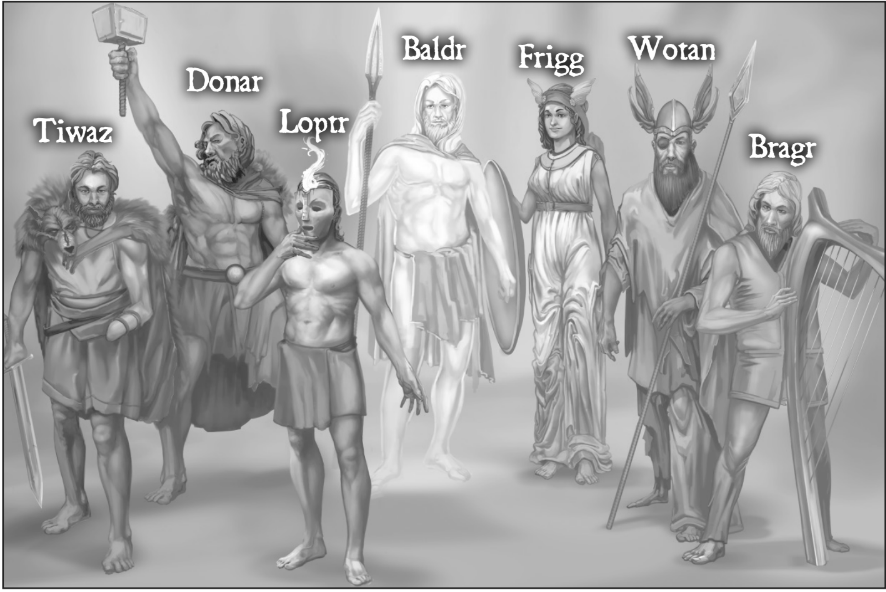
The Æsir are the highest of the gods to the Northlanders, and with the exception of Loptr/Loki they are all of good alignment.
Baldr/Balder is the God of Bravery and Beauty, and his domain of influence includes impressive feats of strength. Only men may worship him, although an exception is made for spear-maiden paladins.
Bragr/Bragi is the bard of the gods, a patron of music, poetry, and the arts.
quote:
Not a weakling milksop minstrel of the Southlands, Bragr and his devotees are warriors who stand in the shieldwall and urge their fellows on to victory, and after the battle lead the laments to the dead and songs of the glory of the day.
Hey I know that bards suck in 3rd Edition, but you don't have to rub it in their faces!
Donar/Thor is the most popular of the Æsir both in the setting and in real life. Due to being a patron of storms, many farmers worship him to ensure favorable weather, and as the patron of heroes he and his worshipers are renowned giant-slayers.
Frigg/Frigga is patron of women, home, and hearth. Although many cunning women make offerings to her for healing and renewal, she also covers battle when the home must be defended. Interestingly common clerical garb includes that of a spear-maiden, although she is not one of the patrons of that paladin archetype.
Loptr/Loki is the bad apple of the Æsir. Giant blood runs through his veins, and he hopes to one day unseat his father Wotan/Odin as the new All-Father. Although known for deception and malice, he's given prayer and offerings due to his dominion over fire (a necessity year-round in the cold lands).
Tiwaz/Tyr is the god of law and justice, and interestingly is widely worshiped in the Southlands due to being of the three principle deities of the Empire of Foedewaith (Lawful Good golden age civilization which fell). Tiwaz played a role in ending the Æsir-Vanir War, and he is often given sacrifice when one is about to participate in holmgang or deliver a case before a Thing.
Wotan/Odin is the head of the Æsir, a man of dual nature. He is known for wisdom, magic, and runes and thus wizards and scholars worship him. But with knowledge often comes madness, and thus he is the patron of berserkers, too. He learned the power of magic and the threads of fate by plucking out one of his own eyes and hung himself on Yggdrasil for eight days. His pet ravens Hugin and Mugin scour the world for secrets, and those who die honorably in battle are taken to his hall in Asgard. There they party hard and fight hard, both as reward for being on the right path in life and to prepare themselves for the age of Ragnarök.
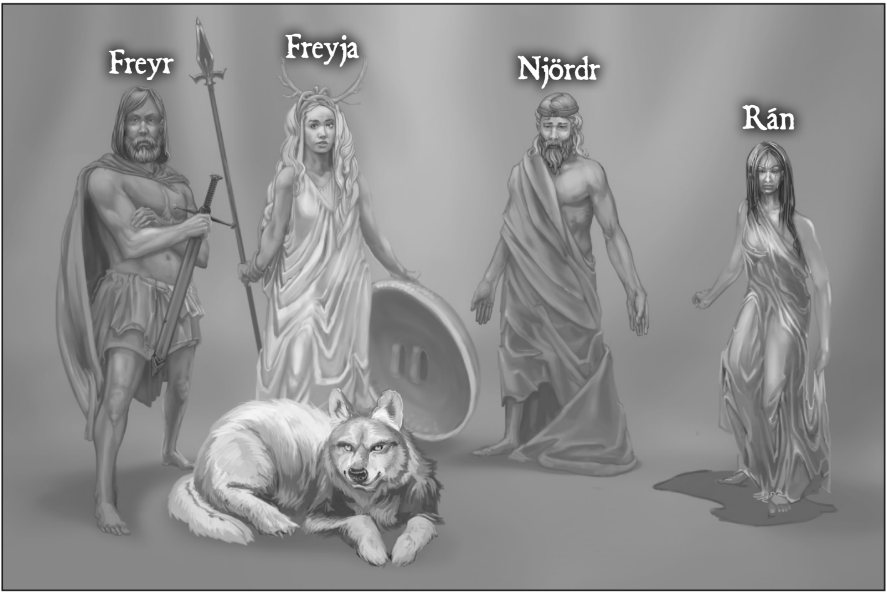
The Vanir were not always gods but were still powerful in those days. They warred against the Æsir long ago, but were uplifted by the latter at war’s end to share their divinity with them. Although it seems that they are less in number, there are many minor Vanir who hold dominion over things like a specific river, a tree, etc. Freyja and Freyr are the only good-aligned Vanir, with the rest of them neutral on the moral axis.
Freyja/Freya is is the patron of hunters, famers, and the wilderness, along with fertility and sexuality. Like Tiwaz/Tyr she is also well-known and worshiped in the Southlands. All valkyries serve her, tasked with combing the fields of battle for the souls of warriors.
Freyr/Frey is a male fertility god of the sun and the hunt. Tales claim he is also the patron of the elves (which the Nûk deny of course). He is not as popular an object of veneration as his sister Freyja, but there is a religious movement in Estenfird which claims him as the leader of the gods.
Njördr/Njor is is the father of Freyr and Freyja by his unnamed sister (!!!). Njördr oversees the oceans and seas of the world, and due to that he is closely associated with trade and wealth. Pretty much any Viking, sailor. or fishermen with common sense makes sacrifices to him for safe voyage by spilling a bit of wine overboard.
The Norns Uror, Verdandi, and Skuld (not pictured here) are the weavers of fate. They are not true Vanir and almost nobody worships them. They're still given great respect for controlling wyrd, the threads of fate which connect all mortals and gods. This results in a rather deterministic outlook on life: any event, good or bad, that falls on a person is believed fated by the Norns and thus unavoidable. Northlanders hope that the Norns favored them for future events, and have bitter resignation when their wyrd proves otherwise. Even the Æsir tread carefully around them.
Fun fact: one of the Norns' domains is Fate, which was published in a setting book also called the Northlands by Kobold Press. The Northlands of Kobold Press is much like this one in Nordic themes, although it and their their wider Midgard setting is a lot more high fantasy in style.
The last of the Vanir listed is Rán, also a deity of the sea. She is the more capricious counterpart to Njördr, and she has a more sinister reputation. Sailors lost at sea and in storms are known to throw treasure overboard as a sort of last-ditch "protection fee" to stay her wrath, and she is married to the Jötnar (giant) Ægir.
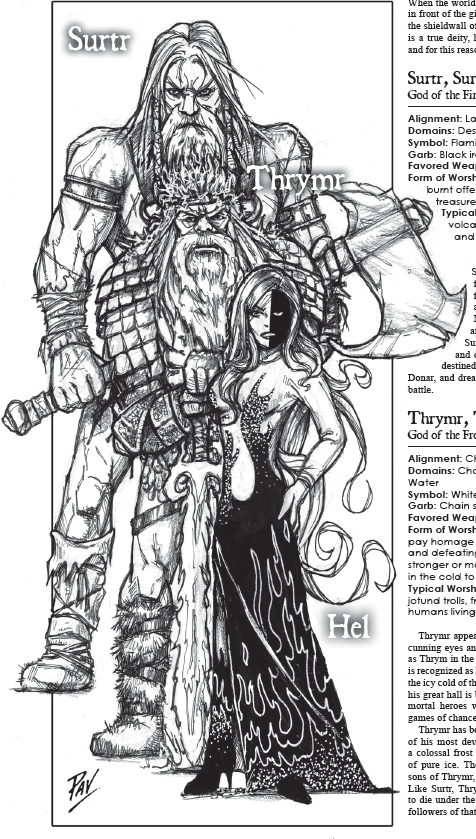
The Ginnvaettir are the third family of gods recognized by the Northlanders. They inhabit the Ginnungagap, a primordial void of endless darkness and howling which existed since before the creation of the world. Many foul beings haunt this realm, and as such the Ginnvaettir have a sinister reputation.
Hel is the daughter of Loptr/Loki, and holds dominion over pestilence and death; technically she is of the Æsir but is associated with the Ginnvaettir due to making her lair in the Ginnungagap. She was worshiped by the Northlanders' ancestors, the Heldring tribe. Precious few Northlanders today bother to seek her attention save to ward off blights and plagues. Interestingly she is a punisher of lawbreakers, and those who cast away their honor or worship demons have their souls taken to her hall in Niflheim to toil in punishment.
Surtr/Surter is the god of the fire giants. He rules a fiery kingdom of Muspelheim and is fond of organized warfare. He is destined to kill Freyr on the day of Ragnarök, but is scared of his inevitable battle against Donar.
Thrymr/Thrym is the god of the frost giants, a wily king of all Jötun. His realm is called Jötunheim and lives in a hall built from the bones of slain deities and mortal heroes. Like Surtr he and his followers are destined to die in battle with Donar on Ragnarök.
They don't have any pictures, but odd pantheon out are the Demon Cults. As far as I can tell via Google search the four demon lords listed below are not part of actual Norse mythology and more a creation of the game designers. Technically speaking demon cults are foreign to the world-view of Northlanders on account of their usual secrecy. But they are making forays into the more isolated regions of the world, with the four here the ones most prominent in the Northlands. Demon lords have a common desire to regress mortal civilizations to a primitive ruinous existence where murderous bands make bloody offerings to abyssal idols. Cities, bureaucracy, and morals are hindrances to this ideal.
Althunak is known as the Lord of Ice and Cold, Master of Cannibals, the Winter King, and many other titles. He once held a vast empire in the South Pole but that fell to ruin and so he found new worshipers in the far north. His teachings brought ruin to the cities of the Uln and even manifested physically among them, but a band of brave Ulnat heroes imprisoned him beneath a lake.
Althunak and his cult play a major role in four of the twelve adventures of the Northlands Saga Adventure Path, with 3 of those clustered around the beginning and one near the end. Besides the Jomsvikings his cult is the only other reoccurring villain in the Saga, so he's more or less the BBEG even if most adventures have stand-alone villains. The closest analogy I can think of is Batman vs. the Joker; his greatest foe, but the hero has an entire rogues' gallery to keep him occupied for a while.
Shibauroth are the dark counterpart to the Bearsarkers and Ulfhanders. Whereas the warriors of Wotan temper their rage with divine guidance and connections to mankind, the Beast Cult of Shibauroth advocates for humans to become as cruel as the natural world in a Social Darwinist survival-of-the-fittest. Cult members use magical brands and tattoos with fell powers at the expense of deteriorating rational thought. The god and his cult have greatest influence in Estenfird, and play a major role in the fourth adventure (sixth if we count the 'prequels') Blood on the Snow.
Yiv prefers a more subtle approach. Instead of overtly smashing the confines of law, honor, and the social bonds that connect society, he prefers treachery by encouraging others to lie, deceive, and take advantage of poor wordings, legal loopholes, and laymen ignorance and misinterpretation of the law. This way he exposes the hypocrisy of civilization and in time bring forth its ruin. He's had trouble making inroads into the Northlands, on account that many of its legal structures are localized and oaths are often a personal affair between individuals rather than a systemic law.
Zelton is the demon lord of sloth. In much of the world subsistence-based agriculture is the norm, which is labor-intensive for survival. Zelton's stock in trade is egoism and entitlement, telling his followers that each deserve to be a king with the world to serve them by right of birth regardless of their actual social station. His faith is sold as being an easy path to spells and slaves, with faith in the demon lord along with "doing a few small, insignificant tasks here and there" the only price. Zelton's presence in the North has been via the use of foreign traders using promises of an easier life free of toil. He also encourages his followers to propagate an infectious, addictive disease transferred via sweat known as Zelton's Favor which brings out feelings of euphoria along with the sapping of physical energy.
More Generalizing Jingoism posted:
In lands of the South, perfumed potentates are free to laze about all day while their minions do the work for them; but a Northlander jarl cannot. Should
he show himself to be lazy, his householders are free to leave, and his huscarls and hersirs can choose to swear allegiance to another jarl. Wealth is generally tied up in cattle and land, which require great effort to manage, and there are few luxuries to enjoy beyond good food and good company.
Note: A thing to keep in mind is that one of the major themes of the Lost Lands world is the rise of Chaos and the gradual downfall of civilization. The Lawful Good Empire of Foedewaith faced a devastating battle against the minions of Orcus, and in time their former lands turned into squabbling petty kingdoms. Many of Frog God Games' adventures involve cults setting up in the dark corners of the world and gradually taking over the smaller realms while working their way up to larger lands. This is a feature in the Northlands as well, and Althunak is more or less one of the major recurring villains for this reason.
The Gods of Seagestreland are as numerous as the tribes which worship them. Their deities are a mix of adopted Northlander gods (who rarely give any spells to them) and their own set of gods. Seagestrelanders carve likenesses of their patrons called tibaz and place them in hallowed-out tree trunks. These are the greatest assets of a tribe; to destroy or steal a set of tibaz is akin to destroying their gods and considered the omen of a tribe's eventual death. There are a few common deities worshiped by many tribes: Torriuz is considered the father of the gods and he considers all Seagestrelanders his charges. His first wife Eldraz blesses home and hearth, while his second wife Kelipia is a mad huntress who holds dominion over the natural world. Mettol is Torriuz's eldest son who oversees war and death, and Zithal the Stranger is a mysterious god of treachery and deceit. The Dnipir River is worshiped as a Great Mother, while Halatra the Horse and Fatalik the eagle are animal deities and lord of their respective species. Ghaztriuz is a sea god and in some coastal tribes replaces Torriuz as the pantheon's head.
As a final entry we get more discussion of the Godi, repeating information from previous chapters while adding new things: first, we learn that the title is often passed from parent to child. Godi also recognize the existence of but do not pay homage to foreign deities. In game terms all godi have levels in a divine spellcasting class but most of them do not gain access to supernatural class features and spells. PC and spellcasting godi are remarkable individuals chosen for great deeds; in a few rare cases a god may grant a non-spellcasting godi the full features of a divine spellcasting class in times of dire need.
And so our chapter ends. There's a good amount of diversity in options for spellcasting clerics, although the individual pantheons are highly themed: Æsir are mostly good and warrior-like, the Vanir govern natural forces, and the Ginvaettir and Demon Cults are the bad guy groups. I found it interesting how the Northlands reflavored the "one deity, one cleric" thing into an individual pact with a god that matches the pseudo-business transaction nature of worship quite well. This chapter was a bit more jingoistic than I liked, but otherwise is fine. I get that the point is to make the Northlands HARD AND TOUGH but the writer needs to stick to a single narration style for consistency's sake.
Next up is Chapter 4: Fehu, A Wealth of Cattle (Optional Rules)!
Fehu, a Wealth of Cattle (Optional Rules) Part 1
Original SA postTendales posted:
Kind of a petty thing, but it always bugs me when Loki is presented as Odin's son.
As somebody who isn't exactly caught up on Norse mythology, what's the real sitch? I looked on Wikipedia where the Prose Edda mentions his father to be the giant Fárbauti and his mother Laufey. Is this an accepted standard, or are there multiple views of his parentage?
Also I seem to be having trouble with making large posts on SA so I am splitting up the next section in two

Chapter 4: Fehu, a Wealth of Cattle (Optional Rules) Part 1
This chapter is an assortment of optional rules, new equipment and class archetypes, setting-appropriate traits, and similar options to make a more authentic-feeling Fantasy Nordic game.
The first section discusses Rewards, discouraging the use of planting treasure in random monster hoards and instead place in the hands of significant enemies or given away as great prizes by jarls and people of note. Additionally, not all goods will be in coin but also ships, cattle, jewelry, and other such things. Funny enough, this alternate advice is abandoned during the Northlands Saga Adventure Path, where it's not uncommon to find treasure in abundance from giants to raiders.
The Northlands does not have a universal monetary system of coinage. Instead most trade is conducted with the use of hacksilver, ranging from precious metals and jewelry to coinage, arm-rings and bars made of precious metals. 1 hacksilver as an abstract wealth unit equals 1 gold piece, with silver and copper pieces assumed to be smaller bits.
The tradition of Ring Giving emulates the heroes of Nordic sagas, who were eager to share the bounty of their adventures with their allies and inferiors. The term comes from the tradition of jarls who bore silver and gold rings upon their arms which were given away as gifts. Basically for every 10 gold pieces/hacksilver worth of wealth they give to their followers, PCs receive 1 experience point. The gift-giving is recommended to be limited to once per lunar month, and given the lack of magic item marts it gives PCs another means of spending wealth and dispensing of old +1 weapons and armor. But given the scaling of experience even a 20,000 GP item is worth 2,000 experience; if divided among a party of 4 that does not amount to much. I presume the experience points are meant to be individually applied, in which case it would be marginally more useful.
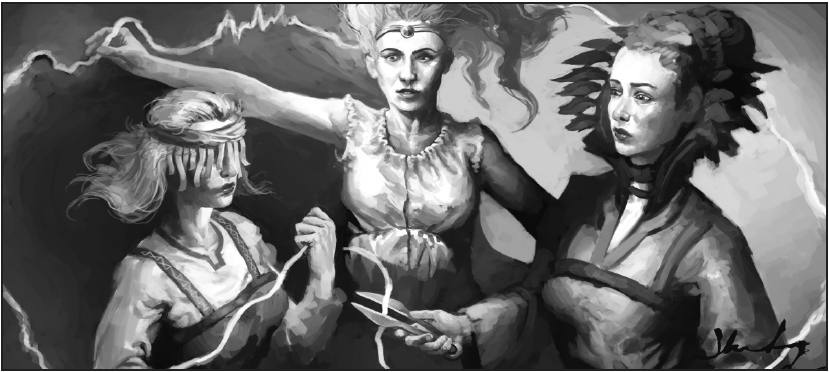
Death and Dying provides alternate means of making one's games more heroic than just keeling over. The first is the Death Speech, where if a PC or important NPC would ordinarily die they spend a free action to regain consciousness and either 1.) gain a standard action to complete one last task before death, 2.) make a poetic speech summing up their lives and deeds which grants an XP bonus or free magic item to that player's next PC on the quality of the speech, or 3.) lay a curse upon a foe as bestow curse or a lesser geas on a willing ally.
Alternatively once per campaign a player may declare their PC to become a Victim of Fate, a decision marking an heroic end for them. The effect is much like a death speech above (minus curse-giving abilities), but grants a +20 bonus on attack rolls, skill checks, and double damage on every attack they make for the remainder of combat. But the PC suffers a -10 penalty to Armor Class, saving throws, and cannot benefit from healing of any kind. After the battle's end the PC may utter one short sentence before dying. No form of magic or intervention of a deity may bring the PC back to life, as their thread of fate has been cut by the Norns.
We next get an in-depth description of the proceeds of a Thing, which for many Northlanders represents a great battle but one not always fought with axe and spell. Things are part democratic assembly, part court of law, and part trade moot. It can serve a variety of roles in a campaign from a "state fair" style avenue for fun and games, a legal drama, or means of gaining power by directing the course of a community. For votes, the GM determines the likely "factions" and how they'd vote on an issue, and PCs and NPCs can attempt to give speeches during half-day increments to sway votes. The result of a speech's effectiveness is usually done via an appropriate social skill check. Social standing plays a role, where a jarl or wealthy hirdman's vote counts as multiple votes whereas thralls cannot vote at all. Additionally, a speech-giver who has done a multitude of heroic deeds can provide proof at the Thing to gain bonus votes in addition to that gained via the result of a skill check's result.
Finally, a person can gain votes via participating in a duel known as holmgang. Holmgang is a one-on-one duel between a pair of hazel posts in front of a public crowd. The rules are strict and highly formalized: first no magic of any kind is allowed to be used save that present in chosen weapons and armor. Both duelists fight with their choice of a melee weapon and three shields, and both weapon and shield must be used in the duel. The conditions for winning are to either kill the opponent, break all 3 of an opponent's shields, or drives the opponent out of the arena. Killing the leader of a faction gives half their votes over to the winner, while the other half will not vote and likely seek vengeance against the winner after the Thing's conclusion.
Although the concept of a holmgang is very cool (and will be present in the climax of one of the AP's adventures), it is a bit limiting for involving PCs. For one, the nature of the duel means that one player will be involved while the rest of the group sits and watches which may not be to everyone's tastes. Secondly, only a few character classes and styles are truly effective, and sword-and-board fighting is not exactly a mechanically strong option in Pathfinder.
New Character Options
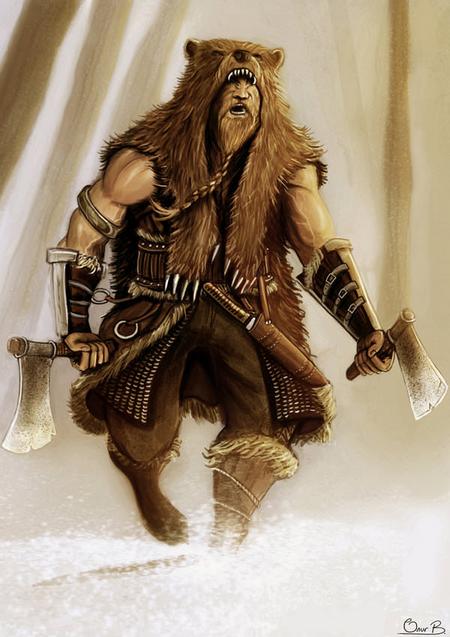
By bakarov of deviantart
Chapter 4 includes six class archetypes, 19 traits, and 7 new feats. We'll start with archetypes.
The Bearsarker (and later the Ulfhander) is more or less intended to be a replacement of the typical Pathfinder Barbarian class. It was one of the things Frog God Games (reason #2) used for advertising its Kickstarter to show off the setting. Basically the Bearsarker is part of a warrior cult who pledged themselves to Wotan and engage in ritual drunkenness and various secret rituals. They do not bathe, can only wear a bear robe and loincloth, and never cut their hair. They can be of any non-evil alignment, but are saddled with a code of conduct to keep their class features.
Bearsarkers use their Wisdom to determine the duration of their rage and can grow claws during the rage which add both their Strength and Wisdom modifiers to damage. To make up for lack of armor they gain a dodge bonus to AC which increases with level. And they have a no-action line of sight shaken condition to those who see them raging. Overall bearsarkers are a bit specialized and initially more fragile than typical Barbarians, but at later levels the dodge bonus works out. It can be an effective archetype if you plan the right builds (natural weapons, shaken/fear builds, etc).
The other Barbarian archetype is the Ulfhander, berserkers who venerate Wotan's aspect as the master of beasts. Via the wearing of a wolfskin cloak (taken from the body of a wolf they killed barehanded) they can take the shape of these hounds. They are also part of their own religious order. They use Wisdom for rage much like the Bearsarker, and start play with a wolfskin cloak that cannot be worn with armor but grants increasing Damage Reduction (1/- at 1st level and +1 at 3rd and every 3 levels). They can also gain multiple wolf animal companions (every 4 levels, max amount equal to Charisma modifier) and transform into a wolf via a limited wildshape ability.
Besides potential action economy abuse with animal companions, the Ulfhander isn't very powerful. Their inability to wear armor (and no dodge bonus to make up for it) makes their wolf-skin cloak an inferior choice. The multiple wolf companions are limited by Charisma, which makes the Barbarian MAD and reliant upon a dump stat. The wolf wildshape can be good for tripping, but can't they at least get a dire wolf option at later levels? Personally I'd make the wolfskin cloak grant the benefits of hide armor in addition to Damage Reduction and make the animal companion limit by solely level-based and not Charisma.
The Skald (not the same as the Pathfinder Advanced Class Guide Skald) are respected warrior-poets who prefer to rely on strength at arms over arcane powers. They swap their typical weapon proficiences for more Viking-style gear (battleaxe, longsword, handaxe, short sword plus simple weapons), and in lieu of Inspire Competence they gain a bardic performance to grant allied listeners Shield Wall, Great Fortitude, and Swap Places as bonus feats. Instead of spells they gain bonus combat feats at 1st level, 4th, and every 3 levels up to 16th level.
This archetype is underpowered. One, losing magic is a huge downgrade, and the bonus feats given via bardic music are useful only for sword and board fighters whereas Inspire Competence is useful for just about any role.
The Huscarl is a fighter pledged to the service of a jarl and their family. Not just bodyguards, they are trusted people the jarl can turn to for problems of all kinds. Huscarls must be of lawful alignment and cannot wed while serving a household. They gain armor training and weapon training class features at later levels than usual, but they gain a multitude of bonus feats which trigger based on situations. Center of the Wall grants them the use of several teamwork-related shield feats (Shield Wall, Shielded Caster, Swap Places, and Shieldwall Breaker and Swine's Head found in this book) even if none of their allies have the feats; but the huscarl has to pay feat slots for them and do not get them for free. Loyal Unto Death grants the Bodyguard and In Harm's Way feats for the duration of combat whenever their jarl, the jarl's family, or other sworn companions are placed in danger.
Overall the Huscarl is an archetype for a rather underpowered class, and taking it won't significantly alter the class' power one way or another on its own. The bodyguard/in harm's way feats can be useful for tanking purposes, but would require a kind of family-centric campaign to work regularly. The Adventure Path has the PCs start out as huscarls for a jarl, but they don't adventure with him and the usefulness of his family in the plot more or less vanishes after the third adventure.
Spear-Maidens are the Northlands' only order of home-grown paladins. They follow a code to never wed, never lie with a man, and never surrender in battle as long as they remain a spear-maiden. They must take Baldr, Donar, or Wotan as a patron deity, but they do not gain their supernatural abilities from the gods but from the blessings of their wyrd. Spear-maidens trade out lay on hands, mercies, spells, and divine bond for increased mastery of the spear (Weapon Focus, treat as trip weapon, and bonus on Combat Maneuver checks with it), bonus combat feats, the Shield Wall feat for free, bonuses on attack and damage rolls when using a shield, and the Swine's Head as a bonus feat along with doubling critical threat range and ignoring AC penalties when using this feat while charging.
Personally, the loss of lay on hands and spells is a downgrade in utility. I suppose that bonuses on damage when wielding shields and charging can be nice, but I don't think that can make up for the use of a warhorse or ability to apply magical weapon enhancements on the fly.
Finally we have the Cunning Woman Sorcerer Bloodline, which is not an archetype so much as an additional bloodline a standard sorcerer can choose. They are the only arcane tradition in the Northlands that's really respected on account that they gain use of powerful healing magic. Cunning women are always female, but require a sexual relationship with a man to propagate their bloodline. However, they cannot marry so bonds they form with said men often have all the markings of marriage save official recognition and ceremony. Cunning Women gain Heal as a class skill and a slew of curative magic as bonus spells (cure x wounds, remove disease/poison, restoration, etc). Their bloodline arcana allows them to apply the Maximize Spell metamagic feat without increasing the spell's level a limited number of times per day. Their bloodline powers include an evil eye ranged touch attack, the ability to take 10 on Heal checks and don't need a healer's kit, the woodland stride and trackless step abilities of druids, the ability to reroll a failed d20 roll once per day, and their 20th level capstone changes them into a fey immune to poison and disease and can reincarnate as a fey creature or newborn child upon their death.
The Cunning Women makes for an effective hybrid caster. They are sorcerers and gain access to all the versatility of those spells, but free Maximize on healing spells (which they can learn many for free) make them good healers.
Fehu, a Wealth of Cattle (Optional Rules) Part 2
Original SA post
Chapter 4: Fehu, a Wealth of Cattle (Optional Rules) Part 2
There's not much to say for the new Traits. Many of them reflect setting-specific backgrounds of varying power. Some of which stand out include Hnefatafl Player (Nordic board game) that grants a +1 on initiative due to a tactical mind, and most of the social traits reflect social classes of the setting and often give bonus equipment for free. In the case of Bondi and Hirdmen (farmers) they get land which generates an annual income. The Social traits vary widely in power; the meager Thrall gains +1 to Craft (any) and Profession (Servant) and can elect one of the 2 to be a class skill...save that these are class skills for just about every Pathfinder class! Heir (child of a jarl) grants you +10 votes at the Thing, an extra 300 hacksilver, a chain shirt, a heavy wooden shield, a personal hand weapon of choice, and clothing befitting your station...all for free! The Regional Traits borrow from 7 out of the 8 main regions in the setting (Nûkland not being an option) and generally give +1 to relevant skill bonuses based on common occupations. Hroflander grants you bonus proficiency in one martial or exotic weapon not normally found in the Northlands, but you can't start play with one.
There are seven new Feats, and 5 of them are combat-focused. Axe Bouncer allows you to take a penalty with a throwing axe to negate an enemy's shield bonus to AC (yawn). Northlander Spear Fighting allows you to wield a longspear one-handed and +1 additional shield bonus to armor class when wielding a shield in the other hand (good for potential builds and Piercing Thunder in Path of War Expanded). Shieldwall Breaker allows you to negate the shield bonus to AC of adjacent targets when you perform a successful bull rush or charge attack against someone part of a shieldwall. Skilled Kenninger is overpowered and lets you add half your ranks in Perform (Oratory) to the DC of your bardic music effects. Swine's Head allows you to enjoy the benefits of the Shield Wall feat even when you run or charge. Throwing Charge allows you to make a ranged attack with a thrown weapon at any point during a charge at a -4 penalty. Whale Road Rider lets you ignore your level in armor check penalties when swimming.
Personally, the shield AC negaters are of limited use in most campaigns. Most enemies in the Pathfinder Bestiaries do not make use of shields, and sadly the Northlands Saga Adventure Path does not have shieldwalls as a regular enough enemy feature to make their investment worth it.
New Equipment
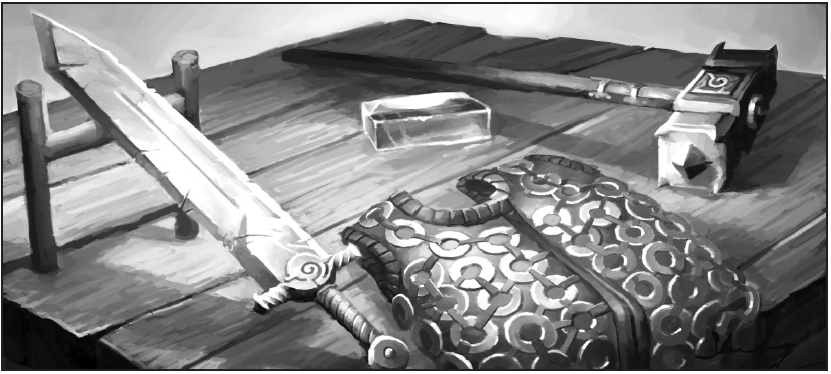
Here we cover new equipment both mundane and magical. We start out with giant-made weapons and armor, which are often crude and inferior craftsmanship but more than made up for their wielder's inherent strength. They have hefty prerequisites (18 Strength to avoid -4 attack penalty or automatic heavy encumbrance) and generally aren't worth using. The ring shirt and mail are medium armor and only give +3/+4 AC bonus which studded leather and chain shirts can match as light armor. The heavy sword is a bit better, a one-handed melee weapon that deals 1d10 damage and x3 on a critical, and can do bludgeoning as well as slashing damage. For non-giant weapons we have a new exotic one, the Greathammer which is basically an even bigger warhammer (two-handed, 1d10 damage and x3 critical).
For non-warfare equipment we have sunstones used by sailors (compasses don't exist in the Northlands) to pinpoint the direction of the sun even in the foggiest of weather, while the special breed of Trondheim Ponies are rugged mares suited to mountain travel. Mechanics-wise they are the Pony monster with the Advanced template.
For new magic items we have no generic item properties: each entry here is a specific relic of legend even if not mechanically an Artifact. We have the Regalia of Gunnlaugr, a set of chainmail, helmet, and maul which have cold-themed abilities; the sword Fellfrost* (once wielded by Hvram Half-Born) that deals cold damage normally but fire vs enemies weak to that element; the Andøvan greatsword Hægtesse which fills its wielder with a rage-like fury; the mithral greathammer Thundersurge which is basically a lesser Mjölnir (hammer of Thor); the undead scourge Warspear of Kein wielded by a famed Bearsarker of the weapon's namesake; and an Andøvan Barrow Charm which grants safe passage among the undead that live among that forgotten civilization's burial sites.
For true Artifacts, we have Kroenarck (aka Icemelter), the sword wielded by the Northlands' last High Køenig which is a +6 cold iron keen called giant bane longsword capable of granting enthrall and mass suggestion when in the hands of a native Northlander. The Mead of Poetry is brewed by the dwarves from the spittle of gods, and those who drink it gain 6 points of Intelligence and Charisma along with 3 levels in the bard (skald) class or the Skald from Pathfinder's Advanced Class Guide. Finally, there is the sailing ship Skíðblaðnir built by dwarves as a gift to Freyr. It has hidden joints so it can fold up into a much smaller size capable of fitting in one's pocket, whose rowing oars can row themselves, and grants the ship's master a shipwide endure elements spell along with control water, control weather, or control winds spells at will all as standard actions.
*our party's trollkin barbarian/rogue has been using this sword as his main weapon of choice since we laid hands on it in the Adventure Path.
Overall this chapter is mixed. The death speech rules are awesome and hacksilver is an thematic alternate wealth unit. But the new archetypes and feats left me less than impressed. The magic items are a definite highlight and have unique abilities to make them stand out from more generic treasures.
Next up is Chapter 5: Þurisaz, New Monsters!
Þurisaz, New Monsters
Original SA post
Chapter 5: Þurisaz, New Monsters
The chapter states that the Northlands is full of all sorts of monsters, and that many from the Pathfinder Bestiaries and Tome of Horrors Complete make sense with some caveats. First off, they should fit the environment: a monster that needs to lair in intense flames isn't going to be hanging out in the forests of Estenfird, but may be more suitable when the PCs explore Mount Reik. Monsters imported should not be too magic-centric or overtly reliant on supernatural powers, given that Northlands is intended to be overall low-magic in tone. Finally, monsters which are keyed too close to mythologies outside the Nordic source material may not gel with the themes.
The Adventure Path proper more or less sticks by this, with one exception. They're totally willing to borrow from non-Norse mythology in a few places. One encounter in Beyond the Wailing Mountains involves a Yuki-Onna albeit reflavored as a vengeful Ulnat spirit, we see a wendigo and a manitou in the later adventures (both from Native American folklore). The Broken Shieldwall has an Egyptian-style necropolis guardian and karkadanns (rhino-like being with a magical horn). In some cases it seems rather arbitrary, although the final example makes a bit of sense given the adventure's location.
Before new monsters are introduced, we get discussion for an optional subtype, the Sceadugengan (or "shadow walkers"). Less a true variety of monster than a superstitious cultural association with unknown creatures, they are "horrors without a face that haunt the cold and darkness of the North." More known monsters such as giants, dragons, and merely larger versions of mundane animals do not count; they can be frightening sure, but they don't have that otherworldly unknowable horror. Generally speaking, Aberrations, Fey, Magical Beasts, Monstrous Humanoids, and Undead are all universally Sceadugengan plus a much larger list of subtypes. In mechanics terms, sceadugengan monsters force a Will save that imposes the Shaken condition on somebody from a culture in the campaign setting (includes dwarves and Ulnat as well as the people of the 8 regions). Although the save is only done on "first meetings" and not every encounter, it is in practice rather cumbersome and may feel odd if your valiant fantasy Vikings are getting scared all the time. Although the early parts of the Adventure Path have mostly human and "low fantasy" enemies to make such a subtype rare, it is not something I bothered with when running the campaign.
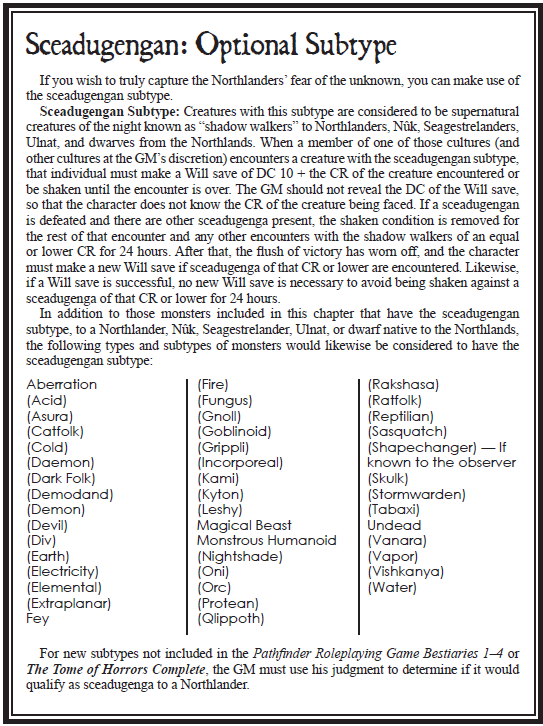
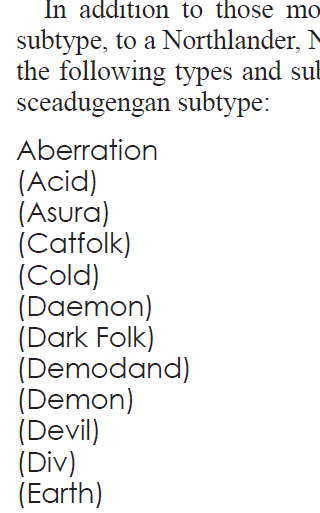


New Monsters
We have 18 new monsters, 21 if we count the subtypes of beavers and trolls and they tend to be on the lower scale of power. Every monster here has an accompanying picture, but I'm only going to share a few of them. The chapter notes that every entry here is drawn from Germanic and Nordic legends.
First up is the Ajatar (CR 9), a giant evil furred serpent which can change into the form of a beautiful woman to lure men into traps and eat them. They have a hypnotism power along with typical giant snake stuff (cosntrict, poison, climb speed).
The Northlands Aurochs (CR 7) or Dire Kine are elephant-sized prehistoric cattle on the verge of extinction. Their horns are prized trophies and more than a few foreigners prized them to use in bullfighting arenas albeit with a heavy cost to the participating matadors.
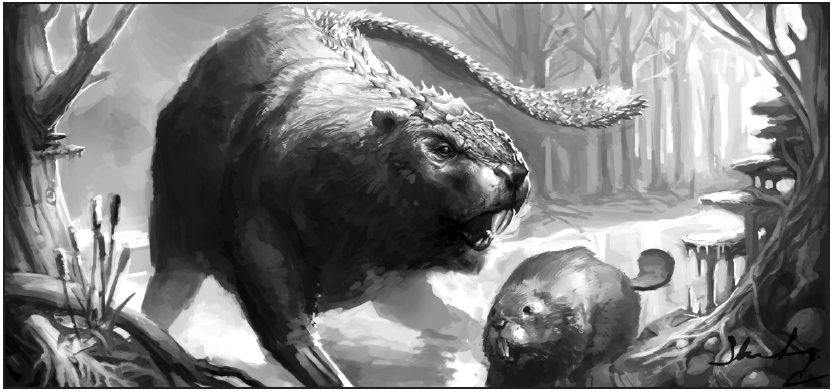
Beavers (CR 1/3rd, 1, & 7) are exactly what you think. They come in larger varieties such as the Dire Beaver (size of a person) and the Giant Beaver (size of a horse). Their bite attacks can ignore a certain amount of Hardness of wooden objects.
Blood Eagles (CR 10) are powerful undead named after a now-banned form of execution. A "blood eagle" is where a person's ribs are cracked and pulled out the back to simulate a pair of bony wings, and then the internal organs are pulled out through the back and sometimes salted to cause additional pain. Those executed in this manner consigned the victim to the realm of Hel rather than Valhalla, as it was considered a coward's death. The desperate fear this generates results in a 10% chance of the executed arising as a Blood Eagle, even more if an undead creation spell is used as part of the slaying. As a result the practice became banned in the modern era of the setting. Blood Eagles tend to be single-minded, seeking death and destruction against those whose souls who still have their honor intact as well as the people responsible for its execution.
Oddly enough, there is not much comprehensive discussion on the real-world Nordic practice as to whether it actually happened, was a literary invention, and the specifics of its practice: was it used liberally or for only certain types of criminals? Some sources claim that if a person does not scream out in pain during the execution it is taken as a sign of valiance and the deceased is guaranteed an honorable spot in the afterlife.
Bog Hags (CR 8) are the undead remnants of Andøvan human sacrifices drowned in bogs. They hate all life and are particularly feared for their ability to drive people insane or shift one's wyrd for the worse with but a touch. They also have a respectable array of spell-like abilities. On the anniversary of their murder they can leave their swampy prison, accompanied by Bog Horses and Bog Hounds to ride through the countryside on a campaign of terror.
Bog Horses (CR 3) look like mold and fungus-covered horses which are servants of Bog Hags. These animals were also sacrifices of the Andøvans. They have sharp fangs for biting and can swim as fast as they can run.
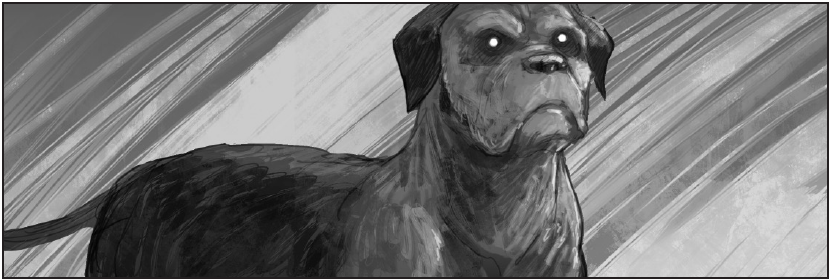
Bog Hounds (CR 4) are the other animal servants of bog hags. They are loyal servants of the hags and their howls can strike magical fear into others.
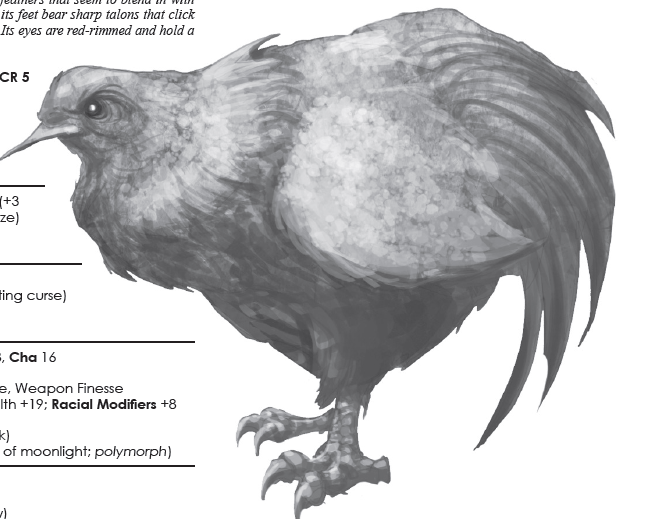
An Erdhenne (CR 5) is a rare sapient monster which can take the form of a pool of moonlight or a rotting hen. Their peck carries with it a wasting curse, and those killed have their souls devoured and turned into eggs of pure gold and silver which the monster lays. They typically haunt houses, their only telltale sign clucking sounds at midnight.
I get the intent of the horror of a seemingly harmless domesticated animal hiding among farmers, but after Terry Goodkind's infamously cheesy evil chicken incident I don't think most gaming groups will be able to take such a monster seriously.
Common Giants (CR 5) are the most frequently encountered Jötnar in the Northlands. Stronger than ogres but weaker than hill giants, they are believed to the the race least blessed by the foul magics of their kind. Some claim that stronger giants evolved from their kind and the remnants are a stunted throwback. Common giants live in groups and practice a polygamous lifestyle, where having a large amount of "brood-wives" is a sign of status. Male common giants of lower status often band together with their peers or find ogres to bully and take as servants.
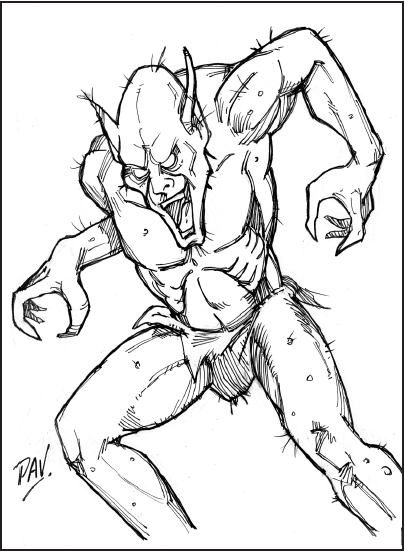
Grendel (CR 12) is one of the more powerful new monsters in this chapter. There are more than one but thankfully are rare. They were former humans whose souls were consigned to the Ginnungagap but managed to claw their way back to Midgard via the aid of spirits possessing their host bodies. A grendel is large and incredibly strong, along with the ability to perfectly mimic the voice of any person it kills (but no shapeshifting ability). They often come into a community and slaughter all who resist, establishing a local tyranny to extort ridiculous sums of tribute and the occasional human sacrifice from the subjected populace. They become more powerful the more people they eat (this is not a game mechanic, more a bit of fluff text).
Grimmswine (CR 5) are the progeny of Sæhrimnir, a divine boar in Valhalla whose flesh regrows after each feast. The grimmswine are the children one of the many mortal boars it mated with throughout the Northlands. Gwimmswine are particularly-prized catches for their reputation, but are quite intelligent (INT 12) and their fur is full of razor-sharp bristles for defense. Although a magical beast, it is not a sceadugengan on account of its place in myth and folklore.
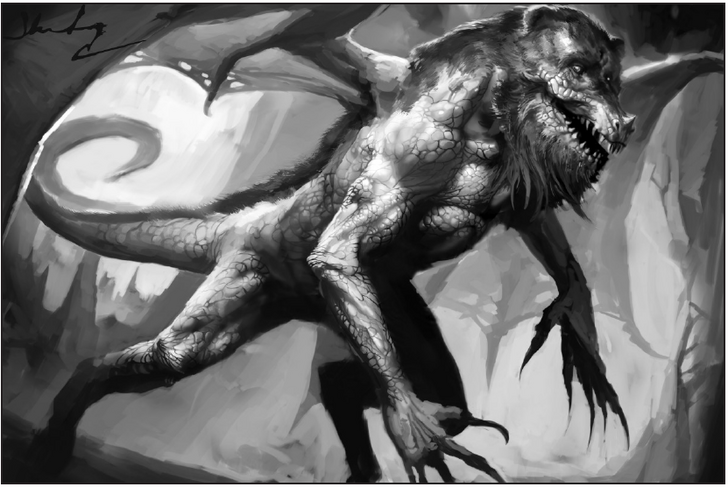
The Jomsbeast (CR 13) is the most powerful of the new monsters and a unique species in its own right. It lives on the island of Jomsburg, with an uneasy peace existing between it and the Jomsvikings. It has the physical features of a man, bear, and dragon. It is virtually immortal, coming back to life, even if disintegrated, as long as the enchanted spring in its lair remains tainted. There are mechanics included for how to dilute this (raising/changing the water level, using holy magic, etc) which gets past its fast healing ability and deals automatic damage.
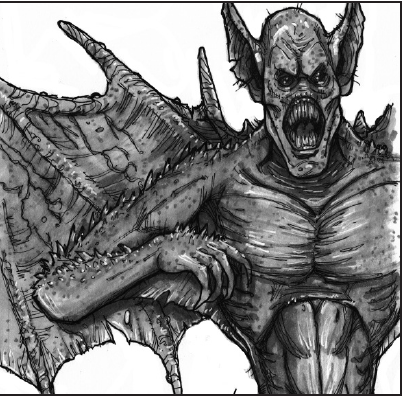
Nachtjägers CR 2) or "night hunters" are flying monstrous humanoids who are fond of burning villages and swooping off with captives to kill and eat. They can cast produce flame as a spell-like ability and come equipped with shortbows, but besides their flight speed do not have any other significant abilities.
A Swarm of Degenerate Mephits (CR 3) are created when small populations of these elemental beings are cut off from the rest of their kind and devolve into barbarity. They are little better than beasts, swarming over and attacking all others for sustenance.
Thrydreg (CR 3) are the generations-long result of the unions of trolls and captive humans. They are less powerful than normal trolls but are smarter. They used to control almost all the known Northlands until the newly-arrived Northlander/Heldring humans fought them off.
There is another species of thrydreg known as...sigh Skraelings. They are the result of humans and trow (detailed later) who live far off to the east in the mythical Oestryn Isles. They are amphibious and Chaotic Neutral rather than evil alignment, and in one of the later adventures in the AP have explicit Native American cultural trappings.
I'm just going to note that the term "Skraeling" was a word Scandinavian vikings used to describe indigenous Americans encountered in Greenland and what is today eastern Canada. Although not of evil alignment, there is a host of problematic tropes when real-world ethnic groups, especially ones viewed as primitive/savage/etc, are cast into the role of orcs, goblins, and the like. I'll just leave a link to my blog post on why this is not a good idea than getting into it any further.
Trow (CR 6) are a race of Jötnar who emerged from the primordial seas. They cling to shallow coasts and deep lakes, using natural camouflage to kill and drown people for sport and sometimes to eat. Mechanics-wise they are very similar to standard trolls, save with a swim speed, are stronger (STR and CON 25) but dumber (INT and CHA 4).
Vlkodlak (CR 4) are Bearsarkers and Ulfhanders who cared only for the animalistic power of their cults without the mediating influence of moral codes. In their pursuit of power they became permanently trapped in a man-animal hybrid form powered by an endless rage. They are strong monstrous humanoids who have an innate barbarian rage along with the ability to access rage powers based on how much hit dice they have. They have Damage Reduction which can only be penetrated by holy weapons, lending credence to the belief that weapons made by the gods are the only hope of killing one. Some, but not all, have cast their lot in with the Beast Cult of Shibauroth.
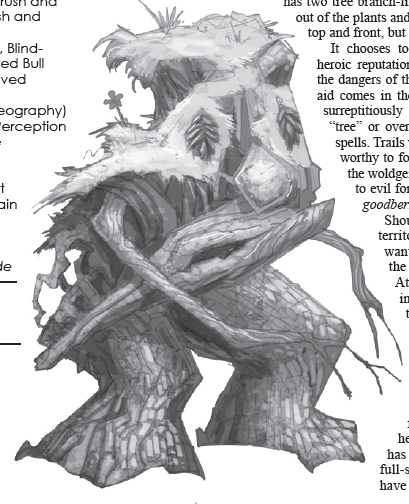
Our final monster is the Woldgeist (CR 9), a good-aligned fey (but still a sceadugengan) which is a rare creature that inhabits the Forest of Woe in Hordaland. It may be the only one of its kind in existence, and it is a friendly creature which subtly aids the innocent and those of heroic reputations. It is capable of disguising itself as an overgrown boulder, and sometimes places itself in the path of travelers to secretly deliver a beneficial touch spell to them. They are only really violent against those who are evil and needlessly destroy the natural world. It has a host of druidic spell-like abilities and summoning to aid its cause, and it has ties with allied fey and humans indebted to it.
[CENTER]Random Encounter Tables in the Northlands[/CENTER]
So far we covered 80 pages of this 807 page doorstopper. The random encounter tables cover an additional 90. The reason for its length is that the specifics of special encounters are repeated for every region, artificially expanding the length. The tables cover just about every region of significance in the Northlands, along with an in-depth description of more special encounters. I do not feel that it's warranted to cover them all save perhaps for a few of the more interesting ones. The regions vary widely in the possible challenges, in some have separate tables based on the season (usually summer/winter), and use a 1d100 percentage die roll to determine the results. Some regions, like the Bloody Pass in Estenfird's winter, can range in encounters from a herd of CR 1/2 to 2 mundane animals to a game-ending CR 17 wendigo or CR 20 tor linnorm, but enerally speaking the majority of encounters hew to the lower end of the spectrum (CR 1/3 to 9). Generally speaking only the 90s and above on the 1d100 approach high levels. The Adventure Path proper uses the actual tables sparingly, often going with its own localized tables in line with the average party level.
Some of the more interesting encounters include a drunken hunting party who ask the PCs if they'd like to engage in a friendly competition to hunt an animal, along with rough pranks by the other hunters which can cause non-lethal damage; landholders who may invite the party to dinner if there is a skald among their group or the PCs are famous heroes; destitute travelers who if the PCs help may show up later to pledge themselves as loyal householders if one or more PCs become jarls (which can happen in the AP); a freak ice storm which is supernaturally dangerous and cold if the PCs angered Althunak during the Adventure Path; a scientific expedition of Southlanders searching for the magnetic pole of the world of Lloegyr, the planet of the campaign setting; a Nûk hunter on a spiritual quest who is aided by an earth elemental; a Southlander warship on the hunt for Jomsvikings and pirates; and a strangely welcoming village in Vastavikland whose inhabitants plan to rob the PCs while they sleep at night.
In conclusion the new monsters are quite thematic and can be easily inserted into other styles of campaigns. The Sceadugengan subtype is cool as an idea but rough in its execution, and the random encounter tables aren't generally my style for campaigns in general.
Next time we'll cover the Northlands Saga Adventure Path and its first "prequel" module, Spring Rites!
The Northlands Saga Adventure Path
Original SA post
The Northlands Saga Adventure Path
We briefly talk about the introduction and the background for the start of this epic saga. The PCs are in service to Jarl Olaf Henrikson; they may be huscarls, as favored servants, close friends, or at the very least wintered with him to make acquaintance with the household. Jarl Henrikson may not be part of the greater clans like the Gats or the Hrolfs, nor is he the Køenig of Hordaland, but due to his authority within the largest city in the Northlands he is a very powerful man. In his youth he was a Viking and warrior par excellence, but in his increasing years he's living out a semi-retirement in the nearby village of Silvermeade Hall.
The Adventure Path on the whole spans 16 in-game years between 12 adventures. They are not evenly spaced; the first eight happen within the span of 3 years, then the gaps between adventures get progressively longer to the point that the time between the penultimate and final adventure is 6 years! The idea is that the rare and legendary sagas are not so common as to dominate the PCs' lives, giving time for them to rest on their laurels. This makes it all the more significant when our heroes must leave hearth and home to band together against a great threat.
Here and there throughout this Let's Read, I'm going to explain What I Changed in my own games, from otherwise troublesome mechanics to plot points which could use tuning up. The Northlands overall has a lot of content, but aside from a few exceptions a lot of the adventures are mostly stand-alone. Due to this it don't always feel connected beyond a few NPCs at times. I made it so that earlier adventures have events hinting at the later ones; this created a more believable world for my players and made them go "Oh, so that's what this is about!" a few times.
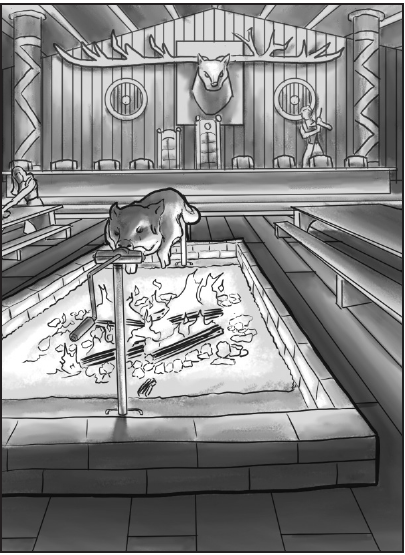
We get a mini-game meant to be run during winter months between adventures. As winters are long and boring in the Northlands, the rare (relatively) warmer days provide relief which locals use to hold intense physical challenges to blow off steam. And those of a more cerebral mind may use the ample time indoors to study, play games, and the like. Each PC rolls an ability check appropriate to their activity or class, and they gain a corresponding amount of Experience (individually) depending on the result. At low levels the experience gained can be significant, but over time it becomes paltry sums midway through the Adventure Path.
The adventures are abbreviated as such: NS[X]: Place Title Here. NS1: Vengeance of the Long Serpent is not the "first" one in this book. The 2011 run began with that adventure and carried all the way up to NS4: Blood on the Snow. Level-wise this took PCs from 5th to 10th, but to simulate a 1 to 20 Adventure Path two prequel adventures (both labeled NS0) were made. They seamlessly flow into the rest of the Adventure Path, making reference to characters and events which show up in NS1.
NS0: Spears in the Ice
Part One, Spring Rites
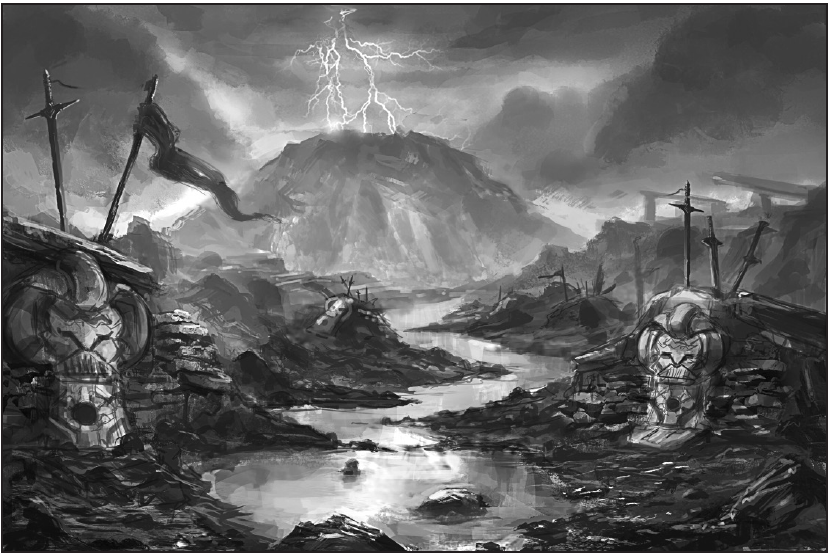
Jarl Olaf Henrikson has three daughters. Inga, his oldest one, is going to be wedded, and the PCs are summoned to his hall by a herald. Preparations for the Spring Equinox, a holiday dedicated to Freyja and traditionally used for weddings, are underway. Jarl Henrikson gets down to brass tacks and explains that his three daughters wish to gather flowers for the celebrations. He wants the PCs to escort them and see to their safety while they ride to a meadow of flowers outside town. The area around Silvermeade Hall isn't particularly dangerous unless one goes too deep into the woodlands or barrows, so it is not your typical heroic saga. Henrikson comments as such, but mentions that once they become great warriors and see their share of death such slice-of-life memories will be "a boon beyond naming."
The adventure goes into some detail over the flower arrangements for the holiday, along with the specifics of the food eaten with the Jarl (black bread, butter, spring greens cooked with white beans and ham hock, pickled flounder, and several pints of beer if anyone's wondering). The PCs also get the opportunity to learn of the eldest daughter's husband, in that he's a member of the Gat family. Jarl Henrikson is trying to make alliances in the even of civil unrest on account of the dispute over Hordaland's leadership. This is an interesting tidbit of politicking, but unfortunately it doesn't evolve into a plot point later on in the Adventure Path.
What I Changed: I made it so that Inga's betrothal is to an NPC of my own creation, Arvid Anudsson, son of Anud Curse-Spear. Anud Curse-Spear plays a significant role in NS3: the Death Curse of Sven Oakenfist, and provides the party a built-in excuse to visit his hall.
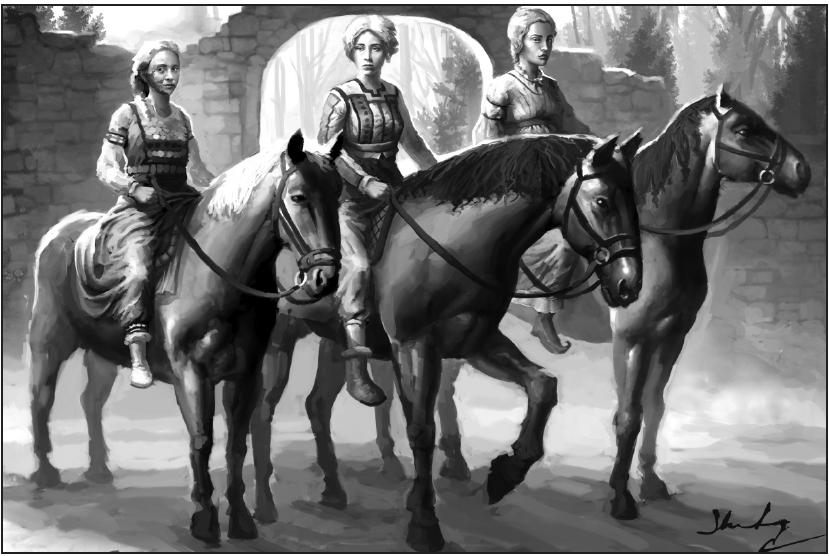
Pictured left to right: Runa, Fastvi, Inga
Jarl Henrikson's daughters await the PCs on horseback. We get some information on how to role-play them during the adventure. Inga is a spoiled arrogant girl who treats the PCs like servants at her beck and call, but a high-status male PC she'll be very polite and flirtatious towards. Fastvi, the middle-youngest, is obsessed with swords and stories of great warriors and will pester the fiercest-looking fighter-type in the group with all manner of questions. She is very impulsive and will get into some minor troubles during encounters unless the PCs reign her in. Runa, the youngest, is quiet and reserved, seemingly talking privately with an imaginary friend named Javik. Appropriate Knowledge checks confirm that her birthing was a difficult one, and that out of desperation Jarl Henrikson requested the aid of a seiðkona (a witch) to ensure both mother and child's safety. Ever since Runa has been "not quite right" by mentioning vaguely o future events yet to come.
During the ride to the meadows there are some non-combat scenarios as a means of establishing group dynamics. One encounter has the PCs meet the jarl's other huscarls on the hunt for a bandit. A few of them mock the PCs for being "such brave warriors to escort little girls for flower-picking," although their leader Hallbjorn will be reasonable and try to put a stop to any fights. This is a good means of foreshadowing, for they appear in the next adventure after this, NS0: Wyrd of the Winter King. Hallbjorn Bolverkson appears as a recurring NPC in future adventures beyond that one too. Some other encounters include Fastvi speeding her horse ahead and trampling through a farmer's crops, a family whose cart is stuck in the mud (who the adventure implies are Odin/Thor/Frigga in disguise) and will cursed/bless each party member with a single reroll of a d20 depending on whether they helped or not, and a very friendly dog in the flowerfields who Runa becomes enamored with immediately.
All of these non-combat encounters contain Experience Awards for proper resolution and/or good role-playing. There is an exception where in one encounter Inga playfully tries to kiss the PC she's enamored with in secret and XP is gained if the other sisters/PCs don't find out. But if the PCs tries to pursue the relationship further she slaps him and said PC loses 200 XP.
I'm pretty sure that encouraging the unfaithfulness of a fiancee shouldn't give you Experience Points.
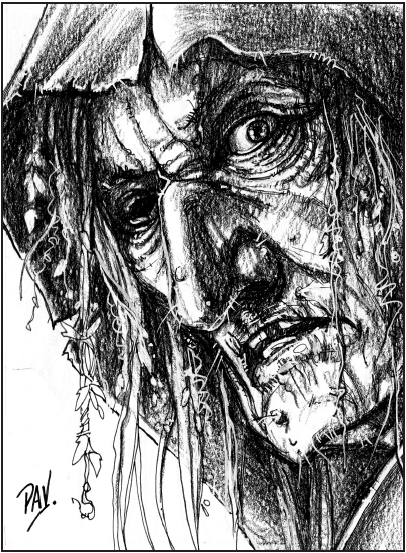
Unfortunately Runa's strange nature is no mere happenstance. The witch who acted as midwife, Sibbe the Unkempt, had her aid forced at swordpoint by the jarl, and as a result she placed a dark hand-shaped birthmark over Runa's face to maintain an arcane connection. Now she plans to kidnap the Jarl Henrikson's daughters for human sacrifice during the Spring Equinox, which will greatly enhance her own magical power!
In order to perform the kidnapping, Sibbe employed two brutish outlaws (Njarni the barbarian and Gufti the rogue) to transport a heavy Andøvan tablet to create a super-powered sleep spell in the meadows. The PCs will feel drowsy as they notice three suspicious characters entering the field of flowers, and must make Will saves each round as the bad guys run to kidnap the girls (who automatically fall asleep) and fight anyone left standing.
This is very much an "unbeatable boss fight" type of deal. But at least the book gives good advice to tell players not to waste their reroll boons from the wagon encounter or similar metagame currency in play. Elves will be unaffected but outnumbered, although the AP hasn't taken into account the possibility of an all-elf or mostly-elf party throwing down with the main villains right then and there.
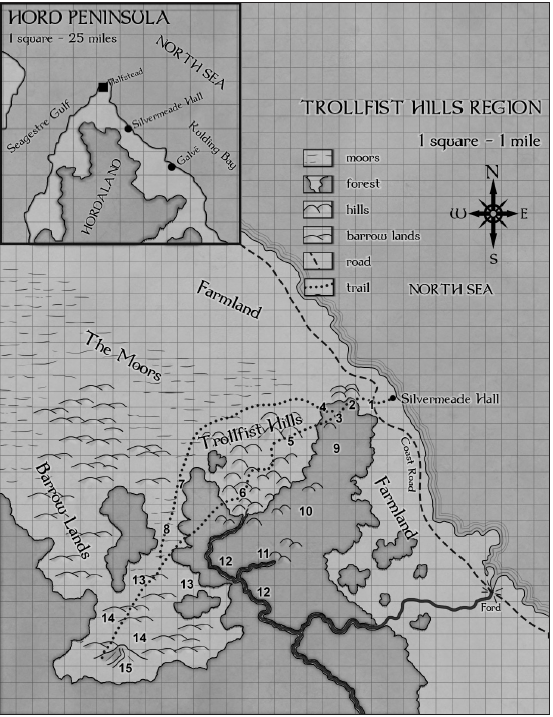
Once they come to, they will find the girls missing and have to follow their tracks. The friendly dog from the earlier encounter will be present to help them out, with appropriate skill checks (Perception, Ride, Survival, etc) in play to catch up with the kidnappers. The rest of the adventure is in a "race against time" format. Sibbe intends to sacrifice the girls on top of a mound in the Barrow Lands, which is 8 hours' travel from the meadow. The PCs have 14 hours total before the girls are murdered. Various complications (getting lost, difficult terrain, certain encounters) may cost the PCs 1 to 2 hours. To make up for this they can can double their overland speed by hustling at the cost of taking nonlethal damage.
Personally speaking this is a rather risky take. As 1st level characters, hit points are in short supply and they have no time to rest and regain spells. The addition of a dog DMPC can help during encounters as a minor benefit. Although the encounters leading up to the clash with Sibbe aren't too difficult, you should keep a close eye on the makeup of your party when running this. Going back to the Jarls' hall is not a recommended option, as this is not only putting more time between them and the kidnappers, Olaf Henrikson will be enraged at the PCs' incompetence:
quote:
To return to their jarl with tales of a sudden magical attack, strange footprints, and missing daughters will see them cast out, and likely challenged to duels of the holmgang between the hazel posts by the older huscarls. The PCs would be branded liars, brought before the next Thing (should they live that long), tried for murder and kidnapping, and then declared outlaws. After that, it will be a race to see who kills them first, the jarl or someone wishing to curry favor with him.
Continued in Next Post
Spring Rites, Part 2
Original SA post
Spring Rites, Part 2
There are a few set-piece encounters marked as numbers on the map above. Given that Sibbe's trail is the top looping line on the above map, I can't see most gaming groups hitting Encounters 11 to 13 unless they get really lost. It's a shame as some of them are cool, and I ran those during the interim between this adventure and the next one to make sure the PCs leveled up.
The initial encounters up to the Barrow Lands are standard fare: a swamp troll (which doesn't fight to the death but is very dangerous, with 38 HP and Regeneration), a bunch of drunk cattle raiders who have a weregild (bounty) on them, and bandits and wild boars in the forest. Some of the more interesting encounters include an undead hound blocking a bridge across a moor, a Bearsarker hanging himself on a tree as part of a ritual to Wotan who utters a premonition of later events in the campaign if uninterrupted:
quote:
The storm will come and Donar’s usurper must be laid low. Ice and cold threaten the world. The glowing stone must be returned for mind’s-worth.”
There's also the opportunity to stumble upon a bandit hideout who the huscarls from above were hunting, as well as a bunch of faeries partying in the forest. If the PCs humor them they find their wounds cured, never get lost again in the woods, and wake up 4 hours before dawn (this can take them back in time). As the PCs are on a time-sensitive mission, this will not be a likely occurrence.
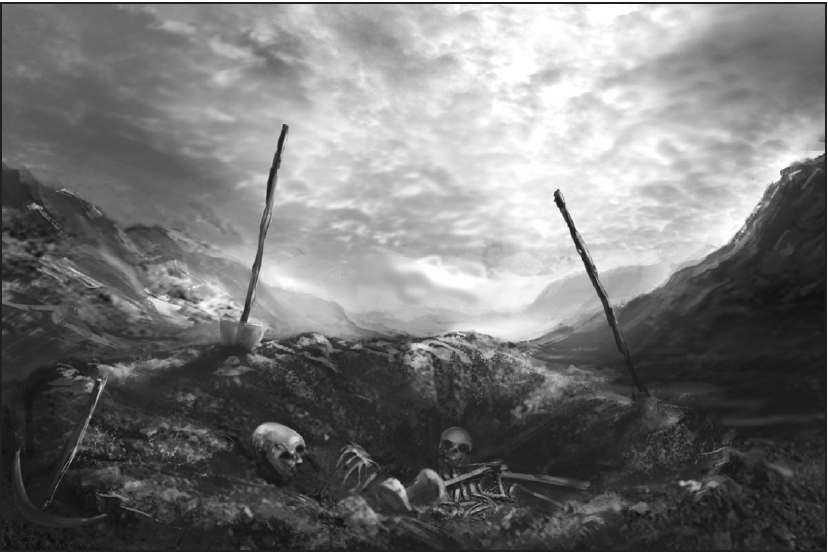
Once the PCs reach the Barrow Lands, things get real creepy real fast. Sibbe possesses an Andøvan Barrow Charm to ensure safe passage, but for the PCs their trek through the desolate waste has them run into a skeletal warrior risen from the dead. Accompanied by 4 soldiers, he gestures silently to a 1 on 1 duel with the party (to death, first blood, or unconscious depending on the would-be duelists' apparent health). As long as the PCs act with honor the undead will let the group pass upon completion, regardless of the outcome. The PCs can take the skeleton duelist's treasure if they win and gain XP for dueling him even if they lose.
I rather like this encounter. It sets up the fact that they are in a world with different social norms than most settings, and the mechanics reinforce this.
The final encounter is a Fight at the Stones. Regardless of the time of day a lightning storm will strike and hordes of undead Andøvans come charging out of barrows to the tor (hill). Sibbe's theft of the amulet, combined with her ritual, has disrupted the natural order of things and encouraged the relic's owners to act. However the Barrow Charm prevents the undead from approaching directly, so the undead king leading the hordes hopes rather to corral the PCs (or make them rush faster) to Sibbe's location.
I've heard of kings railroading adventuring parties to the plot hook, but this is ridiculous!
As for the showdown with Sibbe, she and her two thugs are within some Andøvan standing stones at the top of the hill. There is mention of environment and how it can be used for advantage: PCs can climb up a slope in the dark for Stealth and cover, pushing someone off the edge/down the slope deals falling damage, and those standing atop the standing stones risk being struck by lightning. For her part, Sibbe is busy preparing for a ritual, with a curse-enchanted Runa helping out as Inga and Fastvi are rendered bound and helpless. Njarni and Gufti stand watch and if they see the PCs' approach will warn the witch so she can buff them each with enlarge person.
This is a rather difficult fight. In addition to the 3 foes, Sibbe herself has a Summon Monster II spell, and the enlarged raging barbarian can deal 3d6+12 damage with a greataxe and +7 to hit. If the battle turns against her she will command Runa to briefly attack the party with her fledgling magic in order to cover her retreat.
What I Changed: At the time my party comprised of a Skald, a Rogue, a Jotun, and a DMPC dog but I still feared an overwhelming encounter especially as the party was softened up by earlier ones.
I changed things around so that the outlaws in the Bandit Hideout encounter were on the path of travel rather than in the forest. They earlier tried to jump Sibbe's party when they recognized the jarl's daughters, hoping to get a ransom but the witch's magic proved unexpected. She took out a few of their number and the survivors aren't exactly keen on fighting. The bandits had a sorceress NPC among them with healing potions, so if things turned violent the PCs had an opportunity to heal. But on the other hand they weren't eager to go into needless combat and had a mutual grudge with Sibbe. Our skald seized on this and Diplomacized the bandits into an unlikely alliance. There numbers gave the party a better shot in the final battle.
Whether or not you do it my way, I do suggest sprinkling healing potions in the various encounters on account of 1st level fragility.
Resolution
The adventure's conclusion can go several ways. If the PCs lose or do not catch up in time, anywhere from one to three of the daughters will be killed (Inga, Fastvi, and Runa in that order). If all three die, then Sibbe will transform into a younger version of herself and becomes a level 8 witch. If the PCs survive (unlikely) the undead will disperse on their own but grow much greater in number over the following months.
The PCs' hurried rescue did not go unnoticed. Jarl Henrikson noticed that they and his daughters were staying later than usual. He followed the PCs' trail straight to the mound with a band of warriors and huscarls in tow. He will be happy (less so one or more are dead) if any of the girls were saved, and grant them metal arm-rings as gifts: the more girls saved, the more valuable the rings given. But before our party can leave, the undead warriors gather around the warriors but do not attack. Rather they seek to parley: the boxed text more or less states this so it will be spelled out to the players. Tension builds as their barrow king approaches, taking out a magnificent bronze sword and mimics the putting on of a necklace. If the PCs give him the stolen barrow charm, he will present his sword to the party in exchange.
The greatsword is Hægtesse ("Fury"), and has the furyborn property which temporarily increases the enhancement bonus for every iterative attack the wielder makes against the same opponent. The jarl's householders are in awe, including the ones that mocked the PCs during their first meeting. They now hold respect for the PCs that not only saved the jarl's daughters, but the one who faced an Andøvan king and lived to tell the tale.
Once safely back at home, the PCs will be further rewarded with masterwork items appropriate to their class. There will be celebrations and characters will ask the PCs to retell their exploits while feasting at the hall. If any of the girls died the atmosphere will be more somber, and they will have lowered standing in Jarl Henrikson's eyes (but not so much to mitigate their ability in saving the other girls). If Runa is alive talk of her sorcerous powers will be vehemently denied by the jarl. He is unwilling to confront this obstacle and threatens a PC who persists to holmgang. Runa can either be tutored secretly to better control her powers, or the trauma of the kidnapping will cause her to try and repress them.
The adventure makes mention of multiple possibilities for Runa, although none of this is expanded upon in the later adventures. I presume it's because she can die if the PCs really fuck up.
What I Changed: The PCs managed to save all 3 daughters. I had 2 new players at the time interested in joining the game, and one of them wanted to play a Nûklander witch. I decided to downplay Jarl Henrikson's magephobia and had him hire said PC to be a "consultant in the magical arts." She was also to ensure that Runa's powers do not cause any further harm.
Finally the party gets bonus Experience Points depending on how many girls they saved, if they got possession of Hægtesse, stopped Sibbe's ritual, and/or kept Runa's sorcerous secret safe.
Concluding Thoughts: Spring Rites has a strong start. Its noncombat encounters pave the way for future events in the campaign and provide a good means of experience advancement. It has an epic feel to it too for a 1st-level adventure: we have a fight among standing stones during a lightning storm, a duel with an undead skeletal champion, and the PCs can get a cool named magical weapon...all at 1st level!
Its weak points are the super-sleep railroad (which is a bit too blatant in execution) and the "race against time" isn't ideal for a beginning party. But overall I'd say the good outweighs the bad and gives a strong first impression for players on the mood and feel of the Northlands!
Next time we cover Wyrd of the Winter King, where the PCs raid the iceberg palace of one of Althunak's warlords!
Part Two, Wyrd of the Winter King
Original SA post
NS0: Spears in the Ice
Part Two, Wyrd of the Winter King
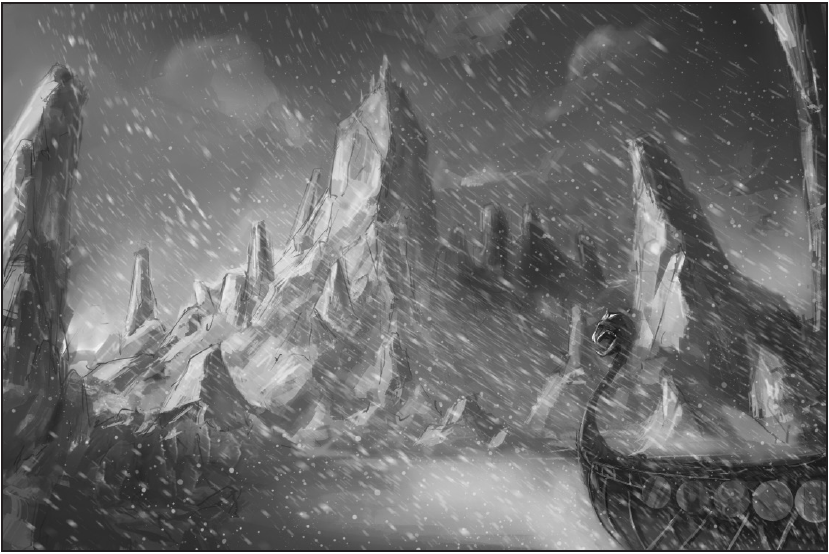
This adventure takes place six months after the end of Spring Rites. By now the PCs should be 2nd level, and are once again called into service by Jarl Olaf Henrikson. Winter is coming, and the harvest has been poor. Henrikson called the PCs into service plus 60 members of his household to join him on his ship The Long Serpent. and undertake a voyage farther north than any Northlander has ever sailed. Hopefully they will find land with valuables to claim and arctic animals to hunt (walrus tusks, sealskins, whale blubber, etc) that can be used to trade for grain in a worse-case scenario.
No plan survives first contact with the enemy. Unbeknownst to the people of the Northlands there was once a vast empire of the Uln in the Far North. When the Ulnat put an end to Althunak's reign of terror, the demon-god's faithful went into hiding. One of the more well-to-do survivors was Prince Uth’ilopiq, who went into suspended animation in his frozen fortress the Ice Palace. As the eras passed the land it sat upon broke off with flowing glaciers; reawakened, Althunak's champion waits as his fell fortress slowly drifts south to lands which know not the dread legacy of the Lord of Ice and Cold.
What I Changed: I renamed Althunak's most common title to the Lord of Ice and Stone. Two of his temples in the later adventures are called the First and Second Temples of Ice and Stone, plus it is less of a redundant descriptor.
quote:
When five days out of the North Sea and into the embrace of the Great Ocean on your journey, Young Ljot yells out that he has spotted land. A small glint of reflected light can be seen on the horizon. Jarl Olaf orders that a course be set toward it. As the longship approaches, a huge iceberg comes into view, less a floating block of ice than an island — a full glacier perhaps — of ice drifting through the sea. Such a large iceberg has not been seen in generations.
A closer view spots a break in the valley along with a palace of towering spires. Being a bunch of adventurous Vikings, the jarl is naturally inquisitive as he tells of a legend he once heard of a city of ice filled with treasure floating in the sea. Four of his huscarls, who were NPCs from the Spring Rites adventure, are eager to go explore. It is presumed that the PCs tag along as well, or are told to do so by the jarl for some much-needed experience. The ship's crew levels the oars parallel to the water's surface and up to the iceberg's land so that the huscarls can valiantly "run the oars" with no difficulty, but the PCs have to make an Acrobatics check when doing the same thing or fall in the water and risk exposure to cold weather.
The NPCs in question are all Fighters and much more experienced than the PCs, ranging from levels 3 to 8. They do not have stat blocks as the adventure will separate their two groups soon, and the adventure calls out that their wyrd foretells their doom upon this land of floating ice. There's One-Eyed Sven who's a friendly mentor type, Berg Geirson who is the group's Debby Downer pessimist, Young Ljot a shy yet courageous archer, and Hauk Arinbjornson a headstrong mercenary from Vastavikland who hopes to prove himself worthy to serve in Jarl Henrikson's household.
But once they get on shore everything goes south quickly. A magical trap within the Ice Palace triggers, causing a huge storm of icy wind sounding like "the Horns of Hel" barrels down the iceberg's southern cliff. It risks burying slow characters in snow, reduces visibility, and once it relents the party finds themselves separated from the huscarls who came ashore. The Long Serpent is nowhere to be found as the supernatural winds blew it far away. One-Eyed Sven's hunting horn sounds from somewhere in the valley (the NPCs rushed far ahead during the storm) as a clue to their current location.
What I Changed: Where to begin? First off, the whole "stumbling upon the BBEG's lair by chance" wasn't my style and I wanted a stronger start. I instead remade the adventure hook into rumored reports of warriors raiding coastal settlements via a traveling iceberg. They'd make to retreat, only for an unnaturally early winter to blow in to the area, bringing starvation and making the people more desperate for "protection" and tribute. A messenger from one of these settlements made his way to Halfstead and warned Jarl Olaf Henrikson of the plot. The jarl decides to strike at the iceberg with three longships prematurely before it can sweep into Hordaland, turning the expedition hook into a straightforward raid.
I altered the wind trap so that giant icicles were being catapulted from the Palace once the PCs and huscarls made dry land. One of the icicles sunk a longship, prompting the other two to set sail and stay mobile so that they won't be sunk and stranded on the iceberg. There was still unnatural snow, but it gave the PCs an obvious objective ("disable the icicle generator") as well as showing off that the Winter King doesn't screw around.
The way to the Ice Palace is rather straightforward. The iceberg has a set of cliffs at the center, but a valley opening in the south allows for an accessible (if steep and treacherous) climb. Most of the encounters are environmental challenges: being quiet to avoid triggering an avalanche, finding a way to cross a chasm spanning icy water, a windswept sky bridge leading to the Palace proper, and a cave full of warring degenerate mephit swarms who quickly fill the valley. During this time the PCs can find the unconscious body of One-Eyed Sven: he triggered an avalanche with his horn, and is damaged to the point that healing magic will not be enough to revive him back into fighting condition. He's the only NPC who can be saved during this adventure, and PCs who take the challenge of keeping him warm and safe throughout its duration will get bonus Experience Points at its conclusion. Young Ljot, however, is not so lucky, blown off the sky bridge to his doom.
The Ice Palace
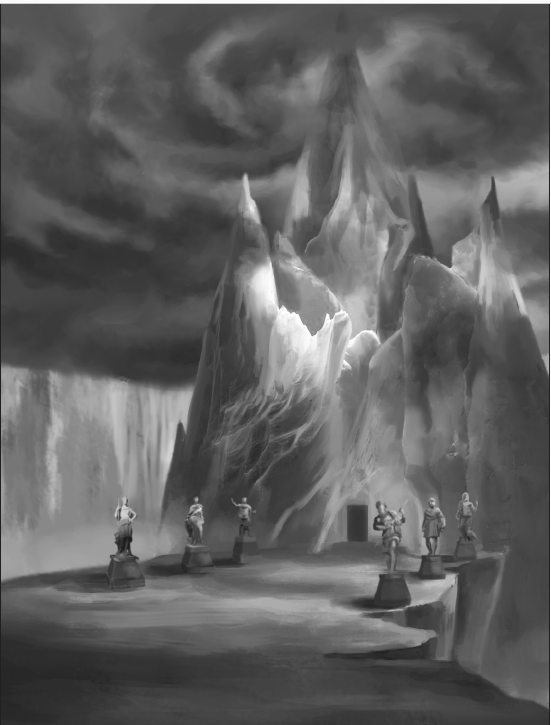
Here's the real meat of the adventure. It's a 53-room dungeon crawl with 3 levels (main level, towers, lower vaults). A good portion of the rooms have encounters or traps of some kind (22 out of the 53), and the adventure does not assume that the PCs will clear out all or even most of them. A fair number of combat involves battling undead zombies, skeletons, and a few cultists of Althunak (zombies with the
quote:
"Speak the wellspring of life." Answer: "Blood."
"Speak Althunak's due." Answer: "Sacrifice."
The palace has cultural legacies of a forgotten civilization and writings in Old Uln, with emphasis on Althunak's favorite things: violence, sacrifice, cannibalism, and winter. There's a fair number of good treasure in the dungeon, such as a +1 flaming short sword, +1 frost longsword, various spell scrolls, a Ring of Protection +2, and even a size-changing folding boat in the pockets of one of undead acolytes. There is also thousands of hacksilver worth of mundane art and jewelry to collect, too. It's a pretty good haul for 2nd-level PCs, but the treasures are rather spread out and given that Prince Uth’ilopiq is a Load-Bearing Boss it's not the kind of dungeon you can explore again.
What I Changed: In keeping with the "raid" simulator I had going on, Jarl Henrikson's longship came ashore to the north side where he and a small contingent of warriors made their way up to the Ice Palace via climbing axes and picks. The PCs got there first, but after a particularly unlucky encounter with skeleton warriors they set up camp and the Jarls' forces made their way there. They had NPC Vikings help them in some encounters and restocked supplies in "liberated" sections of the dungeon as an impromptu resting/trading area. It was assumed that there was fighting going on elsewhere the PCs weren't, and given the layout of the Palace it would be counterproductive to bunch up all the allied forces in a single location.
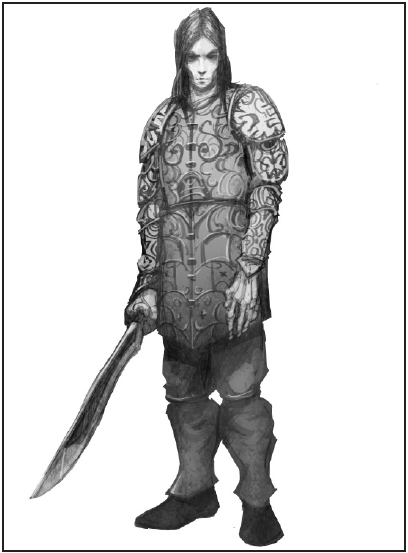
The Throne Room is home to Prince Uth'ilopiq, who became aware of the intrusion upon his icy dominion. The corpse of Berg Geirson, frozen where he stands, is just outside the throne room's doors. While sitting on his throne the Prince can summon figures of undead and axe beaks (ostriches with sharp beaks) from hanging tapestries to attack the party and defend their master. He can also surround his throne with a cube of force which levitates him up to the ice bridge at the second level of the dungeon. Otherwise the Prince prefers hit and run tactics, stalking the PCs via hidden corridors (which are actual rooms on the map) and summoning reinforcements through various tapestries.
Prince Uth'ilopiq is a pretty tough customer. He's a level 3 antipaladin, undead, and a hoar spirit on top of that. He has a Cone of Cold that deals 4d6 damage and Save-or-Suck claw attacks which can paralyze someone for 1d4+1 rounds on a failed Fortitude save. He has 70 hit points, 21 AC, and very high saves (fort/reflex/will +10/+9/+13). His only real weakness is that he takes double damage from fire attacks.
The adventure strongly implies that the final battle with Prince Uth'ilopiq should be on the bridge. You may have noticed that I haven't spoken of the fate of Hauk Arinbjornson. Well turns out he's alive and is climbing his way up the central spire to make a surprise leap attack at Althunak's favored. This will happen in one of two ways: if the PCs reduce the boss to negative hit points, or if they are struggling and need to get rescued. Either way Hauk's axe embeds in the Prince's skull at leap's end. To avoid falling while climbing Hauk had the axe's leather thong wrapped around his wrist, which ironically pulls them down together to their deaths. Not even a feather fall will work, as the Norns cut the threads of both their foe and companion. As soon as the Prince dies, the magic holding the supernaturally-huge iceberg unravels and the very land violently rumbles. Earthquakes trigger avalanches as bridges, towers, and support structures of the Palace break apart. The adventure does not call for skill checks or risks of damage; it's presumed that the PCs are running like hell.
Once the PCs make it to the shore, either they escape with the folding boat or a section of ice breaks off into the sea with them on it. In the latter case they will be adrift for a day before Odrik Ragnarson, the captain of one of Jarl Henrikson's other ships, finds and rescues the party. He will ask for a 10% cut of the treasure recovered from the Ice Palace: the adventure explains that the treasure is technically the Jarl's for them being members of the crew, and the captain has to give up his share too along with expenditures for additional space and supplies to cover the PCs. I can get that justification, but I can see some gaming groups arguing with him all the same.
As for the fate of the Long Serpent, the Ice Palace's fell winds blew it mightily off course, and neither Ordrik nor any others know of its fate. The adventure assumes that if the PCs have the folding boat that they will sail south back to Halfstead in hopes of reuniting with the longship. If One-Eyed Sven was rescued, he will run the jarl's household in his absence and grant the PCs a place of high honor at the table for their great renown.
And this is how our tale ends.
What I Changed: I hate how Hauk's sacrifice is meant to play out: no matter how it's resolved it either feels like a kill-steal or a Deus Ex Machina. I let the PCs hold all the glory as the Skald dealt the last blow. Grievously injured, Prince Uth'ilopiq laughed as he tugged himself forward on the blade, exclaiming how with his death they will all be buried with him. Instead I had Hauk disable the undead controlling the magical ice storms in the tower and had him jump down to fight Uth'ilopiq's other minions during the bridge battle.
I also nerfed the Prince's abilities a bit, including removing the Save-or-Suck paralysis, lowering his AC to 15, and making his cone of cold deal half the damage it normally would do (2d6 instead of 4d6).
Concluding Thoughts: Wyrd of the Winter King is a pretty fun adventure. The dungeon-crawling aspect may take some tweaking, and the PCs really do need a means of restoring HP and abilities if you run it straight. The load-bearing boss and the fight with Prince Uth'ilopiq establishes a good precedent for the next 2 adventures where the Cult of Althunak plays a major role.
One thing I'd mention is that this adventure is very undead-heavy, which is not a standard for the Northlands in general. A cleric or someone who can channel energy can make encounters significantly easier, and certain archetypes such as illusionists and enchanters will be at a disadvantage here on account of common undead immunities. I would also suggest letting the PCs level up as soon as they hit the experience requirements rather than waiting until the end of the session. This is in account of the relative "fast pace" and multiple challenges of the dungeon.
Next adventure is Vengeance of the Long Serpent, where our heroes learn the fate of their Jarl and a grave new threat facing the North!
NS1: Vengeance of the Long Serpent
Original SA post
NS1: Vengeance of the Long Serpent
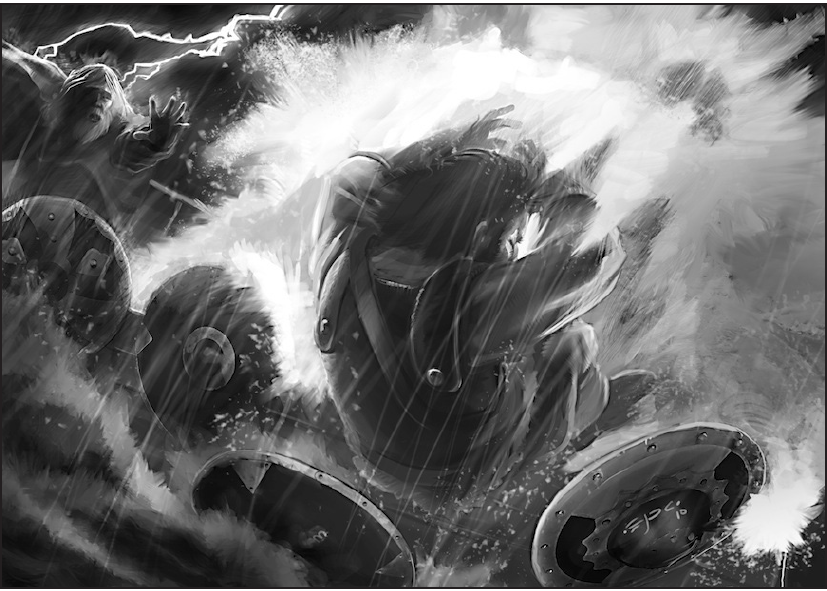
This adventure is quite a leap from the prequels because it's meant for PCs of 5th level. Going by Medium Advancement in Pathfinder that would require 15,000 XP. It's likely that the party may be a level or two short, particularly if they rushed through the Ice Palace in Wyrd of the Winter King. Even if they took care of most of the encounters, the jump between 3rd and 4th is nearly double (5k to 9k). I believe that the AP is meant to be Medium Advancement, but I've heard of gaming groups due it on Slow. I can only speak to my personal experience running this on the Medium Advancement Track, but I genuinely can't see running this campaign on Slow unless you artificially pad out the campaign with random encounters and sidequests. Still, we managed well at level 4, although we had relatively powerful PCs minmax-wise at this point.
As for the adventure proper, it takes places 6 months after Wyrd of the Winter King in the season of summer. While in the busy port of Halfstead, there is much fanfare as the Long Serpent pulls into harbor. Many onlookers are familiar with the Jarls' ship and eager to learn of events, but the Vikings who come off bear looks of defeated men and women. Not all survived the voyage, and family members discover their loved ones' absence all to obvious even when unspoken among the crew. Hallbjorn Bolverkson walks off by himself to the nearest tavern, which also bears his namesake: Hallbjorn's Folly.
PREMONITION!!!
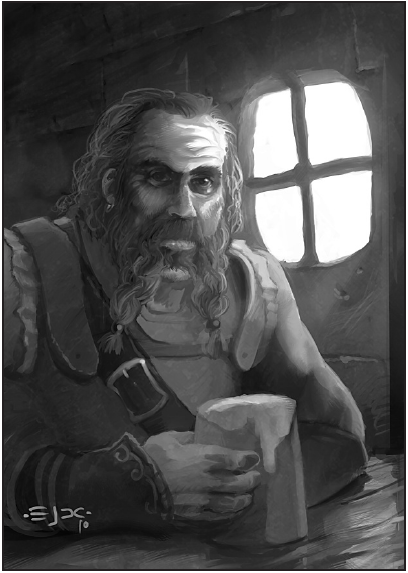
He appears a bit happier if the PCs make introductions, asking about their time on the mythical iceberg and the fate of the huscarls who went with them. During the conversation he explains (with liberal use of boxed-text kennings) what happened to the crew of the Long Serpent and their jarl: the ship made land at a coast rich with game of seal and whales. But they were ambushed one night by strange men who attacked their camp. Jarl Olaf Henrikson was one of those killed. The cry for vengeance encouraged their pursuit tomorrow, and they cornered their new foes in a hall full of strange treasures and trinkets. The last surviving attacker was taken, and told Hallbjorn's warriors of a village of stone dedicated to 'Althunak' further north before cursing his name. Hallbjorn responded by slaying him and tossed his body into the sea.
Having taken significant casualties, the voyage was made back south with what loot they got to trade for necessities back home. At this point Hallbjorn asks the party if they are courageous enough to join him among new replacements to avenge their jarl. He produces some of the strange jewelry and gold taken as loot, which PCs familiar with the Ice Palace's decorations can recognize being similar in design.
What I Changed: Naturally the last adventure I ran rendered the mystery of the Long Serpent moot, so I decided to have it be that the PCs were on guard at home while an expedition to the Far North was made. The default story hook works, even though it has the offscreen death of the PC's boss. It motivates them via vengeance, as well as potential greed for more mercenary-minded characters with the loot found. As Inga and the daughters were alive, I had some role-playing scenes with them, with Inga wanting to help fund their voyage as well as having her suddenly being thrust into responsibility as the next jarl in line.
Once the PCs accept his offer Hallbjorn becomes a new man. Through the next day he quickly stocks the ship with a crew of 50 and ready to sail again on the morrow. He has a deal with Jarl' Henrikson's widow and families of the lost crewmembers: grant them a share of the loot obtained in the journey back to the Far North. He graciously gives 500 hacksilver each for PCs to outfit themselves and their animal companions/retainers with supplies for at least 2 months.
The Voyage North
This adventure, including both the voyage and their time in the Far North, is expected to last for 2 months give or take a few downtime events. There is a mechanic for food to track for the crew. Supplies can be restored via random encounters (giant crabs are surprisingly edible) and hunting with appropriate skill rolls. Additionally, a lot of loot here (and in the Far North) is less coinage and more things like blubber, ambergris, walrus and mammoth tusks and the like. Basically resources from animals which would be worth a pretty penny. Given that the PCs have a ship and crew, there's no listed weight and the profits gained for PCs are presumed to have taken into account the 50 something other sailors getting their due as an abstract resource (you can get a lot of stuff from a whale's body). I like this touch: one, it cuts down on excessive book-keeping and two it has a believable sense of loot acquisition outside the typical "dungeons full of treasure chests" vibe.
The first chapter of this adventure is a mixture of random and set-piece encounters at sea. Encounters are rolled every 3 days, meaning that PCs are fighting at the top of their game in terms of spells and per-day abilities. The encounters include storms, a non-hostile dragon turtle, a dire shark who's only a threat to those who fall overboard, a giant squid which makes a hit-and-run for tasty morsels, and an island with a sea hag.
The first set-piece encounter includes the opportunity to harpoon a narwhal: this endeavor is handed as skill checks rather than straight combat, and grants a good bit of supplies, treasure (ivory), and of course Experience Points. The second encounter is far more serious, as a red sky at morn indicates a brewing storm. In spite of the preparations undertaken by the crew, Mother Nature gives the Long Serpent the fight of its life. PCs have to strain the oars to maintain forward momentum, and the temperature is dropping causing freezing water to spill onto the deck. There is a risk of PCs becoming exposed to cold weather from getting soaked, losing their footing, and even falling overboard depending on the results of their skill checks. Hallbjorn is at the rudder, and his lifeline is snapped as he and several other crewmen wash away.
This is no ordinary storm, for a few sailors swear they saw a beastly visage in the waves; one that has an uncanny resemblance to face on the coinage taken as loot by Hallbjorn from the last expedition. Hallbjorn's seeming death is a scripted event. This is to make it so that the loss of leadership causes the sailors to debate who to nominate in his place. This will be one of the PCs, but several factors determine exactly who gets the role (trained in Profession Sailor, worships a sea god, acted with courage, etc). They won't be completely in the dark, as Hallbjorn's maps and notes are still onboard to consult.
Our final encounter before Chapter 2 of NS1 occurs two days after the storm. A lone Ulnat warrior in a kayak was blown offshore and suffering from thirst and exposure. If the PCs save him, they learn that his name is Yilithi (he doesn't speak Nørsk but can gesture), and he can give directions to his village.
What I Changed: At this point in the AP I realized that there was a heavy male bias in NPC demographics, so I changed Yilithi to be an Ulnat woman named Aluki. Her role in the story was more or less the same, but the players liked her so much that they later had her on a Leadership cohort.
Continued in next post
Vengeance of the Long Serpent, Second Part of Post
Original SA post
Vengeance of the Long Serpent, Second Part of Post
Exploring the Far North
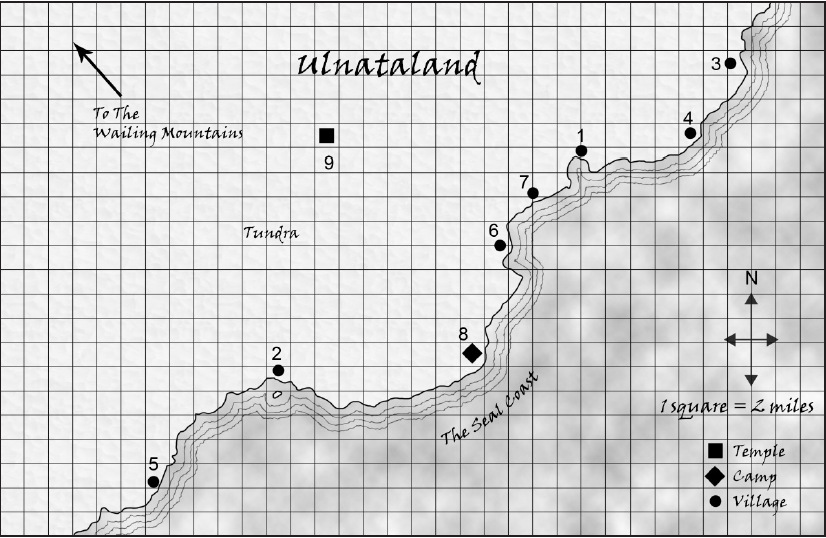
This portion of the adventure gets a lot more sandboxy. There's a main goal which unfolds, but the PCs have more or less relative freedom when and how to handle it (as long as their food supplies last). The big picture is that ten years ago the Children of Althunak cult is on the rise again thanks to an Ulnat outcast named Elvanti. Angered at the fact that a women he desired wouldn't marry him, he fled when everyone else told him to stop being a "Nice Guy." Filled with revenge against those that spurred him, Elvanti made his way to one of the cities of the Uln and made a pact with the demon-god. Coming back to Ulnataland with fell supernatural powers, he froze the elders of his tribe in magical ice and and did the classic "I am the Dark Lord, join me or die" speech. Over time his cult grew, and it was members of this cult who attacked and slaughtered Jarl Olaf Henrikson and the people of the first voyage.
The various numbers on the above map represent Ulnat villages and in 2 cases the burial mounds of the jarl's crew (which the PCs should not loot unless they want to fight risen dead and their own crew) and a big temple to Althunak under construction. Most of the villages are having trouble, either under the thrall of cultists or at war with them. Killing or driving off the cultists (who can range in number from 3 to 18) liberates a village and lends the aid of Ulnat warriors (who are Rangers) to fight at the PCs' sides. The relative center of the Children of Althunak's forces and their leader in the region are headquartered at the Second Temple of Ice and Stone (first one is far north in the ruins of an Uln city). The adventure is "won" once the PCs successfully lay siege to that shrine. Strangely enough, the sailors on the Long Serpent are not discussed how/if they are deployed to help liberate villages.
There are random encounters in the Seal Coast of Ulnataland, although they're mostly mundane yet vicious arctic animals. One of them's a herd of mammoths who have the most to give in food and hacksilver ivory as loot. Although they are incredibly strong and risky to fight unless the PCs have a means of outrunning them, separating one from the herd, and/or get off a lucky save-or-suck spell.
What I Changed: The adventure runs the risk of becoming very samey in terms of combat. Besides their boss at the Temple, the Children of Althunak have universal stat blocks for every village: rank-and-file cultists (Barbarians) and spellcasting shamans (Adepts) who have ice mephit familiars along war-trained dogs (wolves). I spiced things up by having one village overseen by a single shaman who oversaw a kettle of demon-gods (dogs with fiendish template); I had the village with the magically-frozen elders home to some assassin demons, and put a few hala demons (aerial) at the Temple of Ice and Stone.
An additional complication is the large amount of allied NPCs which could prove hard to handle. I had it so that the forces represented total units for the eventual assault against the Temple rather than constant travel companions. 1 or 2 NPCs can show up when liberating smaller villages, but I had a system where for every allied warrior I would subtract 1 enemy NPC/monster during the temple assault to represent casualties and distractions among the opposition.
As for how the PCs are supposed to get the gist of this, Yilithi is insistent for them to visit his home village of Laquirv (area 5). Once they get inside, Yilithi's father introduces himself and explains the geo-political climate of the Seal Coast along with Elvanti's backstory. He's surprisingly fluent in Nørsk, once having accidentally visited the Northlands via a freak storm blowing him off-course (trait seems to run in the family). He hopes that the arrival of the Dragon Riders (their term for Northlanders) will be a boon in fighting those who sold their souls to Althunak, and tells the group about the Legend of Heroes' rock: a burial tomb which may provide guidance of how those long before once vanquished evil. He also mentions the idea of liberating villages to gain allied forces if the PCs do not come up with the idea themselves.
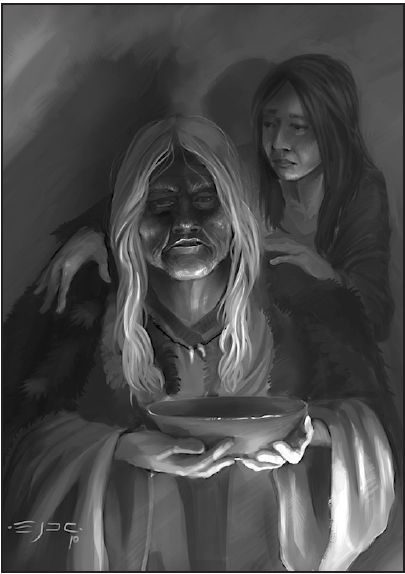
Heroes' Rock is technically an optional dungeon, but contains some important equipment and some information on the rise and fall of Althunak in times long past. It's quite small, 4 rooms and only the entrance has guaranteed combat: a golem made of skitched skin animated by a spider swarm. The burial vault contains pictographic murals explaining the history of the Uln and Ulnat people. At one point the specters of the three Ulnat heroes who fought the original Cult of Althunak materialize: if the PCs can prove that they they have good intentions said spirits will loan their magical treasures to the PCs for the duration of their war against the cult. If the PCs try to renege on the deal (keep the loot for themselves afterwards), said specters will hunt down the PCs to take back the items. Although there will come an opportunity for the PCs to gain these as permanent treasures in the next adventure
The magical items are quite good. They include a +1 animal-bane scimitar, a wand of fireball with 13 charges, scrolls with the fly, mending, and tongues spells, and the legendary sword FELLFROST!
What I Changed: I learned sometime that the IRL Inuit fashioned some tools out of meteorite iron. I decided to reflavor Heroes' Rock as being the dug-out remains of a meteor containing cold iron, which gave the village of Laquirv an advantage in resources. Both in being useful for metalworked tools and for the materials' ability to harm demons.
Against the Children of Althunak
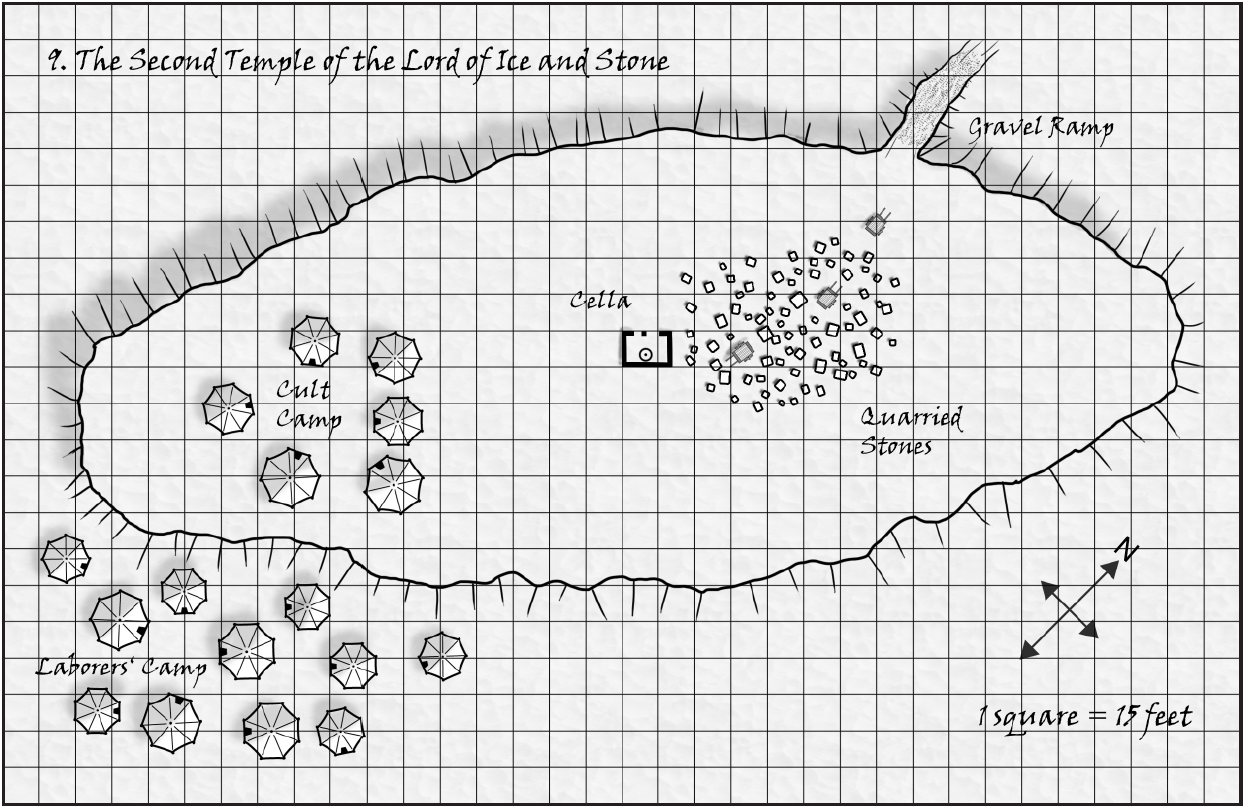
The final chapter of Vengeance of the Long Serpent discusses how the Children of Althunak react at the large-scale level to newfound resistance. They will fan out in patrols around the coasts with kayaks and move mobile villages inland. The cultists also need to stock for provisions so they won't fortify a single base and hold down indefinitely. Unless the PCs tip their hands do not know the nature of the force ("are they Ulnat or foreigners, random or tactically coordinated, etc?") so they are divided in how to handle the threat.
As for the Temple proper, it is located on a plateau which gives the cultists an ample field of vision which to spot intruders, and is labor-intensive in the requirement of slaves for its construction. Specifically, a big-ass statue of Althunak is the major project: a gaping maw, a crown of icicles, and dried blood for a nice paint job. The guards can be quite varied in number (1d10+10) with 1d3 hunting dogs per cultist, and the adventure encourages the GM to alter the numbers depending on the PCs' forces to ensure a reasonable challenge.
The High Priest of the Coming Winter is here at all hours. He has levels in Adept, a rather low-power NPC spellcasting class, but the trick up his sleeve is that he's a werebear unafraid to mix things up. Several of his spells are geared around buffs such as bull's strength and bless, and he has obscuring mist and web for battlefield control. Defense-wise he's quite tough, with DR 10/silver (which the PCs are not guaranteed to have via loot) and up to 22 AC depending on which form he takes.
When the fighting starts, the cultists will defend the cella (main house of worship containing the statue). There are noncombatant family members of the cultists and slaves present, the latter of whom will not take to arms unless the High Priest is slain. At this point the slaves will take up arms of fallen cultists and turn on the remainder as well as the noncombatants and dogs unless the PCs stop them.
What I Changed: I removed the presence of civilian cultists from this as well as their potential slaughter, on account that role-playing out the consequences of war crimes didn't fit with the previous adventures' derring-do heroism and overall wouldn't lead to good times with my gaming group.
Once the cultists are defeated, the surviving Ulnat will topple the statue of Althunak, and there's a king's ransom worth of loot to be claimed in the cella (over 15,000 hacksilver worth). After the Seal Coast is freed from the Children of Althunak's grip, the Ulnat present several goodwill offerings for the PCs before they leave for home, including various trade goods and a staff of the woodlands which can do various druidic spells. They also hope that the PCs return again as friends and trading partners. Back at Halfstead, Olaf Henrikson's widow is expecting a portion of the proceeds. Although the deal was with Hallbjorn it would be the honorable route for the PCs to maintain this deal. If the PCs do so, the widow will let the party keep the Long Serpent on account that her family won't be using it for some time. She says it is better served on the high seas than rotting away on land.
What I Changed: I used the deal with the family members to show off the gift-giving experience campaign house rule even though it is meant to be used for the party's servants and hirelings.
Concluding Thoughts: This is a pretty good adventure. It starts out linear but opens into a bit of a sandbox, has abstracted treasure which makes sense in the context of the world, the natives are not helpless people waiting to be saved but fight alongside the PCs for an eventual battle at the main temple, and speaking with the legendary heroes to get their magical gear on loan is in line with Spring Rites' Hægtesse. Such options make getting new equipment feel like momentous occasions. The Northlands has a pleasant variety of adventure types, and after a "race against time" and "dungeon crawl" adventures, the "sandbox liberation" that is Vengeance of the Long Serpent helps keep things fresh.
BUT THAT'S NOT ALL! Althunak is pissed at this major setback, and although there are no explicit encounters the adventure suggests peppering the next few adventures with signs of his displeasure: cold-based monsters appearing out of nowhere, localized freak weather, etc. Good thing the PCs will be wrecking the original Temple of Ice and Stone in the next adventure, NS2: Beyond the Wailing Mountains!
NS2: Beyond the Wailing Mountains
Original SA post NS2: Beyond the Wailing Mountains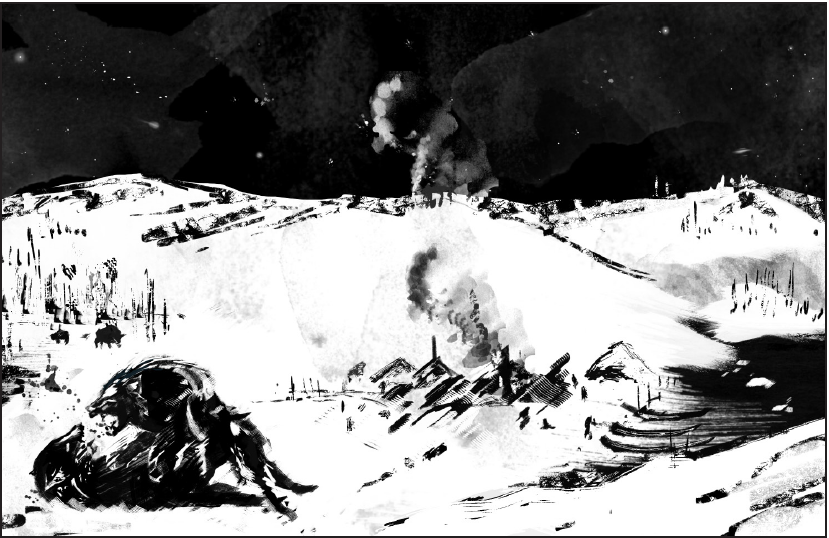
Beyond the Wailing Mountains takes place 9 months after Vengeance of the Long Serpent as a new spring dawns. Whether by paranormal activity of an Althunakian flavor, visiting the Ulnat again, or receiving word from a northbound friend or ally in danger, the PCs are back in Ulnataland. The adventure also suggests the possibility that the PCs may wish to put a stop to Elvanti once and for all immediately after Vengeance of the Long Serpent, and to adjust the season accordingly. There is less of a jump in terms of character progression, with the minimum recommended level being 6th and the maximum recommended being 8th as opposed to Long Serpent's 5th/7th. With the exception of NS10: the Broken Shieldwall, every adventure in this campaign bumps up by 1 level for recommendations.
The adventure proper begins in Laquirv. Kelvani, Yilithi's brother and Kelvani's other son is back...dead, and encased in a block of ice impervious to mundane fire. The body within has an obviously broken jaw and posed to hold a severed hand and bloodied spear, meaning he did not die of exposure. Clearly this is the work of the Children of Althunak! The PCs do not have much respite to contemplate the weight of this before the cult follows up their warning with a proper raid. A legion of yetis and ice trolls attack the village, with the PCs fighting 3 or 4 of them while the rest battle Ulnat warriors in the background. Kelvani's corpse reanimates as a fetch (cold-based undead) and slays his own father.
Once the battle is done an Ulnat examines an ice troll's monstrous form and sees the face of Klinqa: the women who rebuffed Elvanti's advances! In fact, the many ice trolls of this adventure are Elvanti's "snow brides," women captured from the cult's conquest to be made into his concubines. Faced with this sudden discovery, Yilithi gathers up the surviving elders and further explains things to the party. From speaking to the former slaves of the Cult, he learned that the one they were building was referred to as the "Second Temple." Combined with Elvanti's first exile beyond the northern mountains, it's concluded that the Children of Althunak are still active beyond known Ulnataland. What lies Beyond the Wailing Mountains his people know little of, save that the trail is littered with the bones of heroes."
Naturally, Yilithi and the Ulnat wish the PCs to help them once again. However, they may necessarily be alone. With a diplomacy check they can recruit up to 5 Ulnat Warriors (2nd level rangers) along with dogsleds (the latter of which can't be taken across the mountains). Yilithi will also suggest one more visit to Heroes' Rock, and the spirits there will lend the party their magical items again.
What I Changed: I replaced the ice trolls with human Adept cultists using disguise self spells to appear as frozen undead. I did this both b/c I had a policy of not incorporating themes of sexual assault into the campaign, as well as being a tactically challenging alternative (fool the party into thinking they have undead immunities).
Ulnataland
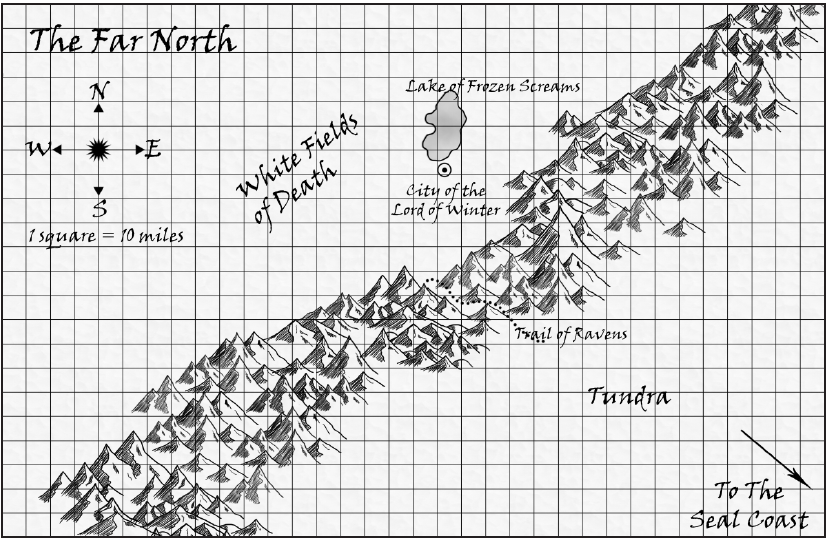
The first chapter is just the voyage to the foot of the mountains, and has no plot event or set-piece encounters of note. We get a description of the wilderness (tundra with poor game) along with random encounters which are the same as in Vengeance of the Long Serpent save they now include some more dire animals and friendly Ulnat hunters.
Yup, it's only 2 and a half pages. This must be a new record for lack of length.
Trail of Ravens and Beyond
This is where things heat up. This chapter is divided into two regions: first is the Trail of Ravens crossing through the Wailing Mountains. Travel is slower, the nights are longer and colder, and the random encounters include more dangerous foes. Two notable one-time encounters include a frost giant loyal to the Cult and a pair of Remohraz tainted by the demon-god's influence, along with ogres, normal trolls, and yetis (oh my)! 50% of the random encounter results are natural hazards from crevasses, avalanches, and blizzards.
The White Fields of Death are a vast plain of snow and ice. Technically this is part of the Lost Lands' northern pole, and no living soul, not even among the Ulnat, are known to have crossed its horizon. It may as well be endless, and being at the polar caps the sun doesn't seem to set for days. The environment here is harrowing; the reflection of the sunlight off the white snow can cause blindness for 1d4 days on a failed Fortitude save, and the place is so cold (-30 to -60 degrees Farenheit) that by a strict reading of the Pathfinder environmental rules characters will take 1d6 cold damage every minute regardless of the clothing they're wearing, no save. I can't help but think that this is an editing mistake, but the adventure itself refers to the Environment section in the corebook for cold dangers. There's no way a party without endure elements or cold resistance will be able to complete this adventure without dying of exposure, and food and crops here are non-existent. If you still want to maintain a "dangerous land" feel, I suggest delaying the damage to every couple hours, or a day if the group has no magical healing sources.
As there are no civilizations to hide their presence, Althunak's demonic minions are free to rule openly, and random encounters include several varieties of evil outsiders, including a unique encounter against a corrupted dire bear animal companion known as Blue Fang the Snow Bear:
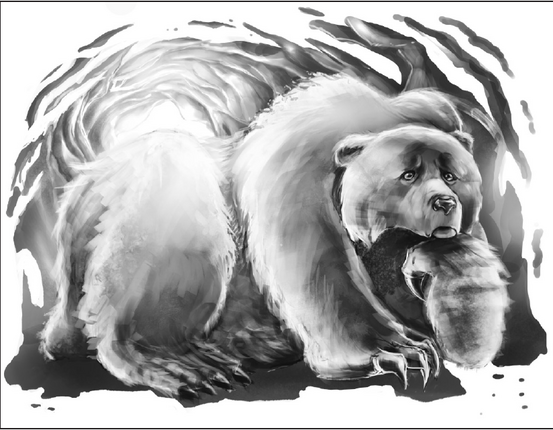
Awww, he looks so sad...
The only set-piece encounter here is an artificial blizzard over a lake of frozen corpses (remnants of Hvran's army). The creator is Kaliope, an Ulnat woman who is now a yuki-onna...an evil snow spirit from Japanese folklore.
What was that about not borrowing from other mythologies, Northlands?

Kaliope is the "boss" of this chapter. The blizzard is a constant environmental hazard which hinders the PCs, and Kalope resorts to hiding underneath the ice and grappling PCs to drown them. Once she dies the storm dissipates, and they get a +2 spear from her corpse for their troubles.
The Temple of Ice and Stone
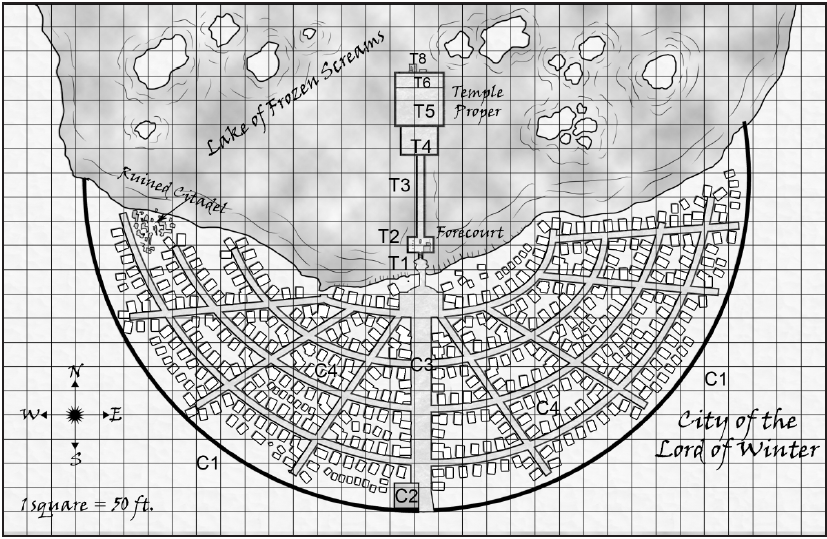
The final chapter covers the ruins of the City of the Lord of Winter, the center of Althunak's worship on the Material Plane. The city itself sits on the edge of an unfrozen lake in which the demon-god's corpse is said to lair. The statues and reliefs throughout depict the eternal-winter-cannibalism motif the Lord of Ice and Cold is known for. The city's natural defenses include the Lake of Frozen Screams (which deals lethal cold damage upon immediate exposure) and the outer wall (C1) which is rather simple in its lack of murder holes and armed patrols. The front gates (C2) have elite cultists known as Eaters of Men (Barbarians), and the main street (C3) has regular patrols of more Eaters backed up by shamans and ice daemon marauders as backup. The residential structures (C4) are the living quarters and contain cultists along with kidnapped Ulnat slave women who grant bonus experience for each one who is saved.
What I Changed: My players are too canny to just waltz in the front door and cruise down an open street, so I had ice daemons along the wall. Seeing them from stealth outside, the party elected to use the folding boat to sail along the Lake and scale the Temple. They did bypass the city encounters, but when it came to the dungeon they reverse-fought their way out of the Temple once their business was done.
The Temple of Ice and Stone is a 50 foot tall fortress with a granite foundation. It sits above the Lake of Frozen Screams and has a series of tiered bridges and chambers connecting it to the rest of the city. The Causeway Head has a great treasure, a pair of sapphire eyes on a giant statue of Althunak worth 10,000 hacksilver each. The bridge has a flight of gargoyles who can be bypassed with use of a ritual which can be figured out via Knowledge-Religion, and the entrance to the people proper has half a dozen low-level acolytes who are no real trouble for 6th-level PCs.
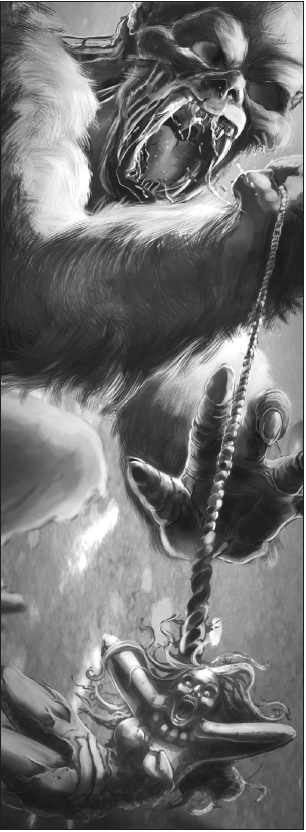
Elvanti awaits our heroes in the main cella (big atrium-like place) in front of a humongous statue of his dread lord. Elvanti, Chosen of Althunak and Oracle of the Perpetual Winter, has undergone a change into a hideous ape-like monstrosity in the intervening years. In addition to the 2 snow brides willing to battle at his side, Elvanti himself is pretty tough: he is physically focused, has spell resistance, a fly speed, and limited-use ice storm and call lightning spells which he can use thanks to open skylights in the temple. In fact, said openings are marked on the temple's maps and he will use it on exposed PCs, adding a tactical mini-game for movement and positioning. Elvanti can also turn others into Snow Brides by draining their Wisdom with a grapple, and invoke a save-or-die by encasing a victim in frozen ice as an inference of Kelvani's ultimate fate.
Should the PCs win, they find much in the way of valuables. The greatest treasures include: the crown on the statue of Althunak worth 20,000 hacksilver plus 29 crystals worth 21,750 hacksilver, a +3 icy burst greataxe etched with scenes of Althunak feasting on mortals and demons, and plenty of fine tapestries, silk, and various art objects.
What I Changed: I kept Elvanti's stat block the same but made his appearance a physical human. The previous adventure still had him as such, and I felt that having him be as mortal as everyone else made his evil feel more "real" and approachable, even if ultimately unjustifiable. I also swapped out the pair of snow brides for a babau demon who acted as his second-in-command.
The adventure mentions that the death of Elvanti is a great blow to the Children of Althunak, but this is still a setback rather than a full victory unless the PCs find a way to destroy the Temple itself or at the very least breaking down the statue. This will cause the forces to scatter to the four winds rather than rebuild. If any of the PCs are divine casters of a deity, then said gods will now know of Althunak's existence, causing the demon-god to go on the down-low and not wanting to risk a "battle he cannot win." Still, Althunak knows how to hold a grudge and from then on winters become colder, fires take more effort to burn and give off less heat, and remnants of his cult will go south to hunt for the ones who wounded them so in the form of suggested random encounters for future adventures.
What I Changed: Funny thing is, given that his presence dominated 3 out of 4 adventures so far, Althunak won't make a comeback until NS9. Yeah, they weren't kidding about him going into hiding. I more or less had his cult make a reappearance in NS7 as part of my rewriting process for that adventure.
On the plus side, the Ulnat are grateful for their victory. Any snow brides still alive turn back into human forms and will be the first to come forth with marriage proposals for PCs. And heroes who die are buried in a new cairn at Heroes' Rock. And speaking of Heroes' Rock, the spirits there give the party their blessings to keep their magical relics:
quote:
“Know that though beaten, the Icy Maw is not destroyed. He will return, and he will seek you out to slake his thirst for vengeance. Your very lives are now a quest against the Cold Dark, and your hands are worthy to hold the weapons that bear our legend. Go and keep these items with our blessing; may they protect you from the coming darkness."
What I Changed: There were no snow brides (and thus no marriage proposals), but Aluki (the male "Yilithi") wished to venture to the Northlands alongside the PCs after a farewell to her family and a promise from them to keep her safe.
Concluding Thoughts: The adventure's very linear, and slow in regards to having random encounters be a significant factor in the first two chapters. That is, if the party triggers them at all. But I did like the playing up of the eerie nature of the polar region and the "tactical weather" mini-game for Elvanti's fight. The less-knowledgeable PCs thought the "eternal sun" was witchcraft.
After a quest on a forlorn iceberg and two adventures in Ulnataland, it seems that it's been a while since the PCs adventured in the Northlands proper. Well the next quest makes up for that on a region-trotting journey where our heroes seek to lift The Death Curse of Sven Oakenfist!
NS 3: The Death Curse of Sven Oakenfist
Original SA post
NS 3: The Death Curse of Sven Oakenfist
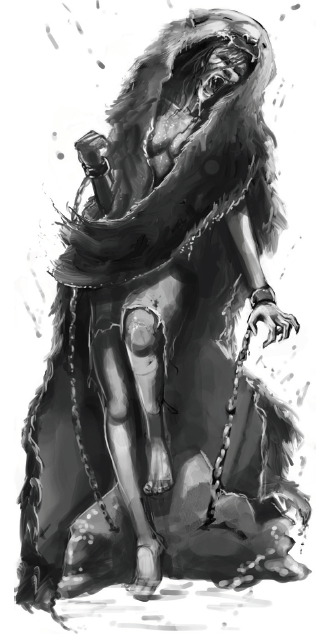
Oddly enough, this is the only Northlands adventure with unrelated cover artwork; there is someone chained to a rock in this adventure, but not a bearsarker. It's also for levels 7th to 9th.
After two adventures in Ulnataland, the Northlands Saga goes back to the heartland...literally, as the PCs are invited to winter at the hall of Jarl Anud Cursespear in Storstrøm Vale. The man is one of the most powerful men in the region, who although loyal, brave, and generous has also used various shady dealings to get more political power for himself. The adventure makes several suggestions as to why the PCs would be staying here (winter travel is hard and dangerous, owe a debt, family relative, etc) as well as a list of pre-adventure winter pastimes and random encounters while out hunting.
One of the encounters is notable. Whereas most are varieties of dire animals, owlbears, and Northlands aurochs, one involves five bandits ambushing the party. They use the Highwayman stat blocks from the Pathfinder Gamemastery Guide and are incredibly well-equipped, armed with magic spiked chains and potions of invisibility even though they have "fallen on hard times."
What I Changed: As Inga (now Jarl of Halfstead) was married to Anud's son, she was visiting the hall to meet her husband's relatives and requested the PC's presence. This also helped provide another strong hook for the PCs finding a way to undo the curse, as now she is part of Jarl Anud’s family and thus affected as well. My PCs also noticed that the bandits were extremely well-armed for common ruffians and became very inquisitive as to where they came from and who hired them. On the spot I made it so that Granny Ǽstrid, a senior of the Gat clan, was behind their employment. Jarl Anud was making several favorable trade deals with the Hrolfs, and the Gats did not like this one bit. This also helped highlight the legendary feud between the two families, which plays a major role in NS5: Raven Banners Over Gatland.
The actual adventure begins as an uninvited guest bursts open the doors of the hall with a deathly chill as Sven Oakenfist makes his presence known. A massive 8 foot tall, clearly undead Viking strides up to Jarl Anud. He accuses the man of being an honorless cur, followed up by a threat that on the Feast of Freyja he will return to the village and slay everyone there. And then he leaves just as suddenly by a gust of wind. Everyone in the hall is spooked out of their wits, and Jarl Anud is the first to speak. He explains of how Sven Oakenfist was the leader of a vicious band of bloodthirsty raiders who sought to attack while the men of the village were away a-viking, and how he as a boy slain their leader by striking at Sven with a spear. The raider, who has the blood of Odin coursing through his veins, laid a dire curse to gift Anud with wealth and power for fifty years, only for it all to be taken away in due time.
Anud also mentions that the accusations of dishonorability aren't as bad as any other jarl, and that Sven is the real honorless one for going after women and children. After a motivational speech of how it would be terrible to send his sons to die for him and how he's now an old man, if there are any heroes among the hall willing to put a stop to Sven Oakenfist's dire premonition.
Naturally, the adventure assumes that the PCs will rise to the challenge.
What I Changed: I also had it so that the community's Thing was taking place, and the longhouse had Anud resolving various disputes between local families. When Sven Oakenfist burst in, he taunted Jarl Anud into attacking him in a blind rage, which during the Thing is a major faux pas (violence is only acceptable via holmgang). As a powerful spirit his blows were useless. The party skald saved the Jarl's honor by complimenting his supposed canniness:
quote:
Good thinking my Jarl, checking to see if he held such a trick. How can one duel something that is not of flesh and blood. I'll get right on crafting you a weapon that can deal damage to your challenger! Had you not done that, a most dishonorable trick would have been pulled on you!
I also changed the backstory so that Jarl Anud, as a twelve-year-old boy, snuck up to Oakenfist's camp while he was asleep. Taking a spear and coating it with animal dung, he snuck into the raider's quarters and stabbed him in the heart before making a run for it. He could not win in a straight fight, but Anud wanted vengeance, and vengeance he got when Sven died an ignoble death in the wilds as his feet finally felled him. I also deleted the whole "well I'm not really that honorless" part of the speech and made it so that Anud had a fear that sending members of his own hall on the quest would fold into the curse (if they die on the journey, then Sven is reaping what he sown). This was to make his part seem more justified and throw off cases of suspicion (“maybe the crooked jarl really the one in the wrong?”), as Anud’s “dishonorable past” doesn’t come into play here or in later adventures.
The Daughters of Skuld
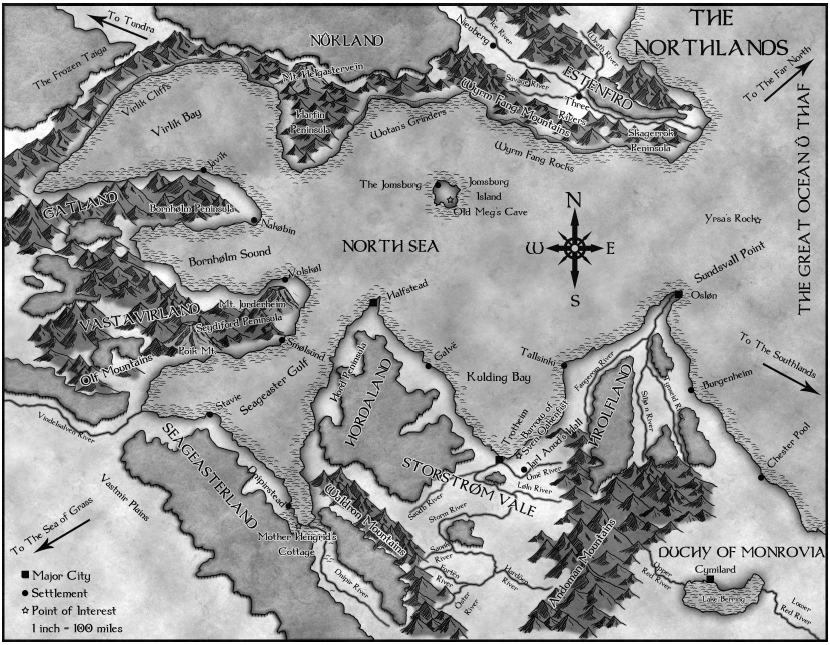
Fun fact: this was the original 2011 map of the Northlands.
Given that a death curse by a divinely-descended being is super-strong, it will take equally-divine power to undo. Via the rolling of one of many Knowledge checks and/or the hiring of sages, the PCs can learn that the only people capable of this are the Daughters of Skuld, half-divine women living within the Northlands along with their locations. The majority of this adventure involves visiting them and overcoming their trials and can be visited in any order. The PCs can even visit one , two, or none at all and head directly to Oakenfist's barrow. This is inadvisable as the specific undead monster he is depends on the amount of Daughters which have been visited (from a mighty CR 17 winterwight to a meager CR 6 specter). Each Daughter has a theme: they are all quite mad, and their obsession is acting out a certain folkloric archetype which the PCs must cater to in order to secure their cooperation. The PCs will also need a ship to visit them (Yrsa and Old Meg are on islands) which can be rented out.
The first Daughter listed is Yrsa the Fair, who is chained to a rock on an island between the straits of Hrolfland and Estenfird. She is quite literally a Damsel in Distress, and takes note of any PC who acts chivalrous in trying to come to her aid. But just like in the storybooks, a simple breaking of chains won't do as a shadowy dragon known as the Shrieker of the Dark attacks the island! Once the beast is slain Yrsa allows herself to be freed. She rewards each party member with a magic item personalized to their role if they were courteous, along with a tale of a nimble bird who tricks a serpent into biting itself as a hint to use the very spear which slain Sven Oakenfist. Personally this is a bit counter-intuitive (it sounds like one needs to trick Sven into attacking himself) so I'd suggest rewording the tale if the PCs don't pick up the meaning with a Knowledge check.
Also Yrsa will visit one PC who stood out as courageous alone at night. She basically offers to have sex with that character as a reward, and if the PC accepts they gain a divine boon where up to 3 times they can reroll a single d20 and take the better result. But if they turn down her advances for any reason, she curses them with the opposite: the GM can force a reroll and take the worse result up to 3 times.
What I Changed: Aside from the coercive nature of "have sex with me or I'll curse you" the whole reward-sex trope is kind of creepy to do especially when it's from an NPC who's a complete stranger. I merely had her kiss the forehead of the troll-blooded PC as a sign of affection and thus give the boon that way.
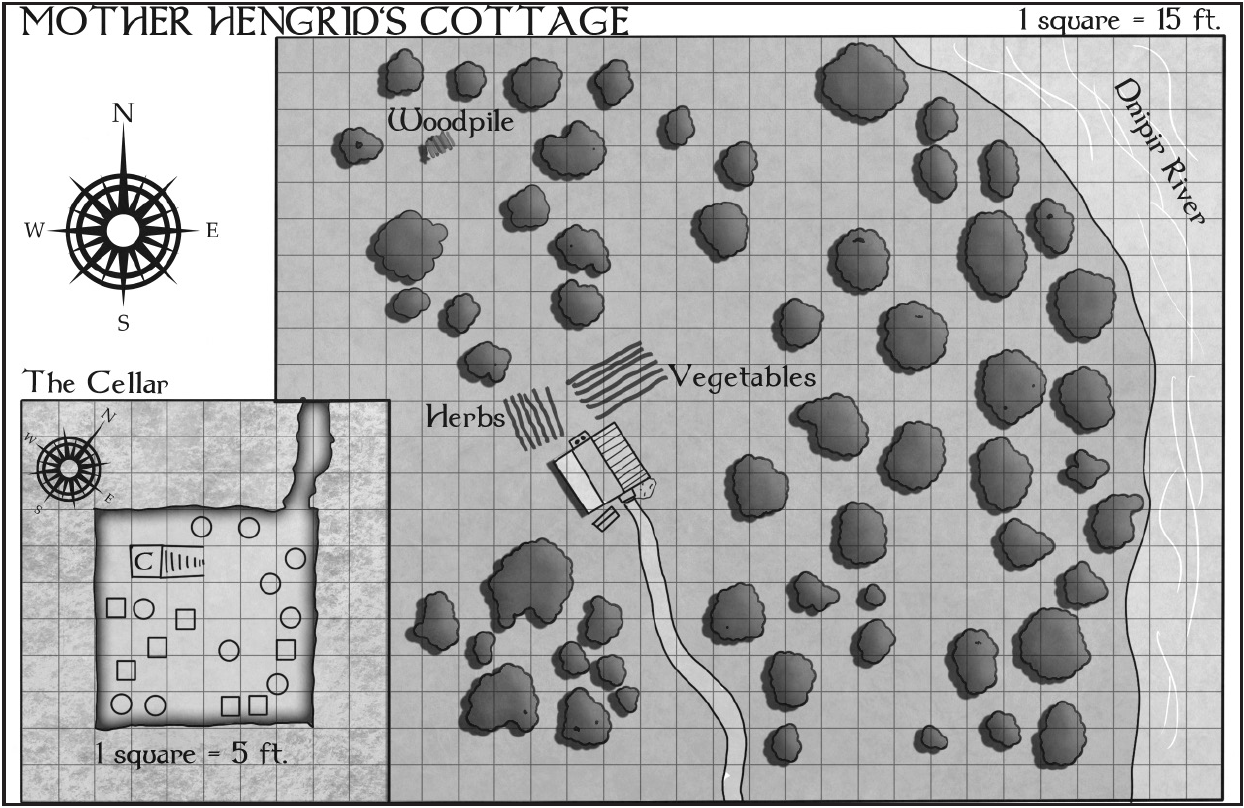
The next Daughter is Mother Hengrid, a woman whose cottage is located within the wild forests of Seagestreland. When the PCs set foot on shore they are attacked by Mongat raiders, fantasy counterpart Mongols from the Sea of Grass. The Mongat all ride on horseback, but their superior mobility is hampered by the many trees preventing charge attacks. PCs lassoed or captured will be taken back to their camp to be put with other prisoners there. The camp is also its own encounter.
What I Changed: I replaced this encounter with a Northlander trader negotiating with some Seagestrelanders versed in rune magic. The trader was one of the followers of Hengrid Thorsdottir, an NPC who plays a major role in the next adventure, Blood on the Snow. A group of Jomsviking raiders hunting for loot and slaves ambushed the negotiations, causing things to fall into a free-for-all. The PCs who stumbled upon this learned the extent of what was going on, and the Jomsvikings were none too friendly so it wasn't hard to take sides. After saving the trader and Seagestrelanders, they met Thorsdottir in the village of Dnipirstead, where they learned she was gathering hired help to fight the Beast Cult up in Estenfird. Due to being on a current adventure, they could not join her at the moment.
After several days of forest exploration, the PCs stumble onto Mother Hengrid's Cottage. It has no true location and often moves of its own accord to make it easier to find for those seeking it. Mother Hengrid acts very much like a doting parent: she believes that the PCs are children playing at adventurers and alternates between supplying them with good food and cleaning their equipment, while also ordering them to clean themselves up in a giant hot bath and do various chores. As a half-divine woman she is incredibly powerful, and attempts to refuse her cause "naughty" PCs to teleport into her basement for a time out. A basement which can spawn giant insects as random encounters (but are not too tough CR wise).
Mother Hengrid will not discuss the PCs' quest or Sven Oakenfist's curse, saying that now's not the time and instead asks them to help out with three chores. The first chore involves fetching firewood...guarded by an angry lumberjack troll; filling a cauldron with water from the river...where 10 giant frogs wait to attack the party; and feeding the dogs out back...who happen to be yeth hounds who only fight momentarily before running off with their morsels. PCs who point out the danger of the tasks meet the excuse that they are things "big boys and girls can handle easily." She is kind enough to use healing magic on the party if they get injured, though.
Only once the chores are done does Mother Hengrid explain a way to undo the curse: find the hand that slain Sven Oakenfist, and have it slay the wight. Before sending them off, she gives each PC a stew-stuffed gourd which is able to heal the drinker as well as restoring spell slots and days-per-use abilities. However it spoils in a month, meaning you should encourage the players to use it during the course of the adventure as the next one takes place several months afterwards.
Continued in Next Post
The Death Curse of Sven Oakenfist, Final Part
Original SA post
The Death Curse of Sven Oakenfist, Final Part
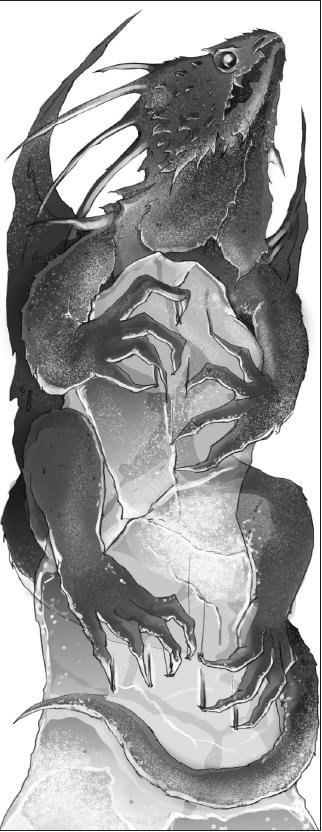
The final Daughter is Old Meg, who lives in a cavern on the southern end of the Isle of Jomsburg. She is not a member of the Jomsvikings and has no relationship with them, but the location of her home and the island's dire reputation make it so that she never has to deal with unwanted visitors. We get a brief description of the island: tall cliff walls on all sides and a fortress-city up above. Plenty of siege engines, plus sea caves at the water level are used to store their ships for a highly defensible location. As for Old Meg's Cavern, it is up a 300 foot high cliff face above a rocky reef which requires Profession (Sailor) and Climb checks to make it up safely.
The cave has no defenses aside from a pack of ice drakes who attack anyone who does not drop an offering of a marked token (there's a bunch of them in an alcove) in the pool at the entrance. The flash-frozen corpse hurriedly dunking his hand into the pool, token in hand, provides a hint of what to do. Further inside, the party comes face to face with a frozen menagerie of legendary heroes of the Northlands thought dead or missing. The adventure gives a detailed write-up of their names, heroic deeds, and magical items encased within them.
In my game, this caused the party skald to hate Old Meg with a passion.
Old Meg huddles in a small chamber with a fire, and she very much acts like the Creepy Old Woman Who May Be a Witch archetype. She offers to help the party, but only if they abide by the laws of her house: speak not of what occurs here beyond that they ventured into her cave and later came out, nor tell others of the boon they sought and gained from her. Only after swearing an oath will she present her challenge.
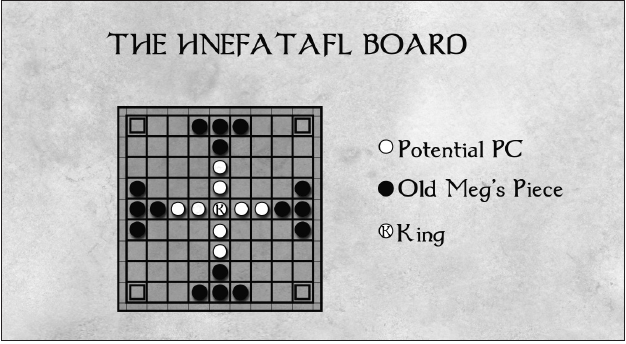
The PCs must beat Old Meg in a game of Hnefatafl, a real-world ancient Germanic and Celtic strategy board game. However, the pieces used are all but one Player Character shrunken down to fit on the board (excess tokens are allied bugbears), and the opposing side are bugbears. The PC tokens are moved about by a character who elected to be the player (who I’ll refer to as the chessmaster), and Old Meg controls the bugbears at the north, south, east, and west ends. There are several rules to how the game is played, but I'll boil it down to the essentials:
1.) The PCs win if the central "King" piece escapes to one of the four corners of the board, which takes on the visage of Jarl Anud. Old Meg must kill the PC tokens to win the game.
2.) The minigame uses the PCs' real abilities and attacks, but their movement is controlled by the chessmaster who moves them around like tokens on the board.
3.) In lieu of initiative the chessmaster goes first, moving one token. Old Meg does the same with her own pieces. After both sides go, the chessmaster may move the king.
4.) Pieces must be adjacent to each other to attack, even with spells and ranged abilities, and attacks of opportunity are not triggered for movement. The king cannot be attacked.
5.) When a token attacks an opposing piece, the attacked can make a single attack to counter.
6.) Old Meg interrupts the game six times. Three to ask a riddle, and three times to cheat. If the chessmaster guesses correctly, he gets to take two turns. Guess wrong, and Old Meg takes an extra turn. Old Meg cheats by casually bumping the table, sending 1d4 pieces to move up to 3 squares away of her choice.
Now bugbears are quite easy to fight at this level of play. As the party goes first and the king cannot be destroyed, they have things in their favor. The only difficulty I can foresee is for players who have a naturally low AC/HP combination and may be easy targets for the bugbears, or whose abilities are tied up in being mobility or save-or-lose. The odds are good, although if Old Meg wins, the defeated PC tokens become permanent board pieces and the chessmaster is told to leave or join the other frozen heroes of old.
If the party win, each PC may ask one boon of her: either the taking of a magic item from one of the frozen heroes, or ask about the Death Curse (one PC can ask while the others get treasure). Meg gives a premonition which basically states that there's a chance the curse may be lifted if Jarl Anud sacrifices himself.
Remember that oath Old Meg made the PCs swear? If any of them go back on it, the entire party's teleported back to the hnefatfl board and must win to gain their freedom.
Riddles posted:
1. “A wonder on the wave, water becomes bone.” Answer: ice on a lake or sea
2. “I’m told a certain thing grows in the corner, rises and expands, and throws up a protective crust. A proud wife carries off this boneless wonder, and the daughter of a king covers that swollen thing with a cloth.” Answer: bread
3. “What lives on its own substance and dies as it devours itself?” Answer: a candle
What I Changed: I made the dire mistake of revealing the rules for this minigame during the game session rather than beforehand, making it so that a few players had to stop in-media-res to get a proper sense of things. I also discarded the riddles and 2 of the cheating features on account that the addition of new "rules" was forestalling the flow of play.
The Barrow of Sven Oakenfist
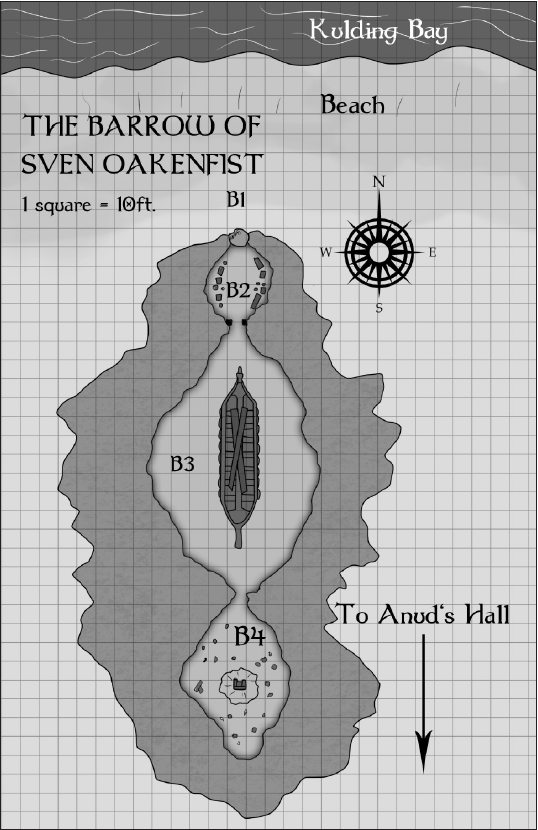
At some point the PCs must confront Sven Oakenfist, right in his barrow which is conveniently several miles away from Jarl Anud’s hall. This is not to be undertaken lightly; depending on the information they found, they may need the presence of Jarl Anud Cursespear and/or the spear he used to kill the undead wight. The power of the curse is that Sven will rise again at full strength in 1d4 rounds if defeated unless one or both conditions are met. There's a 25% chance of slaying the wight permanently if someone other than Anud uses the spear, but if Jarl Anud wields it the chance increases to 75% or 100% if he strikes a flat-footed Sven. The other 100% chance is if Anud is convinced to willingly sacrifice himself to the wight. Fortunately the spear is still in Jarl Anud’s possession and doesn’t require its own quest to find.
If Anud accompanies the PCs, he takes a group of huscarls and several sons to accompany him, but waits outside until the PCs cleared each room but the final one. At this point he follows them inside.
What I Changed: It feels a bit cowardly to have a jarl show up with a small army only to make the PCs do the dirty work themselves. I had him accompany the party inside the dungeon on the first room. This made him seem more of a proper leader and added in the complication of ensuring his health to reach the final room.
The dungeon itself is small and linear, with several undead vikings and thralls animating to attack. In Sven’s life he was egoistic enough to be buried with his own ship, which has some secret compartments containing treasure. The quest’s villain awaits our heroes in the final room, accompanied by 10 skeletal huscarls.
quote:
"Hark, for I see you have come to seek your own wyrd, that to die at the hands of the Jarl of the Sea and his loyal huscarls. Have then, and let the battle-dew fly from our thirsty steel serpents! Commence the slaughter, my brothers, and let none escape!”
Gotta hand it to Oakenfist. He's the most eloquently-spoken bad guy so far in this Adventure Path. Once he is killed for good, his minions de-animate and the very tomb begins to crumble. PCs can take the time to grab 1d6x10 hacksilver worth of valuables per round, although the entire structure collapses in 2d12 rounds and instantly kills all within (no save). Now I do not know if by "tomb" they meant the final room or the whole complex; 2d12 is a very swingy number. Although it's possible the party may have access to Dimension Door (mine did) or teleportation effects, given the length of the dungeon low rolls may as well spell the death of the party if it’s meant to be the entire complex.
What I Changed: I did not roll for the time limit. I only would have if PCs got greedy or dilly-dallied. Also not a change per se, but one of the PCs grappled Sven Oakenfist to expose his wound to Jarl Anud to strike the killing blow. It was within the flat-footed parameter ruleswise, and it worked well.
If the PCs are successful, Jarl Anud (or his heirs if he's dead) awards the PCs magic items according to their personality: the greatest warrior gets a Frostbrand sword, the slyest PC gets a rust-covered bag of tricks, etc. Each magic item also has a small explanation of how the jarl came upon it in his earlier adventures. But there is one treasure meant for the whole party: the Tusked Whale, a fully outfitted longship complete with a crew of 50 from the jarl's household now in the PCs’ service!
Concluding Thoughts: The Death Curse of Sven Oakenfist rates highly. It is an open-ended sandbox where just about every major task has some puzzle-like element to solve or quirky plot element in the case of Mother Hengrid. The battle with Sven Oakenfist is a definite highlight, as it forces the PCs to hold their ground for proper conditions rather than batting the enemies' health to 0.
Next time we wage war on the Beast Cult of Estenfird in NS4: Blood on the Snow!
NS4: Blood on the Snow
Original SA post
NS4: Blood on the Snow
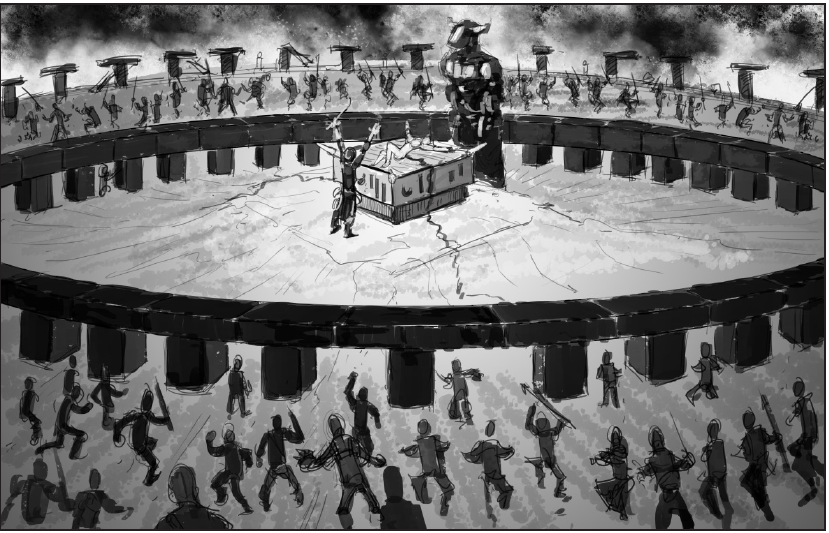
Hengrid Donarsdottir is one of the most famed living heroes of the Northlands. Descended from the legendary god of thunder himself, she is the Beast Cult of Shibauroth's greatest threat in Estenfird. As a result the foul worshipers of the demon-god are engaging on an unprecedented campaign of terror to lure her into taking a siege position in Three Rivers. With a major desperate strike they hope to kidnap the Daughter of Thunder and Storms in order to sacrifice her to their deity. The PCs can get involved in the adventure are in a variety of ways: perhaps they heard Hengrid's call to arms across the Northlands, they have personal ties to Estenfird, a religious or divine caster receives visions from their deity to venture here, or some other reason for being up there.
Blood on the Snow is part wilderness trek, part strategy wargame recommended for 8th to 10th level parties. The PCs begin in the port town of Vöss and must visit villages on their way to convince the local hirthmenn (militia) to march with them to Three Rivers. Complicating matters is that Estenfirders use an anarchistic direct democracy model and thus the PCs must win over people at the local Things via social skill checks. Single target enchantment spells won't work due to the political structure. Additionally many warriors are reluctant to leave their families behind in the fear that their communities will be less-defended from Beast Cult attacks. The higher their social skill check at the Thing, the more hirthmenn join the PCs' number.
Random encounters up to Three Rivers are assumed to be larger skirmishes, with the presented enemies being the forces the PCs must deal with (be they cult leaders or VIPs). To simulate losses among the hirthmenn, the adventure suggests adding up the hit point totals of all the PCs and cohorts and doing a 'health roll call' at the end of the encounter. If the party lost 25% of their hit points, the hirthmenn suffered 25% casualties. Army minutia, such as equipment, supply lines, etc are not dealt with in favor of personalized heroism.
While at communities the party can use Diplomacy and Knowledge skills to gather information about the Beast Cult. A particularly high Knowledge skill can reveal the Beast Cult's true plan as well as the fact that the cultists bear runic tattoos with protective magic. A sidebar also suggests having arrogant cultists unwittingly give away their plans as a demoralizing tactic if the PCs did not catch on: explaining how they plan to capture Donarsdottir and rape her, and (if they already caught her) how they already have her at their secret lair to sacrifice to their god. All this is mixed in along with taunts at perceived weaknesses of the PCs.
What I Changed: Whelp, another sexual violence inference to delete for my home games. In fact, this adventure is a bit more heavy on this subject matter than the others. Beyond the taunts, one of the information gathering skill checks reveal that the Beast Cult are fond of raping the villagers of settlements they attack, and Hengrid Donarsdottir is naked and bound on the altar during the final encounter.
On the more tactical side of things, I also added an involved mini-game of hired help to supplement the local hirthmenn. Mercenary groups both foreign and local were in the various towns the PCs could visit. They ranged from democratic revolutionaries from Bard's Gate (who find Estenfird's style of government appealing) to Monrovian knights searching for a cure for their cursed king (who is not cursed in the standard setting). They each had a mini-encounter for the PCs to complete in order to have them march with the army. I may post a more detailed post on this, as otherwise the various factions and their quests would take up too much word count here.
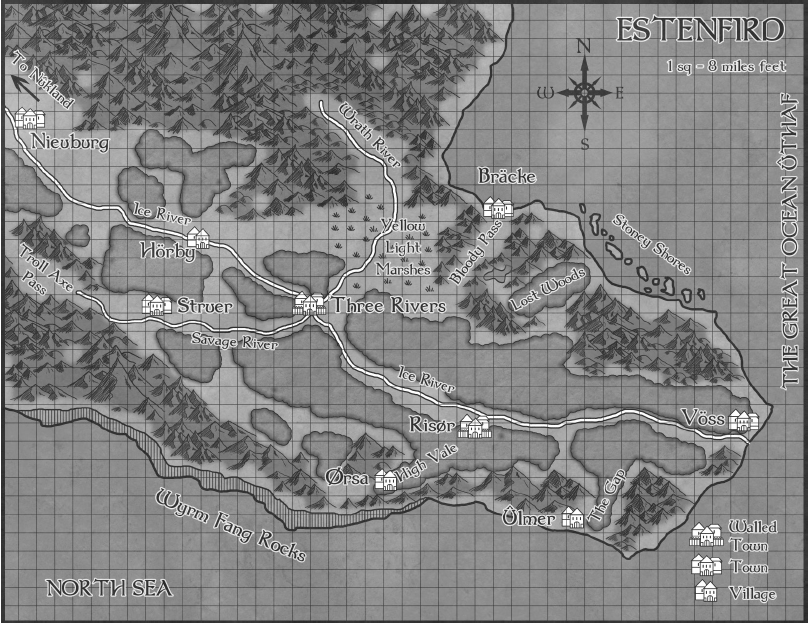
There are some random encounters on the way: cultists attacking a village, an empty destroyed settlement, sabre-tooth tigers, and even a sapient tree who strangles its victims to death. There's a one-time encounter where the PCs can gain the aid of a mythical creature known as the Great White Stag who knows all the safe, secret routes of the forest. He also tells them about a planned ambush near the town of Risør, a later set-piece encounter.
Halfway between Vöss and Three Rivers is the village of Risør. Although walled and relatively safe, the place is near-full capacity as farming families and their livestock seek refuge behind its fortifications. The hirthmenn are aware of Donarsdottir's call to Three Rivers, but are fearful of doing so in that they believe the Beast Cult is close to their settlement. They are right, as there is a large force waiting to ambush the hirth army. This is the last set-piece encounter of Chapter One, and includes 10 Beast Cult warriors, 3 trolls, and 5 worgs complete with a rolling log trap. But if the PCs gained the aid of the Great White Stag, they use a secret route to ambush the ambushers and gain an automatic surprise round!
One thing I'd like to mention: the human Beast Cult warriors are meant to be the mooks of this adventure in the form CR 3 human barbarians. However, they have extremely high hit point values while raging (67) and their runes grant them barkskin, bull's strength, bear's endurance, and freedom of movement along with immunity to mind-affecting effects. This grants them 26 Strength and Constitution also while raging for very high attack and damage values for enemies of their level. The runes can be dispelled via an erase spell, but the 20th Caster Level (!!!) makes this a challenge for 8th-level PCs. And it wouldn't matter in the heat of combat, given that the adventure expects the PCs to take on around a dozen or more per battle along with various monsters.
What I Changed: Needless to say I nerfed the beast cultist's hit point values to avoid overly-long combats. Besides our party witch, save-or-dies were not my gaming group's strong suit.
Continued in Next Post
NS4: Blood on the Snow Part Deux
Original SA post
NS4: Blood on the Snow Part Deux
The Battle of Three Rivers
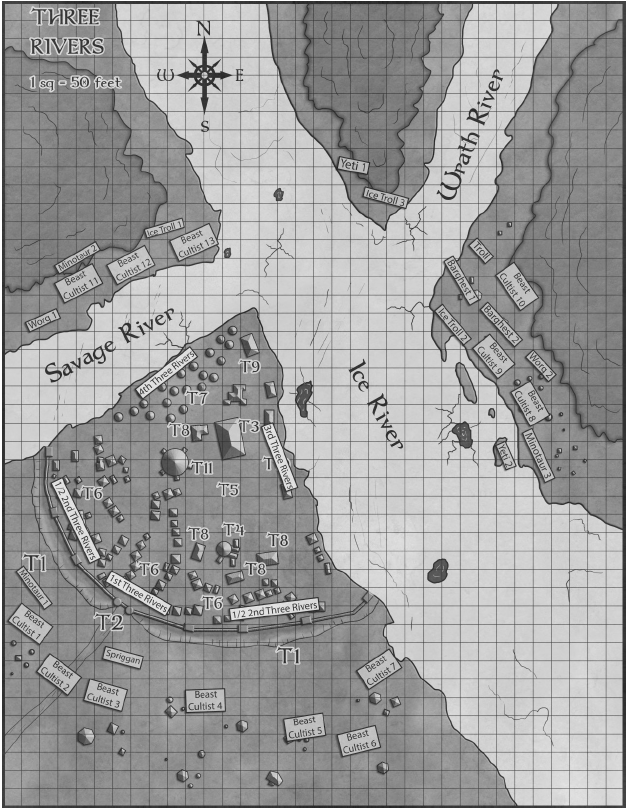
When the PCs and their army reaches Three Rivers, they find that the Beast Cult arrived well ahead of them. Warbands in loosely-organized encampments burn fires throughout positions in the forests. Fortunately the bad guys cannot mount a united front (yet) and loud squabbles are common enough that PCs can use Stealth/Disguise checks to sneak their entire army to the gates of Three Rivers. On a failure they'll have to deal with an encounter and potential battlefield casualties. Once inside the town's walls the PCs' hirthmenn unite with the local defenders, and the party can position themselves where they wish among the town map. Aside from a few healing potions and scrolls the PCs do not have much time to plan or rest, for the Beast Cult makes their move shortly after their arrival.
The adventure suggests two options, and the GM is free to use one or both: first option is to present a series of random and set-piece encounters during the siege where the PCs take out key warbands. The amount of hirthmenn recruited has an effect on encounters in the form of reducing the numbers, hit points, or both via a percentage value to represent injuries and casualties from superior forces. The second option is to make use of Pathfinder's Mass Combat Rules, and statistics for army units on both sides are provided. This would be a cool idea save for one minor detail...
The Battle of Three Rivers is meant to be an unwinnable encounter. Not only are the hirth militias shitty in power, the beast cult units are both more numerous and stronger. The idea is that the town will fall, and the PCs discover the cults' real mission and set off to save Hengrid Donarsdottir. As this is the first time the Mass Combat Rules are used in this Adventure Path, thrusting them onto first-time players only to not make a difference in the long run is Bad Game Design.
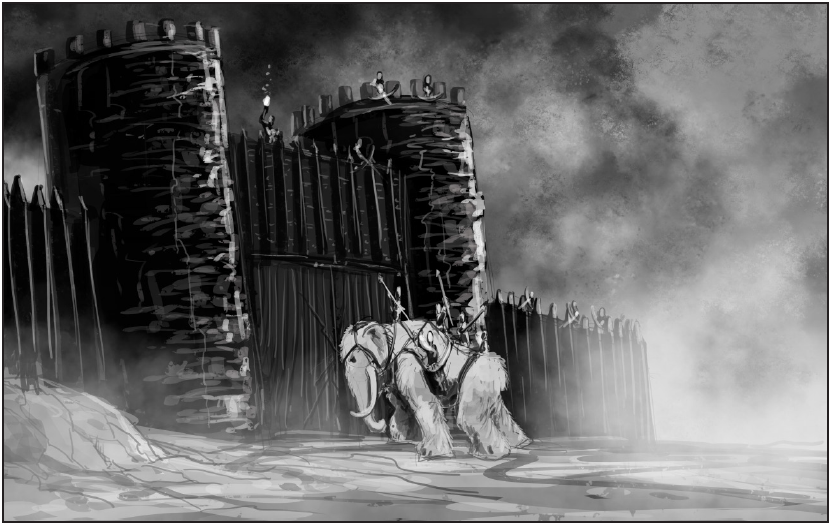
Several major encounters during the sack include a war mammoth brought from Nûkland to bash down the southern gates, fire drakes setting the Great House of the Gods ablaze, and a giant demon-badger burrowing a tunnel into Three Rivers' farmland (T5). The last encounter is quite deadly in that the badger immediately lets 48 cultists through until the tunnel it leaves behind plus 20 more per minute until it is collapsed. Jesus Christ, running this last encounter'll be a nightmare unless you use the Swarm, Mob, or Troop templates to simulate large numbers!
Hengrid Donarsdottir stands guard over the Allthing, where the town's women, children, elderly, and wounded are being kept. She is amply fighting off cultists and giants with her mithral hammer Thundersurge. Hengrid is a level 12 aasimar Fighter. Sounds like a good ally to have on the PCs' side right? Nope, in reality she's a Faux Action Girl with no stat block for this adventure and will get kidnapped by a flame drake offscreen after being overcome by her wounds.
What I Changed: Hoo boy, where to start? Well first off I beefed up the Hirthmenn and nerfed the human Beast Cult army units who are amusingly more powerful than the monster units. In addition to the Hired Help I added some units representing common Northlands archetypes: Cunning Women as magical medics, Shieldmaidens as defensive fighters, and Bearserkers as glass cannons. I made it so that the number of recruited hirthmenn added bonus token units on the map. I used an ultra-simplified version of the Mass Combat Rules, given that this was a small-scale siege meant to be done within an in-game day rather than a long, drawn-out war on many fronts. The last part is what the rules were originally meant to simulate.
I also had it so that the Jomsvikings were helping supply the Beast Cult with weapons and advanced military tactics. In my campaign the organization was hired by the Empire of the Huun, a major superpower in the Lost Lands' eastern continent. Their mission was to weaken the Northlands for invasion by sowing political discord, including exacerbating the Gat-Hrolf feud. The fall of Estenfird and the defeat of Hengrid Donarsdottir is meant to serve as a severe morale blow. The Empire of the Huun in the default adventure path otherwise has no presence until NS10: the Broken Shieldwall where they show up out of nowhere.
I ran both encounters and used Mass Combat Rules, the former of which were interspersed between rounds of mass combat. I divvied up the flame drake, war mammoth, and dire badger (reflavored as a giant worm) as three major encounters happening at once: this forced the PCs to choose which to prioritize in handling personally while letting the other defenses weaken. In keeping with the Beast Cult's true goal, I had it so that the bulk of their forces massed among the south as a diversionary tactic so that the riverside groups and flame drakes had an easy strike at the Althing. The players came up with an interesting plot to use charges from the wand of fireball as well as strategic ice-breaking to weaken the iced-over river on the east side. One of the players mentioned that even in winter, the river beneath is still flowing, therefore it will be a "pull" on the fractured ice to further weaken it to heavy loads. I don't know if this works IRL, but it sounded plausible enough for the game.
I also changed the plot around so that Hengrid Donarsdottir knew of the Beast Cult's plan to sacrifice her. However, as their tattoos also had anti-divination abilities (my addition) her plan was to let them capture her so that one of Three Rivers' godi or cunning women may scry on her position. This way they can locate their central headquarters and strike them down once and for all. The PCs burst into the Hall of the Althing and saw Herjof the Bloody-Handed, the Cult's leader, tying Hengrid's unconscious form to a flame drake. The party fought him and cut the ropes as the hall collapsed around them; the skald scarred Herjof's runes to disable his runic protections just as the cult leader contingency-teleported back to the lair. The PCs were understandably angered at Hengrid putting so many lives at risk, but they used this temporary advantage to scry on Herjof's location.
The Stones on the Marsh
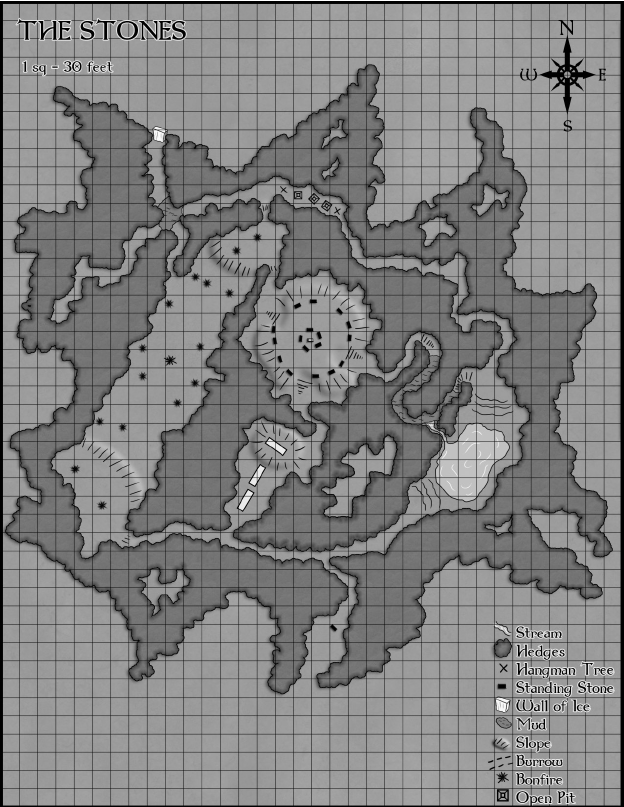
Once the Beast Cult flies off with Hengrid Donarsdottir, small warbands retreat while others stay to plunder the town. This final portion of the adventure assumes that the PCs give chase. The cult's lair is in the Yellow Light Marshes, a realm with a foul reputation home to will-o'-wisps aplenty. Random encounters here include both the aforementioned glowy balls of death as well as a "winter worm" remorhaz. The Stones are a man-made array of standing stones located within the huge tangle of a thorny hedge maze. Characters can move through the squares with overgrowth, but risk damage and poison. The various rooms here include various beast cultists and giants either on patrol or "baptizing" captured hirthmenn in muddy water with gradually sinking chains. There are also hangman trees, bog mummies, and evil fey such as redcaps to contend with here.
The climactic encounter is in area 11 at the Stones themselves. When the PCs arrive, Hengrid is bound and naked in the center, surrounded by blood-red candles and iron spikes overseen by a huge bull-headed statue. Herjof the Bloody-Handed is chanting a prayer in Abyssal while green hags sing a chorus in tune with the prayer.
This is a pretty intense encounter. First off we have 14 human cultists surrounding the stones, 3 green hags (who thus form a covey), an obsidian minotaur which animates in 5 rounds, and Herjof himself. The Beast Cult's leader is a tough guy, and perhaps one of the few NPCs who threatened my party with actual death. He's a 13th-level cleric with several save-or-die spells along with a bunch of battlefield control ones. Destruction, Disintegrate, Blade Barrier, Harm (which deals 130 damage at his caster level), along with some buffs such as freedom of movement and bulls' strength/bear's endurance are but a few of them. The obsidian minotaur and will tear out Hengrid's heart and eat it in 6 rounds after its own activation (11 rounds total) to complete the ritual. If Herjof is killed while it is animated, the minotaur will blindly rampage by attacking friend and foe alike.
If the PCs fail and Hengrid is sacrificed, a tide of blood and gore shoots out of the altar and foul omens simultaneously erupt across all the Northlands. The minotaur transforms into a thanatotic titan as Shibauroth gains an avatar in the mortal world and absorbs Donar/Thor's divine power. He will reign a path of destruction around Estenfird and begin to establish a dread domain. Given that the rest of the adventure path presumes Hengrid's survival, this is more or less a Non-Standard Game Over.
But if Hengrid is saved and the Beast Cult routed, a thunderstorm like none other will rain down on the Beast Cultists and all of their hidden lairs. Herjof, whether he's alive or a corpse, is burned in spontaneous combustion. The people of Estenfird have little to reward the party with, but the true treasure is a personal visit by Thor himself! One day the PCs find themselves lost in a fog, only to come upon a glorious hall where a party of unearthly proportions is held in their honor! After a night of revelry they wake up with some personalized magic items; and as a cherry on top, once per campaign each individual PC may have the favor of the gods intervene on their behalf in the form of a Limited Wish spell.
What I Changed: The PCs managed to save Three Rivers. Upon the disappearance of their leader, the warbands retreated; this left the more disciplined Jomsvikings to be captured or slaughtered by the hirthmenn. A few survivors holed up in a grainary and used the food supply as a hostage. Feeling betrayed by the Beast Cult yet unwilling to die needlessly, the PCs brokered a deal to tell them of the Beast Cult's plans in return for letting them go (once the Beast Cult was dealt with first).
The assault upon the Stones was done without any ritual, and I reflavored the divine storm to be that of the stone pillars overloading with magical power (which our party witch dispelled). The PCs spent a good time doing character development post-adventure. Due to a near-death experience at Herjof's hands our skald desired to part ways with the party as a means of bringing in a new PC next adventure. Combined with the fact that Hengrid didn't need saving and this made for a satisfying conclusion, I did not have them meet Thor.
Concluding Thoughts: Once again the Northlands manages to throw a novel mode of play every new adventure so far, this time in the form of a low-scale wargame. Blood on the Snow's a bit rougher than the others and needs additional tweaking, particularly the Mass Combat encounter. The final fight can be extremely deadly for even optimized parties on account of Herjof and his minions having superior action economy and debilitating spells.
Counting the two prequels, we are halfway through the Northlands Saga Adventure Path! Join us next time as we take the fight to the Jomsvikings directly in NS5: Raven Banners Over Gatland!
NS5: Raven Banners Over Gatland
Original SA post
NS5: Raven Banners Over Gatland
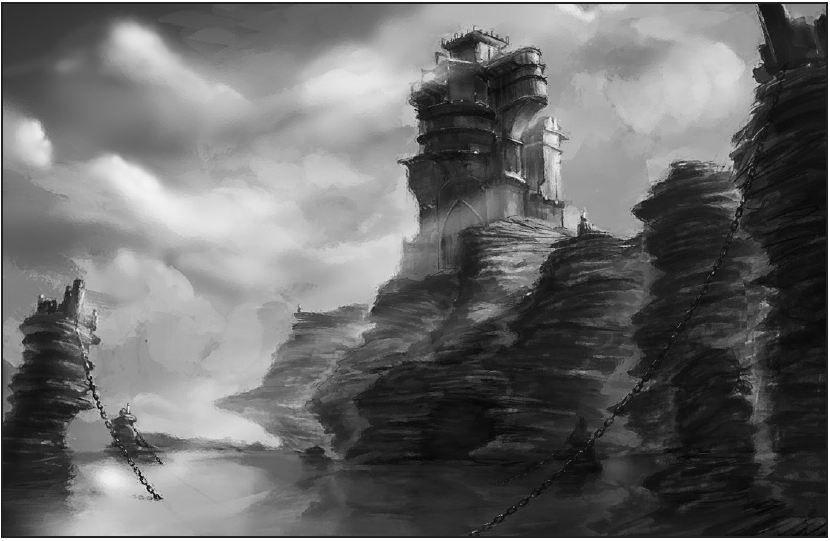
At this point in the Adventure Path, the PCs are most definitely heroes of renown especially given their last few quests. Even better, future plots make assumptions that they are famous rather than just random adventurers. Raven Banners Over Gatland is designed for parties of 9th to 11th level, and the first adventure proper to feature the Jomsvikings as a major antagonistic faction.
Fun Fact: The Jomsvikings have the same name as a semi-legendary order of Nordic mercenaries during the 10th to 11th centuries.
The backstory for this adventure is that the clan elders of the Gats and Hrolfs finally came to an agreement to end their mutual blood feud. Ljot Gatson and Magnus Hrolfsblood both agreed to marry their eldest heirs in Trotheim. As both wife and groom-to-be carry the bloodline of the last High Køenig, it also provides an opportunity for one of their descendants to regain that glorious title. Sveni Ljotsdottir was to sail into the city via a fleet of longships, but the Jomsvikings kidnapped her with the aid of weather and illusory magic. Naturally, this caused both sides to blame the other: the Gats blaming the Hrolfs for staging a kidnapping, the Hrolfs claiming that the bridal offering was but a ruse. Tensions are quite high, and the raven banners of war are being flown throughout Gatland.
The reason the Jomsvikings did this was because both clans are their biggest clients, and a peace treaty would be bad for business. Ten years ago they also made an exception to their male-only membership policy to recruit a witch by the name of Jasella. She gives them magical aid, which they used to conceal their ships. Our adventure begins while the party is traveling in the vicinity of Storstrøm Vale, perhaps as invitation to the wedding; Jarl Olaf Henrikson was an ally of the Gats, after all. And just like the start of a random encounter we open up with sounds of battle nearby. Njal Magnuson, heir of the Hrolf clan and husband-to-be, is under attack by Gat warriors. Already a score of them lie dead around the single man, and the boxed text shows off his desire for a fair fight when one of the attackers stumbles and trips but Njal lets him regain his footing.
Hrolfland for the Nords posted:
While simpering Southlanders might mock the beleaguered man for refusing to strike down a helpless opponent, PCs of Northlander stock will be duly impressed by his honor. Any Northlander PC that moves to help him receives an award of 100 XP for assisting a man obviously favored with the courage of Donar. Any PC who stands by and watches him fall (which he will in 3 rounds if not aided) or assists in attacking him receives an unfavorable wyrd and takes a –2 penalty on all attack rolls for 1 month as a result. It should be noted that even a PC who is a Gat receives this curse as mind’s-worth is thicker than even blood among the Northlanders.
The adventure presumes that the PCs will rush to Njal's aid. The Gat warriors are 11 strong already aided by potions of bull's strength. Now while 9th and 10th level PCs should be quite tough, the length and difficulty of this battle is predicated on the party make-up. The Gats are 7th level fighters with respectable HP and AC (78 and 22 respectively) plus they have good melee attacks and each of them wields +1 weapons and armor (wasn't this a low-magic setting?
 ). But their Reflex and Will saves are crap, their touch AC is a mere 12, and their sole ranged attacks are crappy 1d6 damage shortbows.
). But their Reflex and Will saves are crap, their touch AC is a mere 12, and their sole ranged attacks are crappy 1d6 damage shortbows.After the battle Njal thanks the party and explains who he is. He is suspicious of Sveni's disappearance because there was no wreckage of the ship nor dead bodies cast up on shore. While searching for clues he got attacked by Gatlanders and all his huscarls died in the attack, so he offers the party wealth if they help escort him to Trotheim. While on the way, they pass by a shephard's cottage which is randomly attacked by GIANT SCORPIONS from the Forest of Woe. The grateful shephards, upon recognizing Njal, explain how while watching their sheep they saw a strange fog following some dragon-headed longships. It seemed as though their presence was intentionally concealed by the weather itself. They began chasing another longship with white foxtails hanging from the spar (a Gatland ship). One final clue is that the fog-shrouded ships flew the banner of Jörumungandr the World Serpent, the symbol of the Jomsvikings.
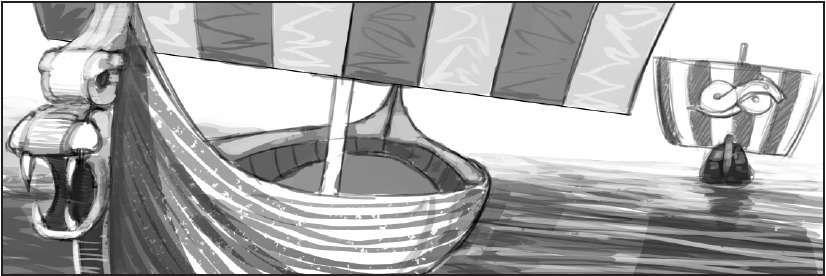
I just love how the giant scorpions are entirely incidental to this revelation. I have to wonder how the players imagine this tying into the greater plot if at all; then again, with all the giant animals the PCs encountered this is probably par for the course in the wild North.
Incensed at this revelation, Njal pays the PCs to escort him to Trotheim, and once there he gathers a crew to head back home and plan what to do. He adamantly refuses for the PCs to come with him, as it is A MATTER OF FAMILY HONOR.
 The adventure fast-forwards 1 month later (the book suggests running a sidequest or interlude) where the PCs receive an urgent summons to go to an isolated farmstead outside Trotheim. It is in fact is an invitation to a secret meeting between the Hrolf and Gat elders. The sender does not reveal much save that "rich rewards" are promised. Also no divination magic or skill checks confirm the source of the summons, but confirm nothing to indicate that it's dangerous. The adventure doesn't explain how the jarls have autofail anti-divination measure. I get that they're well-connected, but the PCs are famed heroes and likely great mages of note by now.
The adventure fast-forwards 1 month later (the book suggests running a sidequest or interlude) where the PCs receive an urgent summons to go to an isolated farmstead outside Trotheim. It is in fact is an invitation to a secret meeting between the Hrolf and Gat elders. The sender does not reveal much save that "rich rewards" are promised. Also no divination magic or skill checks confirm the source of the summons, but confirm nothing to indicate that it's dangerous. The adventure doesn't explain how the jarls have autofail anti-divination measure. I get that they're well-connected, but the PCs are famed heroes and likely great mages of note by now.Once inside the farmstead home, the PCs come into a dimly lit, tense meeting of the clan leaders along with a bunch of equally-surly huscarls. Jarl Magnus Hrolfsblood breaks the ice by thanking the party for saving his son, but mentions his son needs saving again. Shortly after Njal set sail to kick Jomsviking ass, his father received a package from Jomsburg containing a severed ear and ruby red earring worn by his son (the boxed text earlier noted it in Njal's description). As much as Magnus and Ljot would love to take the fight to Jomsburg directly, their children are hostages. Additionally both clans purchased the services of the Jomsvikings in the past, who will use this as blackmail material on them. As the PCs are known as Top Men who laugh in the faces of beast cults and undead vikings, the elders wish to hire the party to undertake a stealth mission into Jomsburg. They will reward each PCs' weight in rings as reward, but if they fail the Gat-Hrolf blood feud will be unstoppable.
Fun Fact: if Njal died in the earlier encounters, the NPC to be saved is his younger brother Finni who went missing. This doesn't have the same bite to it; I get that Finni may be a "replacement" groom, but the circumstances of the first few encounters played up Njal as an important guy (plus the whole "distinctive ruby ear" warning doesn't work).
What I Changed: I found the whole scorpion and "don't come after us" thing to be a bit counter-intuitive in terms of PC motivation. Of course the players are going to bite down on the adventure hook, especially if it's to prevent the Northlands (and likely their homes) from becoming a raven's feast. I had it so that both Sveni and Njal were kidnapped before NS5's onset. The beach encounter was replaced with Granny Ǽstrid fending off a group of generic raiders. She mentions that while en route to Trotheim, her longship was attacked and ran ashore. Sveni was kidnapped in spite of the crew's best efforts and she was the sole survivor. The PCs investigated the nearby longship and noticed footprints of differing sizes in the sand: those of humans and common giants alike. With some Knowledge checks the PCs realized that the only group in the Northlands other than the Beast Cult who has non-hostile relations with the Jötnar are the Jomsvikings. She took them to the secret meeting in Ljot's place save it was in a seemingly abandoned building in Trotheim. I had Aluki (Leadership cohort character) suggest the idea of infiltrating Jomsburg by commandeering a Jomsviking vessel at sea and disguising themselves as the crewmembers they slain.
Navigating Hostile Waters
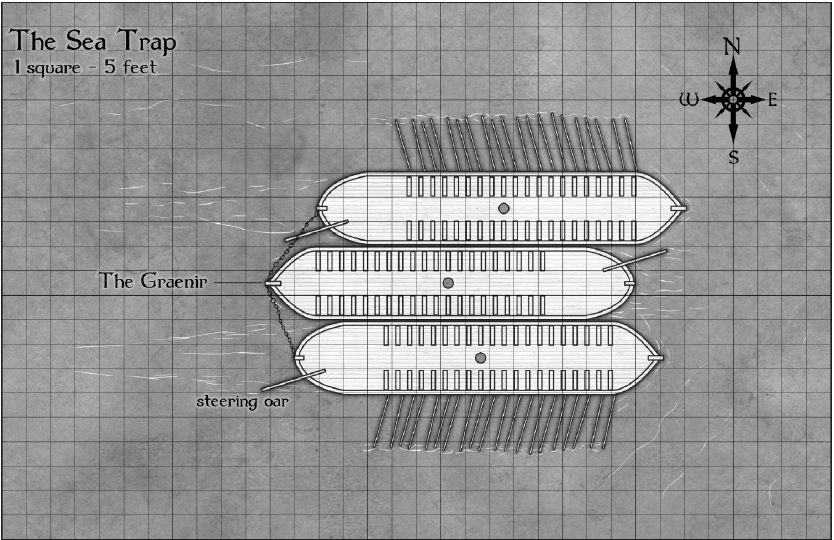
The PCs are lent control of the Grænir sea vessel in Trotheim's docks...which has the exact same ship stat block as the Tusked Whale. The voyage to Jomsburg Island calls for every 12 hours of sailing. The first two set-piece encounters are ho-hum (draugr undead sailors and four sea drake scouts working for the Jomsvikings), but the real fight here is when a pair of Jomsviking vessels cloaked in mirage arcana spells sneak up on the boat. The captains are not spellcasters but use rings of spell storing developed by Jasella to do this. They dematerialize when they're close enough that the PCs' ship cannot outmaneuver them, hoping to wedge the trapped vessel between them and clip their oars! We get a detailed one-and-a-half page description of naval action the PCs can take and how the Jomsvikings will react.
This is one of the more infamous "mook swarm" encounters in the Northlands Saga. Between the two Jomsviking longships is a total of 78 Jomsvikings along with 2 officers and a pair of common giants. Although the enemies attack 20 at a time, they still have 10 more to act as archers. The jomsviking rank-and-file are 4th level Barbarians with 51 hit points each, but the rest of their stat block isn't anything special. Combined with the Beast Cult last adventure, I have to wonder how the designers expect these encounters to be run. Was their entire party made up of blaster casters and battlefield control specialists wiping out a dozen enemies each with repeated castings of Fireball and Black Tentacles?! Killing half their number allows for an easy surrender with a DC 13 Intimidate, but that's still 41 enemies.
What I Changed: I cut down the Jomsviking mooks from 78 to 12. With the giants and officers there were still 16 enemies in total.
Beneath the Jomsburg
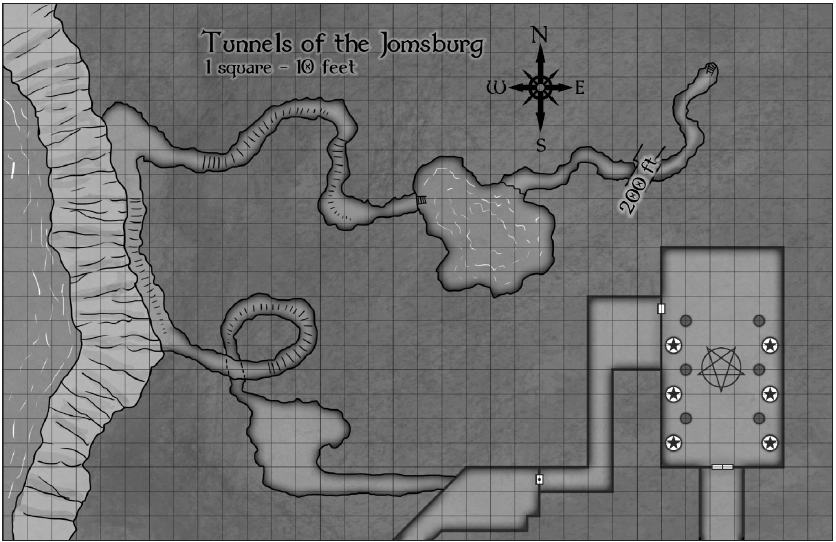
The adventure takes into account the possibility of commandeering a Jomsviking ship, as well as the PCs using the mirage arcana ring to mask the Grænir or even coming into port openly. However the adventure shoots down all of those ideas as the main harbor has a series of winches on stone columns with connected giant chains. The chains normally dip below the water's surface but can be raised to block entry from unwanted ships:
quote:
It is easy to see even from a distance that the passages between the island outposts are so narrow that their guards will easily be able to get a good look into any ships passing through (even those under a mirage arcana), and between the chains and the suspended logs, any attempt to do so would be incredibly risky. Even in the gear and longship of the Jomsvikings, the chance of discovery and the deadly consequences of such should lead the PCs to want to find alternate means to reach the island and have a chance of locating their quarry before escaping. The adventure assumes that the PCs will not attempt to sneak or force entry into the main harbor. If they do, the GM will have to adjudicate the near-insurmountable opponents that they face. Otherwise, see “Making Landfall” for an alternate means of reaching the fortress.
Boo to railroads.
The adventure presumes that the PCs will find a hidden cove with cliffs leading up to some caves as the only real entrance. The place is guarded by several monsters enscorcelled by Jasella. Later on they find some ancient headstones, where the original fey inhabitants of the isle take notice of the newcomers. With the strange feeling of being watched, a redcap named Drexelex approaches and explains how the Jomsfolk drove his people into hiding. He offers the players a deal: kill the Sea Wych (Jasella) and present proof of her death, and they'll help the party find the kidnapped heirs. A nearby patch of dreadweed parts to reveal a secret passage leading into the tunnels beneath Jomsburg (the above map). It's also revealed that the Jomsvikings and Jasella worship unknown dark gods.
What I Changed: I had the PCs meet Drexelax and the fey later, after Jasella's death. I let them go into Jomsburg with disguises. While inside they found themselves inside a huge "war room:" Lines of warriors took turns placing hands on a burning stone to hopefully become godi of Surtr (or combust in the process), siege architects debated whether to continue using the Northlands'
The Tunnels include encounters with half-ooze giant lobsters, a precarious harbor overlook where if a PC falls they land in the middle of a bunch of Jomsvikings and are captured (can be saved by Drexelex), an extraplanar spider eater which haunts the rest of the overlook, a torture chamber with a crucifixion spirit (isn't this from Roman/Christian mythology?
 ) and some devil and giant guards. The last room with the pentagram is Jasella's hall, where she plans to sacrifice a captive Sveni Ljotsdottir to her dark gods.
) and some devil and giant guards. The last room with the pentagram is Jasella's hall, where she plans to sacrifice a captive Sveni Ljotsdottir to her dark gods.Jasella is a 13th level witch and has an array of powerful spells, but she is likely to be overrun if the PCs approach with stealth and/or beat her in initiative. She opens up combat with a save-or-die blasphemy followed by turning invisible and summoning a monster, but all of these spells would take 3 rounds worth of actions for her. There's also a half-page dedicated to Jasella's backstory, which the PCs are unlikely to find out: basically she was unknown among the Northlands until 10 years ago she washed up naked on Jomsburg's shores. She strode up to the Jomsking, offering to serve him. In that time she spread the teachings of devil worship among the Jomsvikings' already-existing Dark Gods via subtle theological propaganda.
Once Sveni is is freed she can be taken safely back to the ship. Drexelex will honor his end of the deal and reveal that the other "princeling" is held captive in the higher tower in the back of the fortress-city. He mentions that that if they are willing to face the beast of the island and answer the riddle of the Bloody Stones, they can sneak directly into the tower. The PCs can spend the night at their ship to rest and recover, on account that Jasella's dark magic rituals require complete privacy and last for days. In fact, the PCs can technically complete this adventure with just Sveni; it does not have as happy an ending and less rewards, but it's a possibility.
What I Changed: I had the bearded devil guards in the same room as Jasella to provide more of a challenge. I also replaced Sveni's 4 Aristocrat levels with 8 levels in Fighter. I figured that as the eldest daughter of the Gats she could fight, but unless unbound and healed she would not be in any such condition to do so. She fought alongside the PCs, hoping to save Njal.
I had the door in the southern end of room 13 lead out to the standing stones with Drexelex, where the PCs met him for the first time. The deal was changed around: if they could slay the Jomsbeast, the fey will help them escape the wrath of the Jomsvikings if they fled to their tunnels. The fey told them the Riddle of the Stones as part of a secret passage into the tower where Njal was being held.
Continued in Next Post
NS5: Raven Banners Over Gatland, Part Deux
Original SA post
NS5: Raven Banners Over Gatland, Part Deux
The Stones and the Spire
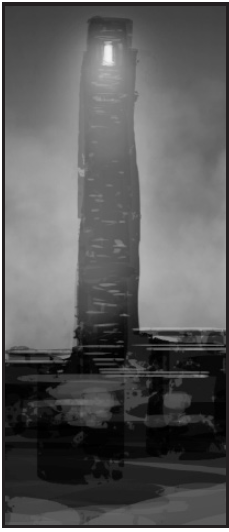
Drexelex guides the party to another hidden trail near the coast, outside another cave which is home to the legendary Jomsbeast. They're even kind enough to tip off the creature's weakness (cleansing the spring). Naturally the spring and the river runoff is dirty and merely touching the water risks disease. The Jomsbeast is the only monster here, guarding a heaping helping of treasure both magical and mundane. Drexelex words the request that it seems that killing the Jomsbeast is a necessity, but only a few kinds of water-based and curative spells can unpollute the spring. Spells which not all parties may have. The monster has Fast Healing so theoretically the PCs can drop it and exit the room deeper into the caverns before it wakes up again, but fortunately there's a decanter of endless water among the treasure which can dilute the spring!
What I Changed: I altered the encounter so that using good-aligned magic and/or plunging a holy weapon into the lake at risk of disease can work for cleansing the spring.
The rest of the caverns have encounters with various aberrant creatures, and possible patrols of Jomsvikings. As for the Riddle of the Stones, the last room has a Cthulhoid horror known as a moon-beast sitting over a portal disguised as a stone feature. It offers the party the opportunity to answer a riddle to learn the secret of the Bloody Stones, but if they fail they must fight it in combat.
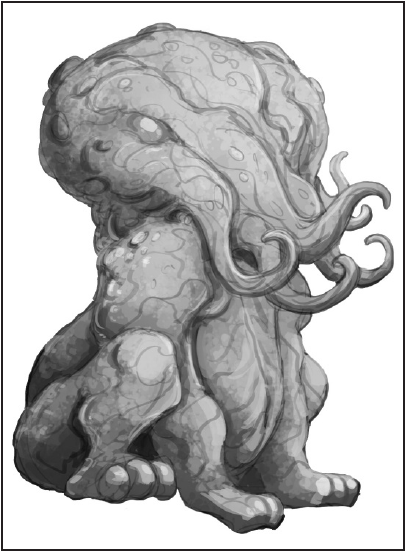
quote:
Pale queen in her cavern court
Mistress of waves and poet’s heart
She changes her face
With time and place
In the frozen forest a cracked glass
In the dry desert a bloody cast
At sea a twin she has
The answer is the moon.
quote:
It is possible your players may be true scholars of the Lost Lands and are aware that there are two moons over the world of Lloegyr. If they seem thrown off by the clues provided in regards to the Moon, feel free to inform them that Sybil the Dark Sister, the smaller moon, has little effect felt on the tides and is much less prominent in the night sky alongside Narrah the primary moon so that the riddle could refer to Narrah the Pale Sister. “Narrah” and “the Pale Sister” are both acceptable answers to the riddle. “Sibyl” and “the Dark Sister” are not.
This is kind of weird, on account that what came to my mind and the players was that the "twin" was its reflection in the water's surface. Additionally the cosmological features of the campaign setting should be one of the first things to tell the players. Espcecially where it differs from our own Earth, and certainly not halfway through the adventure path!
The moon-beast tells the PCs that the Bloody Stones secret is that of the blood of sacrifice. He then reveals glowing runes which teleport the PCs in a flash of blinding light. The party ends up at the top of a briar-choked hill with a stone alter and skeletons of past sacrifices (thus the moniker Bloody Stones). The spire of the Jomsburg fortress is nearby, lit by a single red light up top. There is one more encounter with some blood-sucking plants and plant-controlled giants and Jomsvikings. But spilling one's own blood on the altar spares them the plants' wrath.
What I Changed: I mixed in the lovecraftian horror with references to Norse mythology. The moonbeast mentioned that it existed since before Ymir's bones set into mountains and repeatedly referred to Midgard as a corpse-world. I cut the briar encounter due to time constraints.
The spire itself is a spacious place, the home of the Jomsking. Amid the roaring fireplace and luxurious surroundings lie the macabre idol of the Dark Gods and the chained, tortured form of Njal Magnusson. The Jomsking, a morbidly obese man named Ût the Fat, is a human cannibal who has been feasting on the flesh of Njal while keeping him alive. What follows is combat with the Jomsking and his rock troll bodyguard. If the idol is destroyed, Ût shrivels down to his frail true age (100 plus years) and suffers big stat penalties. The "dark god" in question is the Oinodaemon, which a Knowledge Religion check can reveal.
What I Changed: Ût the Fat's stat block is a level 10 Fighter of Large size category with the Broken Soul template. He's quite good in melee combat, but his Reflex and Will saves are awful: +5/+3. Our party witch would have turned him into anti-climactic mincemeat, so instead I replaced him with a fire giant and a pair of hell hounds. The battle took place in a luxurious hot spring, and one of the pools the Jomsking used as a two-way scrying filter to speak with the Emperor of the Huuns. The Emperor was less than pleased about his organization's failure in Estenfird, but the Jomsking happily announced that he sabotaged the Gat-Hrolf peace process. Presenting the form of a caged Njal, the Emperor's mood lightened. None of the PCs recognized him, as the continent of Libynos is virtually unknown in the Northlands. During the battle the Jomsking used his rock throwing ability to strike at the lids of hot tubs, spilling over gallons of scalding water as an area-effect attack.
Once Njal is rescued, the PCs can loot the room for some sweet magical items, and the Jomsking himself bears a unique crown. The crown grants +2 to the wearer's AC, attack rolls, damage rolls, and immunity to cold environmental conditions. Jomsvikings within 60 feet gain +2 to attack rolls and saves vs fear, but the crown's only weakness is that it is immediately recognizable in the Northlands and imposes a -5 penalty on social skills among the non-Jomsviking population (but +5 Intimidate). I don't know if the rock troll counts as a Jomsviking, but this 60 foot radius buff is kind of wasted given there are no Jomsvikings in this encounter and the organization cannot be taken over by the PCs as part of this Adventure Path.
The PCs must escape Jomsburg, and if they were particularly loud in fighting a warband is heading up the spire. The adventure suggests various means of escape like tying tapestries together to make an impromptu rope or using the Riddle of Stones to teleport. Although at this levels PCs with spellcasting potential can fly, teleport, turn invisible, summon monsters, and all manner of means of getting back to their ship safely. In fact in my own games the Nûklander witch teleported Sveni and Njal while the party members left behind leaped out of the tower and made a mad dash to the Bloody Stones.
The sail back to Trotheim is uneventful, and just in time for the wedding. The parents are happy, and a grand celebration is underway. The PCs receive their weight in arm-rings (15,000 hacksilver for medium PC, 5,000 for Small, and 60,000 for Large) and as a bonus, the Gats and Hrolfs show the PCs the contents of their familial vaults' greatest treasures. Each party member can choose a magic item of their choice. If only Sveni was rescued the magic item list is smaller.
But there's one person who doesn't like a happy ending, and that's Old Meg. The Daughter of Skuld makes her way into the feast hall as an overpowering divine force which subconsciously encourages people to step aside:
quote:
"Oh, dearies, you failed to invite me, your grandmothers’ grandmother to this wedding feast, yet you both sprang, many generations back, from this shriveled womb. You, who have not just the blood of heroes, but the blood of gods in your veins, yes, and the child that already grows in fair Sveni’s womb — for they were not as chaste as they should be on that long trip across the whale road from the Jomsburg, now were they? — will one day be not just Køenig, but High Køenig and ruler of all the Northlands. That is a tale for other days, though, a tale of battle-dew and bone-white ribs basking on foreign shores.
No, I bring you not fire and pain, though that is your wyrd and future; I bring you three gifts, yet you still have not offered me mead nor bread at this feast. “The first gift is happiness, for you will know three times three years of joy in wedded bliss. The second is glory, for you will both earn much in your lives, one beneath the raven’s wing, the other in the birthing bed, for that is where many women battle and die. Your last gift is courage, for you will need it in the days to come. As I speak, death stalks this very hall and a man lies dying in this city as his life’s blood fills his lungs. Plague has come to Trotheim, and both the high and low will feel its hand.”
Fun fact: Sveni's infidelity is never remarked upon by anyone, nor plays a role in future adventures. It sounds like this occurred during the PCs' travel back to Trotheim, but there's no opportunity for them to find out if Sveni's dallying with one of the crew. I'm thinking that this is here to paint Old Meg as a vindictive passive-aggressive woman who loves to hear herself talk.
She disappears in a flash of light, and the mood is totally soured. The adventure ends in media res, with NS6: Plague in Trotheim taking place next gaming session.
Alternate Endings: If only Sveni was saved, the Gats are happy but the Hrolfs slip away quietly; Njal will be murdered and his head and genitals will be mailed to Magnus Hrolfsblood. The PCs will earn the enmity of the Hrolf clan for failing to save him. There is still a feast instead of a wedding, and the Gats are hit harder by the plague in the next adventure. The Hrolfs are accused with claims of black magic and withcraft flying about, but full war is stymied for a time only due to the Gats' forces being much smaller from disease.
If the PCs cannot save either Sveni or Njal and return empty-handed, they will be branded as cowards and failures, unwelcome in all but the most wicked lands. Wherever they go people spit on and throw garbage at them. Rumors swirl around that the Hrolfs paid the party off to not find Sveni, and Jarl Ljot Gatson does everything in his power to ruin their reputations. This almost sounds like a Non-Standard Game Over, but the adventure suggests that curing the epidemic in the next adventure can earn them redemption.
Additionally NS10: the Broken Shieldwall assumes that Njal and Sveni survived and wedded to produce an heir, but if not then other nameless heirs take their place which kind of defeats the purpose of this adventure IMO.
Concluding Thoughts: Raven Banners Over Gatland is a bit railroady and feels artificially enforced in spite of potential magical infiltration. The moon-beast's riddle is good if not for unnecessary world-lore, and the Isle of Jomsburg is appropriately dark and foreboding. The encounters have a diversity of monsters with a more overtly supernatural flair. Its largest weaknesses are the opening scene and the huge amount of Jomsviking enemies during the sea travel section.
Join us next time as our heroes set out on a quest to cure the Plague in Trotheim (NS6)!
NS6: Plague in Trotheim
Original SA post
NS6: Plague in Trotheim
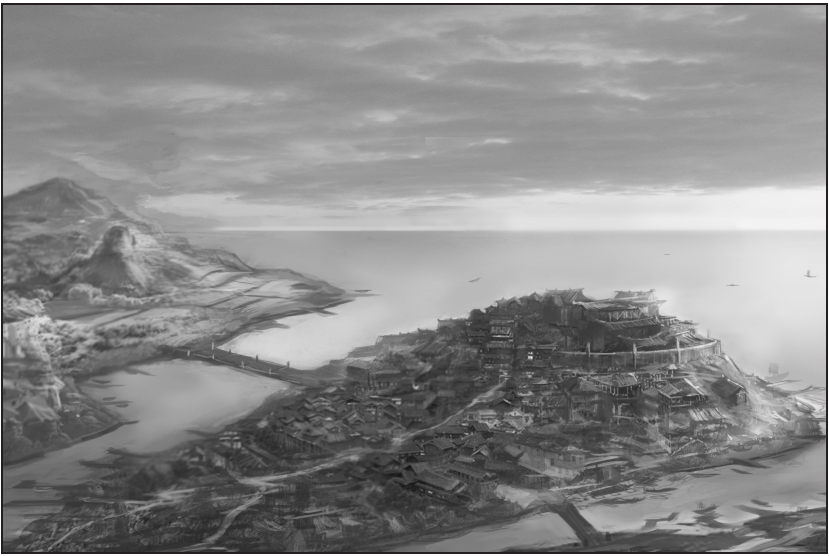
Unlike the last few adventures which usually had 6 to 9 months of interim time, Plague in Trotheim begins immediately after the end of the last one. It is suited for levels 10th through 12th. So far in the Northlands Saga we're 8 adventures in out of 12, but only 3 years out of the 16 year timeline. I guess after all the huge problems the PCs cleaned up, it's taking time for enemies to respawn.
So at this point in the Saga the low-magic chastity belt comes off and we start getting into High Fantasy territory. We've got valkyries, gods speaking through the mouths of godi, mythical disease-curing trees, dragons, kaiju trolls, and demonic prostitutes...wait, I didn't mean that kind of fantasy!
This adventure has some backstory that isn't exactly revealed through normal play. See, Wotan saw a dire premonition in the Northlands' future involving Hengrid Donarsdottir which can threaten the realms of Asgard and Midgard. The vision was incomplete, but he knew that great heroes were needed to save or defeat her. Sadly he couldn't find any heroes fitting this description, so he bade Loki to come up with an appropriate test to separate the wheat from the chaff of legendary mortals. Loki being Loki, he came up with the plan to spread a divine plague which could only be cured by the leaves of the legendary Ettielweiss Tree...which he also sent his agent to destroy. The Ettielweiss Tree's power also prevents the coming of the Fimbulwinter, a years-long unnatural winter which is also one of Ragnarök's precursors and thus the opportunity to replace Wotan at the head of the pantheon.
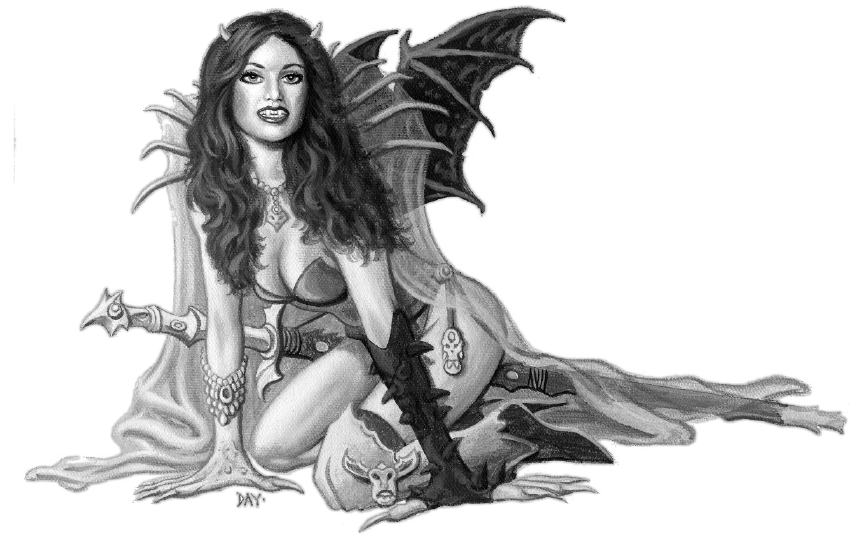
Loki figured that the best way to spread the plague would be to place a plage-ridden kiss on several trusted sexy devils known as lilins. They went to Trotheim and spread the plague as an STD by posing as prostitutes. With the arrival of many newcomers for the wedding, business was booming. Now before you ask how only six women manage to screw thousands of people into the plague, the adventure has an explanation for this. Being magical it quickly mutated from an STD to an airborne sickness as the primary vector. The plague's effect is such that it is a fast-acting wasting virus that eats away at muscles and tears away at the membrane of the lungs. Due to the weakening of strength, it quickly became known as the Straw Death.
What I Changed: The "mutates into airborne virus" seems like a means of maintaining suspension of disbelief, but the initial STD nature and seductive devils (who also are fought in a brothel) felt too much like the writer's masturbation fantasy. I still had devilish handmaidens enacting Loki's will, but they had a role more akin to "chemical weapon scientists." They initially tried to make the disease carried in the stomachs of cattle animals to transmit via consumption of many feasts, but that was not quick enough so they used magic and natural law to mutate it into a waterborne vector. They also used magical disguises to pose as false godi and spread misinformation about the plague's origin counteract the legitimate godis' prophecy. The PCs encountered the handmaidens not in town, but later on in the Andøvan Mountains.
Our adventure begins one day after Old Meg's declaration. Throughout the city divine spellcasters and nonspellcasting godi alike all proclaim the same message:
quote:
Pestilence creeps the sleeping streets.
Foul plague suckles on Trotheim’s teats.
Sheaves before sickle, we meet our doom
’til the brave arise to claim the bloom.
This can even trigger in the middle of sleep or combat and repeats on an hourly basis, and if no PC fits the above description the one with the highest Wisdom score will do. A Will save can suppress it, but otherwise imposes the dazed condition as their body is more or less taken over. This is the work of the Æsir and Vanir spreading hints for the cure: the Eittelweiss Tree. One week after the outbreak, the city is in shambles: trade has fallen, dead bodies are collected in ox carts, a huge pyre burns outside fed by corpses, people keep out of contact from even trusted friends and neighbors, and families hire masked men known as "mercykillers" to euthanize loved ones. Barring the PCs there are only four characters in the city capable of magically curing disease, and they're being stretched to their limits. The party, along with other prominent citizens, is summoned to the Thing where Trotheim's Jarl Gyrthyr makes a statement. He believes that the plague is from Hel, and that the godi's prophecy must be a clue. He appoints the PCs as temporary members of the city guard and to investigate a cure.
What I Changed: I made the jarl a woman named Annette to place more women as prominent NPCs in the adventure.
A City Under Siege
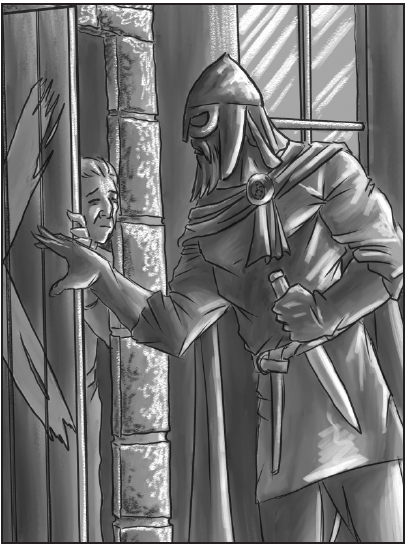
The first chapter of this adventure is a series of 8 linked encounters, 7 of which can be played in any order. They are meant to showcase the desperation of the city. A few of them are rather standard (a distraught woman who refuses to give up her love ones' corpses to the ox cart and risks getting sick herself), a torch-bearing mob angry at the Gods for forsaking them and causing destruction in anger, a desperate father tying his wife and youngest sons to a pyre as a sacrifice to the gods to stave off the plague, and a fire elemental coming to life upon the pyre outside the city. But three bare special mention:
The first one involves a pair of mercykillers being refused entry into a building by a spear-wielding huscarl. The pair were paid to put down a pair of young women, but mixed up the address and are at risk of killing the wrong people. The adventure mentions that this occupation is seen as regrettable yet honorable work in the city. PCs who take a diplomatic result can put a stop to things and investigate. The huscarl and women inside (the wife and oldest daughter of an absent jarl) show no signs of the disease. If no fighting breaks out the huscarl thanks the party with a greater horn of blasting with one use left, while the mercykillers reward the PCs with silver arm-rings...and go on down the street to the correct address. If the party doesn't intervene, Olaf kills one of the mercykillers before being killed himself along with the two women inside.
What I Changed: Hoo boy. Where to begin. I noticed that my gaming group was becoming uncomfortable with this so I sped up the encounter, although the witch used an enchantment to make the mercykillers wander off aimlessly. Personally speaking this whole encounter is kinda screwed up. Regardless of how you feel about euthanasia IRL, the mercykillers' work is not at the personal request of those suffering but family members taking the ultimate decision into their own hands. The adventure expects the nonviolent situation to be "oh hey wrong address" and no opportunity for pointing out that it should be in the hands of those suffering how to die as a moral diplomatic option.
The other notable encounter involves a group of Nûklander elves who Kidnapped a Godi known as Biornólfr of the Well. Jarl Gyrthyr approaches the PCs in a panic, asking them to find the godi as a first priority. The elves did this to demand that the priest cure their patriarch (who contracted the Straw Death) as well as any family members who will fall ill. As Biornólfr burned all his remove disease spells for the day, he's not going to be released anytime soon. The godi and elves are holed up in a longhouse in town. There's an awful lot of Nûk here: 14 combatants (a mixture of sorcerers, barbarians, and archers) and 30 noncombatant women and children.
What I Changed: I had this as the final encounter in town, and made it so that Biornólfr of the Well was the one who revealed the secret of the Eitwelweiss Tree to the PCs. I also allowed the PCs to negotiate with the Nûklander elves before actual combat, with the added complication of an angry mob outside the house barely held in check by city watch guards. The witch, having recognized the voice of one of her family members inside (who she was not on good terms with) opted to nonviolently disperse the mob outside. The rest of the PCs snuck into the longhouse via a chimney. Although combat started, the party used non-lethal damage and eventually talked some sense into the elves via the school of hard knocks.
The last encounter takes place when the Jarl triangulates the source of the plague with the help of a Monrovian diviner wizard. It is at a Brothel known as Jurda's Roof:
quote:
Jurda’s Roof (area 9) is well known in Trotheim as a brothel that has existed for many years. Some of the PCs may have even visited it in the past, though if so, they have fortunately not done so since the plague first appeared. It is easily located in one of the poorer sections of town near the southern end of Trotheim Island.
I prefer to let my Player Characters imply their own sexuality, thank you very much.
The interior of Jurda's Roof seems...normalish if a bit off. The diseased harpist mindlessly plays an off-key tune again and again, and the landlord counts the same stacks of hacksilver again and again. The lilins continue infecting clients the old-fashioned way as a group of men wait their turns in the common room. In fact the employees are harmless zombies animated by the devils. The lilins will fight to the death, being too arrogant to think mere mortals are a challenge. Aside from the +1 longswords the devils carry the landlord has a potion of gaseous form, a wand of see invisibility, and a scroll with a 9th-level spell on it (Astral Projection). Now how did a mere landlord get his hands on that?!
You might be wondering if any of these encounters were supposed to provide clues to the Eittelweiss, right? Nope! In fact, the revelation occurs via actions completely outside of the PCs' decisions. Erik the Wotanson and actual descendant of the god himself, sacrificed his last good eye in exchange for wisdom and received a vision.
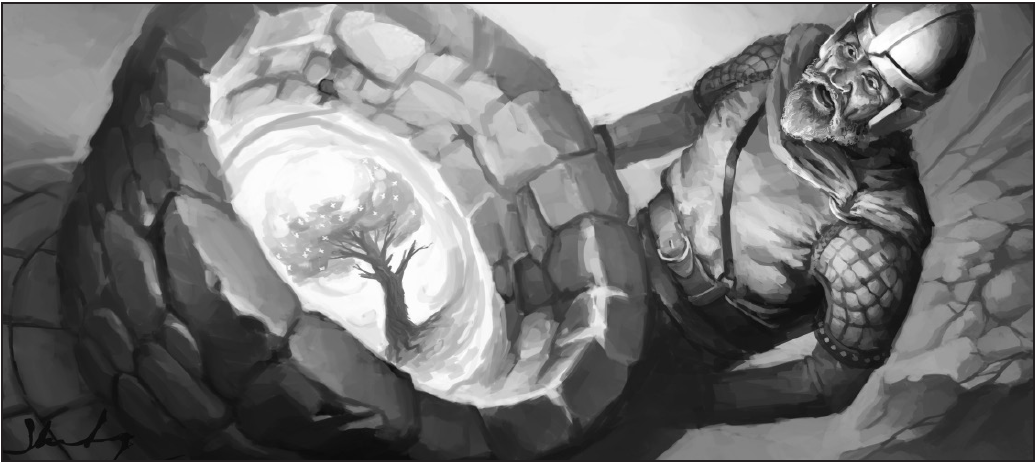
At the next assembly of the Thing he explains how he saw a vision of an immense tree, with the walls of Trotheim at its roots. A great stormed swept through as it bloomed, causing flower blossoms to spread about. The town turned normal again as the flowers blew away, a new sense of peace. Erik, the Jarl, and the rest of the Thing feel that this tree is the key, and legends speak of the location of its vale somewhere in the Andøvan Mountains. After gaining a map the PCs are sent on a quest to find the Eittelweiss Vale.
What I Changed: I excised the brothel encounter, and had Biornólfr of the Well be the deliverer of the prophecy. Instead of at the Thing he revealed it directly to the PCs after they rescued him by performing a divination spell in a pool of water (graciously provided by the shield of the party's new dual-shield Fighter PC). I altered the vision so that the PCs saw it directly rather than being told, and made it so that the Ettielweiss fell among masses of warring battalions. When the battle cleared, a dwarf dug up from the ground like a mole and took some of the tree's scattered seeds.
The backstory in my games was that there was an Ettielweiss Tree in Midgard, but its legendary healing properties caused all manner of people to war over its ownership. The dwarves in their wisdom took the last seeds to safeguard its legacy in their kingdom of Nidavellir. The PCs learned of this and the location of the Vale via Knowledge checks and folklore.
Among the Andøvans
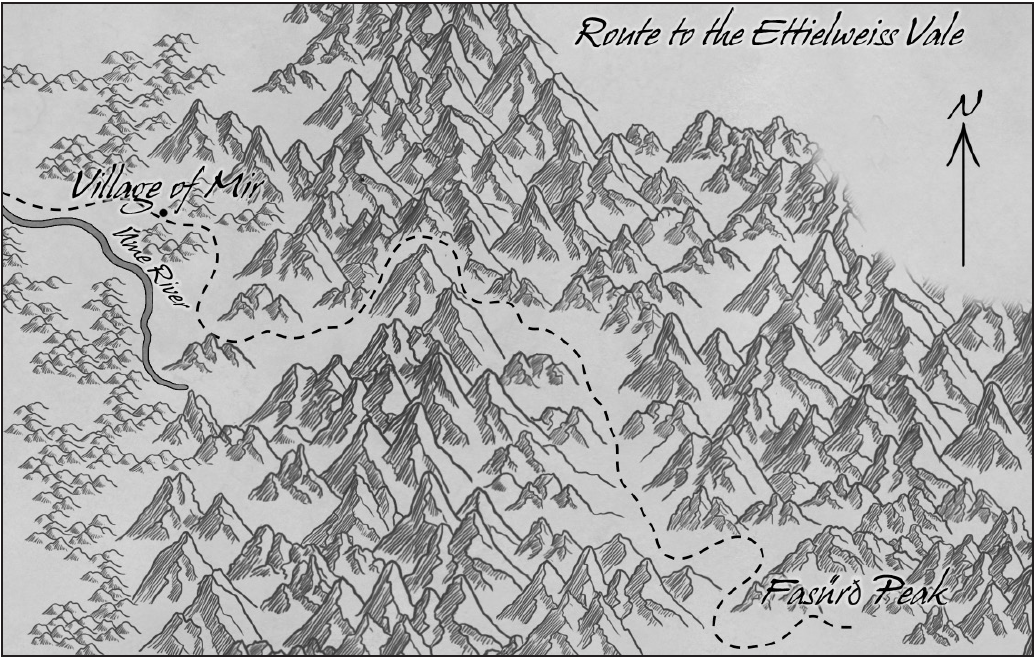
The second chapter's a relatively short one. It's a somewhat linear progression up the mountains with some set-piece encounters. If the PCs try to use magical flight to more easily traverse the path, a flock of continually respawning perytons attack the group every day. The adventure says that "it should soon become apparent that flying in the mountains is not going to help the PCs reach their goal any sooner or more safely" yet perytons are rather weak straightforward enemies who won't pose much of a threat to a party at this level.
The first encounter involves a village whose inhabitants are now fetch undead possessed by hellwasp swarms as part of Loki's machinations. The undead try to scare the PCs off with a dire message of doom and gloom how the gods are not their friends. The second encounter involves a herd of onyx deer territorial of a meadow the party must pass through, and the third encounter is a lead-up to a miniature dungeon. A two-headed cyclops known as the thrall collector is out hunting for slaves with some common giant minions, and figures the PCs would make for great unpaid labor. The thrall collector has his own 4 room dungeon full of more common giants and a captive cloud giant woman who is implied to have been raped (although the adventure does not state this overtly). If the PCs unshackle her she fights the rest of the giants with them. She will visit the party a month after the adventure's completion to grant them a stone mined from thunderhead clouds worth 60,000 hacksilver.
What I Changed: I had the hellwasp swarms be under the control of the lillins. One of the swarms flew off after sustaining heavy damage to report back, and the PCs followed it. Another fight broke out with the lillins, but the PCs interrogated one of them and learned of Loki's plans. The thrall collector and the cave lair was excised for time constraints as well as being a bit samey in the makeup of the giants (HP bags, melee attacks).
The Ettielweiss Vale
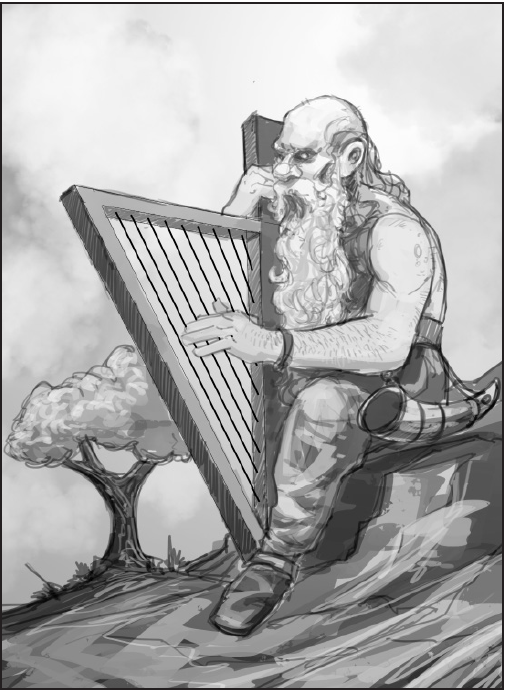
The Ettielweiss Vale is not on Midgard, but in fact blooms within an extradimensional storage space accessible only via a gate of dwarven make. Skrymir, a titan guardian, holds the key to the dwarven tree gate and will only let those deemed worthy pass. The PCs will notice the massive giant's presence long before they see him, as he's fond of playing loud yet pleasant melodies on his 70 foot tall harp. Fortunately he's one of the Chaotic Good ones and is quite happy for new company. He asks the PCs about their past adventures with compliments at the ready as well as the rules of the tests.
Each of the tests may be undertaken by one PC at a time, but if they fail another PC may take their place. They are allowed full use of any magical items during the test, and can use any buff spells before the tests proper. But spells cast during the test count as cheating, earning a slam attack to knock some sense into their heads. For the first and third tests he uses the heal spell to remove the negative effects (barring the curses). Winning a test on the first try causes the titan to grant a magical item as a reward (a frozen tear from his eye which is a staff of frost, a piece of jewelry in his beard that holds spells, and a wand of fireballs plucked from his ear) along with Experience Points. But if a PC fails they suffer a curse which is only lifted via powerful magic or curing the Straw Death (withered limbs reducing speed, becoming mute, or having their alignment changed respectively for each test).
The first is the Test of Trades where a PC and Skrymir exchange two blows each, one at a time and taking turns. If the PC is still up, or the titan falls unconscious, the party wins. But if the PC is reduced to 0 hit points or less, he loses. The next test, the Test of Wits, requires the PC to answer 2 riddles:
quote:
Riddle #1: By nature solitary, scarred by spear and wounded by sword, I am weary of battle. I see the face of war, and fight hateful enemies and sometimes even friends. In the midst of the spear-din all crave my company but will eventually abandon me. I am the boon companion of jarls and hirthmenn alike, yet I hold no hope of help coming to me in the battle before I’m eventually done to death.
Answer: A Shield
Riddle #2: Favored by men, I am found far and wide. I come from the woods and the heights of the town, carried to my home by the queen’s men. But men take me from my home, and I am bathed in a tub. For this I blind them and chasten them. I cast a strong young man to the ground, and sometimes an old one, too. He who struggles against my strength, he who dares grapple with me, discovers that he will hit the hard floor with his back if he persists. Deprived of his strength, he’s a fool who rules neither his mind nor his hands and feet. Freely welcomed by all and enemy to each, I am the reward and doom of many a great warrior, making slaves of the mighty and fools of the wise.
Answer: Mead
The Test of Cups is a good old-fashioned drinking challenge, save it is magical Elysian mead quaffed by titans and gods, and both contestants take gulps from Skrymir's giant-sized drinking horn. Each draught requires a Fortitude and a Will save, with the former save causing 1d20 wisdom damage on a failure and the latter causing a random alignment change. If the PC finishes drinking two draughts while remaining conscious, or Skrymir falls unconscious from Wisdom damage, the PC wins.
What I Changed: Role-playing a mute character is quite a challenge, so when the witch failed the second test I had her only be able to speak in Giant which only the troll-blooded barbarian/rogue understood.
PCs who pass all three tests are given a six-foot-long key, but otherwise they must steal it from the titan. Given that titans have constant True Seeing and +33 Perception along with every powerful stats, you should probably tone down those features in case of a loss.
As for the gate, it leads into an extradimensional demiplane. The entryway follows a long carved tunnel of dwarven make and the only time in the adventure path where being a dwarf provides an in-universe benefit: free success at a Knowledge check to recognize its make! The tunnel ends into a beautiful, vibrant valley which oddly has sunlight. But a massive tree over 500 feet high dominates the view: the Ettielweiss. Unfortunately the tree is under attack by Loki's forces: a pair of underworld dragons digging up the roots, 40 moss trolls with adamantine saws cutting off the branches, and three large patches of a supernatural black mold known as Helsmuth eating through the trunk.
Each of these three challenges is handled separately. The dragons are straightforward in taking out, but the helsmuth is immune to all damage save fire and cold (the staff and wand from Skrymir are perfect for this, as is Fellfrost) or a remove disease spell. However, damage causes the mold to explode into a 100 cubic feet of spores that cause Constitution damage and a long-term stun condition (4d4 rounds). The adventure also notes that the fey known as mites find Helsmut a delicacy, are immune to its effects, and can destroy 1 patch per minute. These creatures can be summoned via Summon Nature's Ally I, but the adventure provides no means of finding this last weakness out either in the adventure proper or by Knowledge checks.
Finally, the 40 moss trolls are scattered about the tree which requires climbing to find. They do not fight the party all at once, instead swarming several at a time every round. For once the adventure realizes how much this would be a logistical nightmare to run straight and instead represents the enemy horde via automatic swarm damaged based upon the number involved. Unfortunately the adventure still has killing them the old-fashioned way of one at a time or a bunch via area of effect spells. There's also detailed environmental description, where a falling PC can lessen damage by grabbing passing branches in time or how the foliage can be used for cover. The trolls retreat once 25 of their number are put down.
After saving the tree, the PCs are visited by a valkyrie astride a many-legged horse to congratulate the party, telling them of how even in Valhalla the PCs' fame has spread. She gives them an urn filled with the tears of Freyja to restore the trees' wounds and make it whole again. But the interaction doesn't last long as she must go back to her home plane. The urns however are valuable gifts, and one is a decanter of endless water. Gathering the blossoms from the tree is trivial now.
What I Changed: I was kind of miffed that the dwarves never played any sort of role in this setting beyond that one gate, so I had it so that the portal was an extradimensional way to Nidavellir, a realm beneath Yggdrasil's roots and home of the dwarves. I was keen on wondrous descriptions: a seemingly endless black sky from which mountain-sized roots hung, with villages and castles built upon them and giant branching leaves. The glint of Níðhöggr's teeth could be seen in the background as vast expanses of ivory white chewing on roots. The villages were home to dwarves, who lived and worked much like people in Midgard save their fauna was distinct. Giant beetles pulled yokes to till the soil, and blacksmiths pulled metal quills out of giant porcupine-like monsters to fashion into bladed weapons. The party was escorted to the king's throne room, which floor was a giant clockwork mechanism portraying the visages of the gods and famous figures. The figures were on a path all counting down to the foreboding landscape of Ragnarök at the room's edge.
The King of the Dwarves was willing to grant the PCs leaves from the Ettielweiss no strings attached before one of his advisers informed him of an immediate attack upon the castle and Tree by shapeshifted agents of Loki. I cut out the part with the Helsmuth and focused on the fight with (fewer in number) trolls and dragons. One of the dragons killed Aluki, causing our witch to fly into a murderous rage. Desperate, she brought her friend back from the dead after making a pact with her patron, who asked a favor: "when you kill a god, let me ascend to his place." She accepted, and although nobody but her at the time knew of this pact the magical power was for all to see. The King of the Dwarves was aware of the taint of dark magic and although grateful for them saving the Tree, he forbid the PCs from ever setting foot in Nidavellir again. At this point I felt was a good closing time for the adventure and excised the next encounters (save kaiju troll, which I incorporated into NS7).
The PCs have to make their way back to Trotheim. Loki is now desperate and pulling out all the stops. The first encounter are six blue dracolisks hunting them down, and the second is a valkyrie who fell for Loki's deception and is going to steal the blossom. She is disguised as the one the PCs met in the Vale, but if they see through her ruse she engages them in combat. If she gets the blossoms, she will mean to go to Trotheim, but forget and instead flies east into the mountains with one last chance for the PCs to catch up to her.
The final encounter is a nine-headed Jotund Troll rampaging towards Trotheim whose quaking footsteps can be felt long before it's seen. The guards cowardly abandoned the walls and only the PCs can put a stop to its warpath.
After the troll's defeated, the PCs must find a way to spread the blossoms' power. This is not via a skill check but rather several suggestions. The Ettielweiss' power is such that plucked petals regenerate and just about anything plausible can work: sprinkling them in the town's water supply, doling them out like communion wafers, or even burning them in incense for those to breath in the fumes. In 2 days' time the plague's influence will be gone for good. Erik Wotanson makes his way, blind and accompanied by an unkindness of ravens, with an ornate box containing rewards for the PCs:
Hurguð the Piercer of Scales and Sleipt the Awakener. The first item is a +3 adamantine distance seeking returning dragon-bane spear (that's a mouthful). The second is a ring which allows the wielder to cast meld into stone at will, but if they slay a flying monster of 10 Hit Dice or more its true powers awakens as a ring of elemental command (earth). The PCs are hailed as heroes although celebrations are muted on account of the many deaths suffered. To amend this loss of life Wotan blesses Storstrøm Vale with an abundance of herds and crops for the next 7 years.
Concluding Thoughts: I have mixed feelings about this adventure. On the one hand when I personally ran it it had lots of exciting moments, particularly defending the Ettielweiss Tree, saving the godi taken hostage, and Skrymir's tests. On the other hand, I had to change parts of the structure, and the opportunity to travel outside of Midgard was kind of a letdown in the default adventure when the plane was an otherwise featureless Vale. The first chapter in Trotheim has unlinked encounters and some problematic elements (mercykillers and fiendish prostitutes) and the overall set-up feels more at home in the Forgotten Realms than a sword-and-sorcery low magic setting.
But that all pales in comparison to the next adventure NS7: the Return of Hallbjorn, which I more or less had to rewrite from the ground up.
NS7: The Return of Hallbjorn
Original SA post
NS7: The Return of Hallbjorn
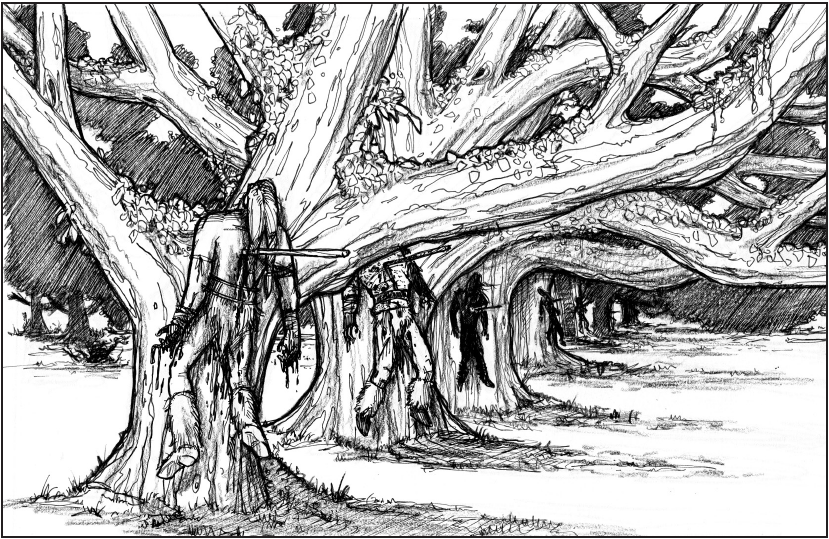
This adventure is suited for levels 11th through 13th. I'm not going to be doing What I Changed notes for this one. All of that will be in a post of its own, as I more or less had to rewrite this module from the ground up. Why?
Two words: Skraeling trolls.
After saving Trotheim from a dire fate, the PCs have 2 years of leisure time and by now are famous throughout the whole Northlands if they aren't already. But since their rising days from Vengeance of the Long Serpent, Hallbjorn's been busy. The former captain of said ship is very much alive, and not because of resurrection magic either. After being knocked off his ship, he caught hold of a lone kayak once manned by the Ulnat warrior Kelvani by sheer luck. It had enough supplies to last him for a bit, and the brave Viking paddled using the currents and the position of the stars in the sky. Eventually his kayak came upon the shores of a warm new land known as the Oestyrn Isles, also home to stranded Northlanders who originally meant to sail north to Estenfird 70 years ago. From their view, this colony of "Nieuland" was a fertile paradise of mild winters where old clan grudges were forgotten. But Hallbjorn still longs for home, and with a newly-built ship he sets off for the Northlands.
It is a warm fine day in Halfstead when Hallbjorn's ship comes into harbor. The sighting of his face causes a stir and it's not long before news reaches the PC's ears. Hallbjorn is more than happy to see his old friends from half a decade ago, and just as eager to hear of their many exploits. In a game of one-upmanship he tells them and everyone within earshot of the land of Nieuland and its many untamed lands and lost treasures. Tales grow wildly out of proportion, claiming that the legendary Viking of the Henrikson household slain a dragon, married a princess, and many other wild tales. Naturally the Køenig of Hordaland (now 14 years old) is interested in arranging a meeting with Hallbjorn and the PCs at his hall. During the feasting the party can make skill checks to separate truth from fiction of the wild tales. Eventually Hallbjorn tells the truth of things to the Køenig's mother and the PCs: a group of thrydreg trolls the colonists call Skraelings (term for "barbarian or "foreigner" in Nørsk), long indigenous to the island, have been attacking the people of Nieuland. Hallbjorn fears that they are massing in numbers great enough which they won't be able to withstand. The regent mentions that she secured a deal with him: that Hordaland will help settle the new land via trade agreements and with grandiose plans to enrich Halfstead even further.
The adventure points out a minigame system in the adventure's appendix for PCs seeking to become jarls, along with Regent Gudrid promising 10,000 hacksilver as a forward loan. Hallbjorn knows of a secret fast route to the Oestryn Isles, but all the other colonists have to use Halfstead's trading ports. The expedition takes a year of planning, and during this time the Isles see a new influx of colonists. Unfortunately word has spread to many ears, including the Jomsvikings who begin making raids on colonist and skraeling settlements alike. What's more, a monstrous shaman known as Half-Face is stirring the skraelings into a larger warband. This, combined with the strained resources, is enough to push the skraelings over the edge.
quote:
It is only a matter of time before they come into contact with the Northlanders and bloody war rips through the forests. Only the timely intervention of the PCs can spare the fledgling colonies from the dual threats of the Jomsvikings and the skraelings.
Dual threats you say? Guess how many set-piece encounters involve Native American trolls? 17. Guess how many involve Jomsvikings? 1, and it is optional.
So, where to start? Although the skraeling's stat blocks are mostly Chaotic Neutral, they are the villains of this adventure. Besides one NPC there is no resource or option to broker a peace deal, unite against the Jomsvikings, or even convince Hallbjorn and the colonists that their expanding settlements are only going to make things worse.
Even the boxed text is biased:
quote:
Nieuland is the home of an evil and secretive race, an age-old enemy of the Men of the North, the thrydregs. Unlike the thrydregs of the Northlands, these trollish folk descended from survivors of a once-great island nation far to the south now sunken beneath the waves of the Great Ocean who came northward after the fall of their nation in mighty ocean-going canoes. This wandering people found the Oestryn Isles and settled there, only to discover the waters around the islands already the home of many clans of trow. The trow and southerners warred for many years, decimating both sides, but ultimately the trow overcame the newcomers and enslaved them, creating a new breed of thrydregs unique to the Oestryn Isles. The Northlander colonists who have encountered them call them skraelings, which means simply “foreigner” or “barbarian” in the Nørsk tongue, though it has come to be identified with this specific race of thrydregs to the Nieulander colonists.
So are they Evil, or are they Chaotic Neutral?
Upon the Transborean Current
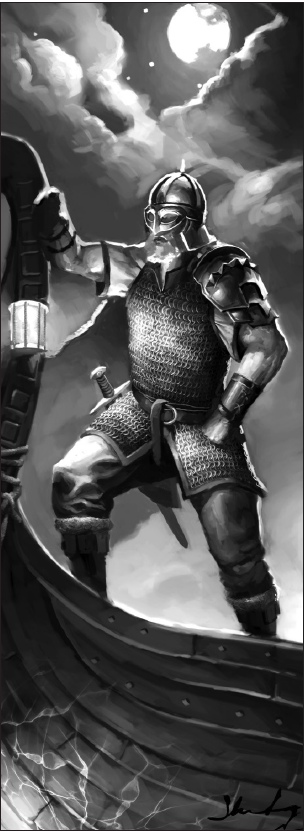
The first chapter is a linear ocean voyage. The Oestryn Islands are 7,200 miles east of the North Sea, which would ordinarily take 100 days but Hallbjorn's secret Transborean Current shortens this to 81 days. In addition to a colony of glowing jellyfish which the sailors take for a good omen, there is a set-piece encounter with 5 coral giant scavengers. Later on, the crew briefly catches an ominous sighting of a Jomsviking ship before it mysteriously disappears. Finally, the fleet comes under attack by 11 trow (aquatic trolls) astride a dragon turtle.
The Colony of Nieuland
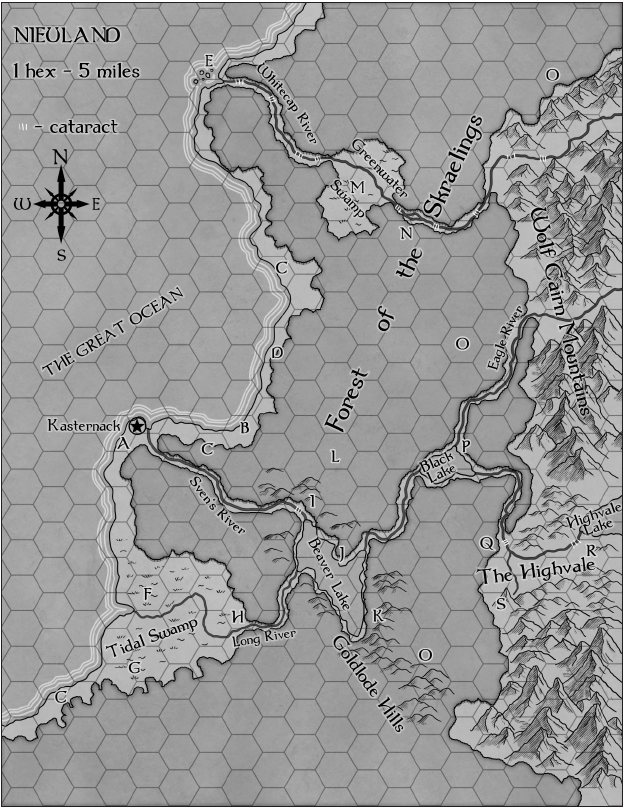
This section of the adventure is an open-world Colonialist Sandbox. There's a host of stand-alone encounters and settlements. The western colony of Kasternack is where Hallbjorn's fleet makes first landing, and the PCs will gain a warm welcome by the local jarl. The laws are different: land is free for the taking as long as nobody else already laid a claim to it. The adventure encourages the use of the Jarl mini-game rules to encourage settlement building and for the GM to use existing encounters and ones of his own design. In terms of locations, there are 19, one of which is Hammer Cleft Mountain and covered in its own chapter. Not all of them are notable or interesting enough to include in this review, so I'll focus on a few. C, G, K, and P are skraeling villages, a few of which have Native American-style names (Beaver Lodge, Running Wolf Village) with description of the number of warriors and noncombatants who include children (who have no stats thank god). D is an abandoned camp which has the corpses of people tortured and nailed to the trees by Jomsvikings (which is in fact the title image of this adventure). The massacre site can give some clues to the identity of the attackers. H is a pool where a green hag and her dire crocodile pets seek to ambush boats and swimmers, while J is the ruins of a Northlander village where the Jomsvikings set up camp. They are a third party in this adventure, equally hostile to the colonists and skraelings alike and are not too fond of the PCs' sabotaging of their island fortress.
L is a hill home to several huge monstrous statues which can animate into stone golems. If the PCs attacked the skraeling villages mentioned above and Half-Face is still alive, then he'll lead a war party to attack and kidnap several Northlander farmers to perform a human sacrifice here. If he is not stopped, the golems will animate and he'll command them to besiege Kasternack. Half-Face will not fight to the death, instead dimension dooring back to Hammer Cleft Mountain.
O is home to a sasquatch family and their young. They are not eager to start combat, instead using traps and howls to frighten anyone away. If the PCs rescued a sasquatch from a viper vine (one of the random encounters) the family will look on cautiously. The rescued one's among them, and out of respect they gift the PCs fresh game, water, and a masterwork shortbow. They can be allies of the PCs if a communication channel is opened (they only speak their own tongue), fighting the skraelings if necessary yet not a sustained war, and can show them a secret passage in area Q to ambush the camp up there.
So what I'm getting is: Sasquatches good. Indians bad.
Q is a valley home to a camp of skraeling warriors guarding the trail to the Highvale's lakes and rivers.
R is home to an overlook containing a beautiful sight of the Highvale, a set of interconnected lakes and rivers home to many skraelings which is beyond the scope of this adventure. Giant beavers can be fought here and have their pelts skinned for hacksilver, but Survival checks show that a large number of skraelings headed up to Hammer Cleft Mountain, area S.
Hammer Cleft Mountain
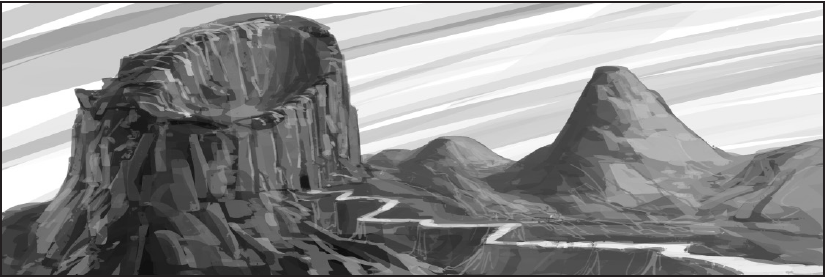
This oddly-shaped mountain is a dormant volcano long regarded as sacred to the skraeling tribes. We get a write-up of Half-Face's backstory. Basically he's a dorvae fiend with Wizard levels (Illusionist) disguised as a thyrdreg troll. Half-Face gained popularity among the skraelings by passing himself off as a great prophet, insisting that recent maladies are divine punishments for tolerating the presence of the colonists. All so he can gradually build a miniature kingdom in this tiny corner of the world with himself as head.
Half-Face and the bulk of his forces lair in a fortress known as Smoky Lake Crannog which is on an artificial island surrounded by the crater's lake. The trail leading up to the mountain and the surrounding lake has a few monstrous encounters: undead skraelings, gnasher lizards, and some raggoths. The crannog has a large contingent of skraeling warriors and shamans, 5 biclopses, and 7 wolf-like raggoths to act as hunters. The adventure mentions the patrols and troop placements of the enemies around the fortress depending on whether or not the alarm has been raised. If Half-Face dies the chain of command passes down to his shamans, and if they and half the forces die the remaining skraelings flee into the Highvale. Some of the rooms hold monsters in captivity such as giant assassins bugs and a rogue froghemoth which lairs in a lagoon the inhabitants give a wide berth.
However, there may be one person in this complex willing to reason with the PCs. A blind skraeling shaman by the name of Gray Bear is not too fond of Half-Face's ascension and has an inkling at his origins. Although not a fan of the colonists, he is undecided as to whether his new leader is ultimately helpful or harmful to his people. Gray Bear has an invisible pipefox companion to whisper into his ear if the PCs try to take advantage of his lack of vision. If the PCs remain nonviolent, Gray Bear tells them his suspicions and makes a deal: if the PCs kill Half-Face but spare any other skraelings they meet, the shaman will give them some healing potions as well as the dorvae's personal quarters. After which he'll dive into the lake and make his way to the Highvale.
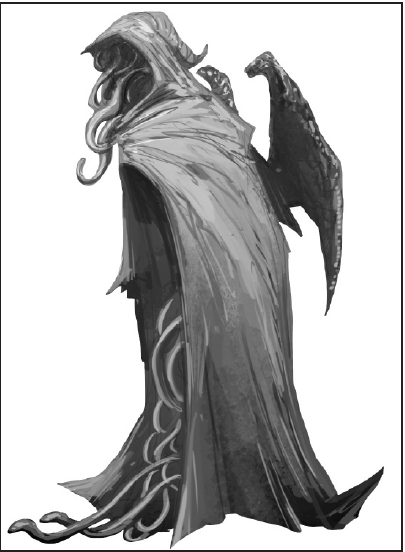
Half-Face's personal lair is high security. A plank covering twilight mushrooms is triggered to smoosh them and release poisonous spores. This trap also alerts him to intruders, and his secret door closet is home to an adamantine cobra construct. Half-Face will reveal his true form to the PCs, exposing him as that of the Sceadugengan and forcing a Will save which stuns instead of shakens.
Half-Face has quite a few good spells, which he'll but to use if he has time to buff himself before combat: Blur, mirror image, invisibility as self-enhancement, then black tentacles as a readied action on the next person who passes through his doorway. If the PCs are still alive, he'll follow up with save-or-suck spells such as feeblemind, phantasmal killer, and rainbow pattern. Like the encounter on the hill, he'll use dimension door to retreat if he suffers enough damage.
The adventure's conclusion is open-ended. If Half-Face is dead, the skraelings give up their war against the colonists and withdraw into the Highvale. The PCs gain great reputations among Nieuland, but the adventure intones this is not the end of troubles. The Jomsvikings intend to send out more fleets to the Oestryn Isles even if their initial raiders were killed. If Gray Bear survived, he'll take control over the tribes, and Half-Face if he survives is now an outcast with no political power. The colonists will further encroach into the lands of Highvale and beyond.
quote:
The PCs can be involved in waging a war of conquest against the indigenous tribes or even ensuring that future contact with the skraelings are not hostile if they’d rather engender peaceful relations with the natives of the Oestryn Isles. Whichever way such future contact between the cultures might go, the PCs can be at the forefront of determining its course.

What a hard choice. On the one hand, I can re-enact an historical ethnic cleansing of a fantasy-coded real world group still suffering the effects of colonialism in modern day North America. Or we can not do that.
Rise of a Jarl Minigame: So a PC who wants to become a jarl must fill out several requirements: they must have Leadership feat, must be at least 9th level in a martial class (or bard) and have no levels in a primary spellcasting class (unusual powers are scary), be 50% human, have 50,000 hacksilver worth of land, and a longship and crew worth at least 10,000 hacksilver. Once these are met, the PC jarl may make Diplomacy or Intimidate checks once a month to attract huscarls and freemen, who must be paid regularly for their services or else have them disperse. A jarl who risks losing his household may lose his followers and assets, and must make a Charisma check to hold onto them. Penalties are imposed for a variety of reasons, but a check may be bypassed upon a successful related quest or leading a financially lucrative raid.
This is simplified, but it sounds like there's a lot of complications and difficulties in becoming a jarl? So what are the benefits?
Only one. The huscarls have at least 3 levels in one of the appropriate jarl-friendly classes and may accompany the PC on adventures. But at this point we're 12th to 14th level and such characters will be of minimal use in combat.
Concluding Thoughts: Even barring the racist overtones of reducing Native Americans into monsters for loot and EXP, The Return of Hallbjorn has a lot of flaws. One, Hallbjorn himself does not play a large role beyond the initial opening. Second is the fact that it seems that the writing process took a sudden left turn: the Jomsviking threat was initially played up in the text and even featured their handiwork on the cover art, but then were reduced to a single optional encounter. Unlike Raven Banners Over Gatland or Plague in Trotheim there is not a sense of impending doom to spur PCs onward. The open world sandbox may be interesting, but the vast majority of locations are single encounters with nothing in the way of dungeons or complexes to explore. Although there's an impetus of "we must save the colonists," this adventure is very greed-driven whereas prior ones just as strongly played on PCs' possible altruistic intentions.
But what gets me most of all is the fact that Ken Spencer was the same writer for this as the adventures in Ulnataland. Comparing them is so jarring that it feels like there was an entirely different writer for this part. The Ulnat were fantasy counterpart indigenous Americans, but had several things going for them. They were human, the major conflict was a civil war with a demonic cult and not the people as a whole, they were just as willing to fight for their freedom than let themselves be rescued, only the cultists had levels in barbarian (most Ulnat were Rangers), and the backstory of Heroes' Rock shown that they had a story of legendary figures in the Northlands Saga alongside the more familiar Nordic heroes.
Join us next time for NS8: the Hallburning, where the PCs must bring to justice a group of cowardly murderers and unmask a conspiracy in the making!
Edit: For what it's worth, Ken Spencer commented on the review on another site about this adventure:
quote:
I normally do not comment on let's read or reviews of my work, but I feel there is something that needs to be brought up. I wrote the settings guide and NS 0-4. By the time of NS-5+ I was heavily involved with my work on Rocket Age and other projects. The rest of the Saga was completed based off of my notes and outlines by Greg Vaughn and Kevin Wright, thus the change in tone and style. Partially this is because of the break in time between working on the earlier part of the series and when work on the compilation book was started. Freelancer have to take the gigs they can, which sometimes precludes doing the gigs they want.
NS8: the Hallburning
Original SA post
NS8: the Hallburning
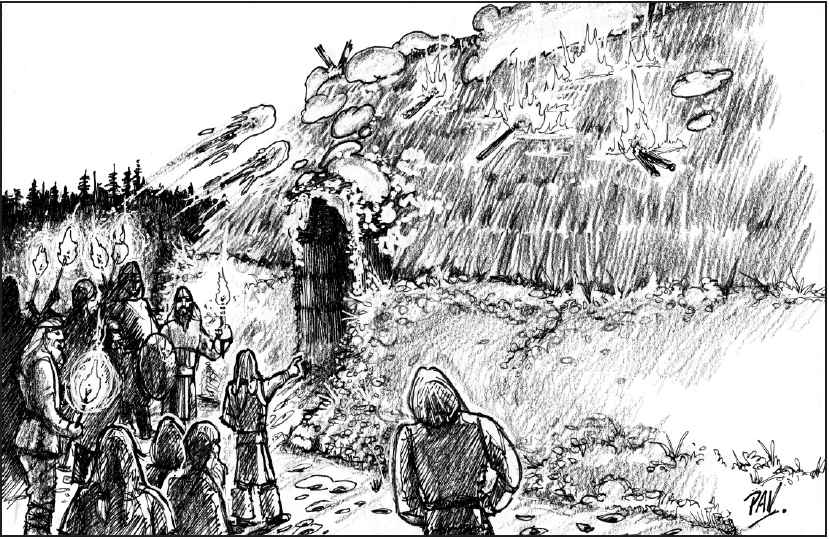
This adventure is scaled for PCs levels 12 to 14. I made a Sliding Scale of Supernaturals in regards to the Northlands Adventure Path during my own campaign. Its creation was when I began noticing a bit of a divergence in magical tone and wonder as the plot continued, less like a steady increase and more like a roller coaster.
quote:
1-Game of Thrones: There are magic, and dragons, and undead, but they're hardly understood, outside of Westeros for the most part, and only show up when shit's about to get serious. From cultural osmosis I learned most of GoT's conflict are things that would be regular occurrences IRL.
2-The Witcher: There are nonhuman races but are segregated from mainstream society. People know about the existence of monsters and there's an occupation specializing in dealing with them although there aren't many Witchers surviving. Magic exists and is a powerful tool, but it's mostly in the hands of a few sorceresses and most problems are solved with weapons and alchemy.
3-Skyrim: The lands are home to all sorts of peoples, human and otherwise, in significant numbers. Magic is not a cause for alarm unless used to commit crimes and for sale by tutors and in books. Enchantment, exotic technology, and the like are available but mostly in the hands of the wealthy. Some creatures such as dragons and master vampires are the stuff of legend, and there was a time portals to hell were spawning all over the world but that's in the past.
4-Forgotten Realms: The Red Wizards have a countrywide divination system. Silverymoon has a mythal overseeing the city's defenses. The viking pirate city of Luskan has a council of high-level magic users with access to the highest tiers of magic. The southern nation of Halruaa is entering a post-scarcity utopia where 33% of its population are wizards. Waterdeep's infamous mountain dungeon is so renowned there are entire industries dedicated to serving the adventurer economy. Gods walk the earth.
Initially the first few adventures hovered around 1 or 2, with Wyrd of the Winter King shooting up to 3. Death Curse of Sven Oakenfist and Plague in Trotheim were rare 4s. When we come to the Hallburning, things slip back down to 1. The primary evil in this case is not fiendish cults, risen spirits, or the machinations of wicked mages but a more down-to-earth, human corruption. There are monsters in this adventure, but they are tangential encounters when it comes to hunting down the perpetrators of one of the worst acts one can do in Northlander culture:
The hall of Gundrik Arison, Jarl of Vestfemarken, was attacked by raiders at midnight. They blocked up windows and doors as they threw torches in the homes and barns of people lay sleeping in their beds. The jarl's wife Runa (not the one from Spring Rites) was the only survivor, bearing horrible wounds. After telling others of this terror, an emergency meeting of the Althing of Storstrøm Vale was called. Three of the hallburning's participants were captured and force to talk. They named the master of the deed as Cnut Anglison, Jarl of Østfold who long bore a grudge against the Arisons. The Althing ruled that the Anglisons were declared non-entities whose lands were open to raiding and Runa's brother Heinring Erikson of Roskiled offered five pounds of hacksilver for the head of each hallburner.
Cnut Anglison is guilty as sin, but Jarl Heinring is an accomplice. He long desired a greater share of his family's fortune, and made a deal with Cnut to burn the hall while offering to do his part to cover up his trails. Cnut would gain his revenge, and Heinring would inherit Vestfemarken through Runa. But with the ruling at the Althing, he double-crossed Cnut by helping capture the men who named and shamed him. This way, Erikson can inherit his family's lands as well as Østfold's. Our adventure begins as the PCs meet Heinring and Runa in their home in Trotheim. The word of the event spread far and wide so the party will at least have heard of it. They inform the PCs of the background and the reward (five pounds of hacksilver plus the Wave Sword, Heinrig's longship). They also get the chance to see some other bounty hunters in the hall who they can learn more information about by skill and magic.
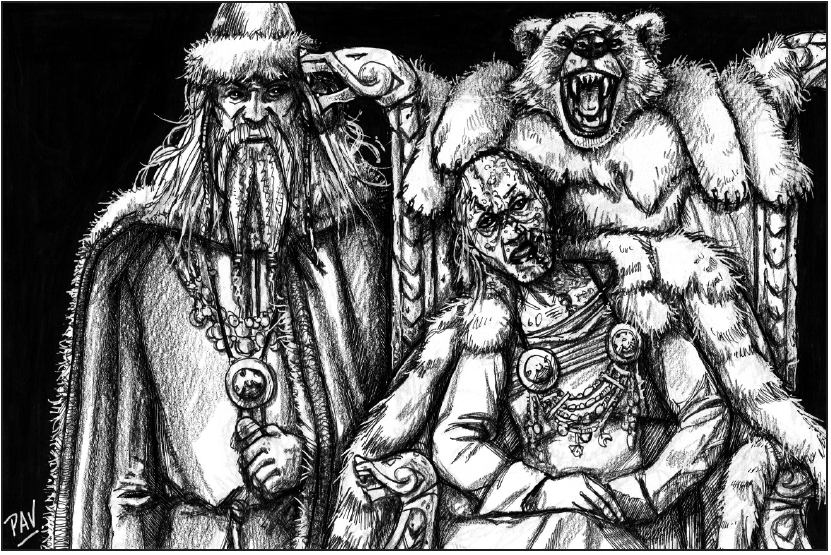
What I Changed posted:
In the default plot, the involved parties are those the player characters have never heard of or met earlier on in the Adventure Path. The primary hook for the Hallburning is righteous justice as Northlands society is honor-bound to take action against those cowardly enough to slaughter an entire hall's inhabitants in such a way. So instead I made some major alterations to the Hallburning while keeping a lot of the encounters intact:
First off, I set the adventure in Hordaland and made Jarl Magnus Hrolfsblood the main villain of this adventure. He's a Lawful Evil feudal despot whose grandson is destined to be High Køenig and unite the Northlands. As NS10 has the Empire of the Huun invade the Northlands, and given how I tied them in with the Jomsvikings, I made it so that Jarl Hrolfsblood learned of their influence via what his son saw in the scrying pool back in Raven Banners Over Gatland. As the Køenig-to-be is still a child, Magnus took the matters of fast-forwarding the prophecy into his own hands. Since the Hrolf clan established a peace treaty with the Gats and Estenfird is too meager to put up a united front, the Jarl launched a false flag attack against Silvermeade Hall. The Hrolf Vikings wore Hrolfland-forged plate armor to look like Southlander knights, and Cnut Anglison was the leader of the raid. The idea was that a core contingent of forces would flee to the Tin Mines (a dungeon in this adventure) while the others discarded their armor and took strategic positions around Hordaland.
Njal, horrified at this as he just learned of the raid's target while on the longship ride, turned on his fellows and escaped with Runa while Jarl Inga and her husband died in battle. Sometime after, Jarl Magnus Hrolfsblood was in Halfstead, telling others of the dreadful attack by the Southlander "lobstermen" while en route to Hordaland for a trade moot. He intended to unite the people in a frenzy against the "foreign hordes." With his son presumably dead from the false knights (not a part of his plan but one he adapted to) and hoping to lead a glorious battle against the ones in the Tin Mines, Magnus would gain great acclaim for this deed. He'd have both the popularity as well as assembled forces necessary to take over the geographic trade hub of the Northlands. This would be but the first step of turning the region into one nation as a united front against the invading Huuns.
The three other groups of bounty hunters are meant to be possibly-recurring villains or allies through this adventure seeking to get their hands on Cnut first, although Javik is almost guaranteed to be an ally and the Ravensons are opposition by default. Even if the PCs gain Dorna's respect, in a later encounter she will merely try to capture and disarm them rather than kill them. A few encounters feature the bounty hunters, but if they are killed prematurely the next ones will not happen. Successful divination spells and skill checks can impart personal information about them.
Dorna Helsdottir and the Vicious Get: Dorna is Two-Face if he was a woman godi of Hel. She has a twisted sense of justice, more than eager to punish lawbreakers in her goddess' name but has no problem killing those who so much as get in her way. She has a skald partner by the name of Adevir Óddson fond of writing poorly-worded poems about her. The Vicious Get are a band of barbarian cutthroats who only follow Dorna and no other.
The Ravensons: This three-person adventuring party seeks to make their way up in the world by claiming the head of Cnut and his hallburners. They include two fighters, Silent Tor and Grondi (spiked chain, poisoned heavy sword), and an arctic druid by the name of Vigdís Snowfox.
Javik Wolfsblood: This is the Wolverine of the bounty hunters, a wild ranger who relies only upon himself and his trusty giant wolf. He was a childhood friend of Runa and secretly loved her yet respected her marriage to another. Javik's not in it for the money or reputation: he wants revenge, pure and simple.
What I Changed posted:
I only used Dorna Helsdottir for this. She had a pack of Advanced Winter Wolves instead of the Vicious Get, and I reworked Adevir to be an alchemist who throws runestones instead of bombs. She believed that Njal Magnusson was one of the hallburners and kidnapping Runa, so she sent her wolves to gradually wear him down as they went through the forest of Hordaland. The PCs convinced her that she was making a mistake, but once her wolves get a quarry nothing would stop them. She reluctantly let the party kill her wolves to save Njal. This encounter took place before the arrival at the High Pass but after visiting Eiderlec.
Storstrøm Vale
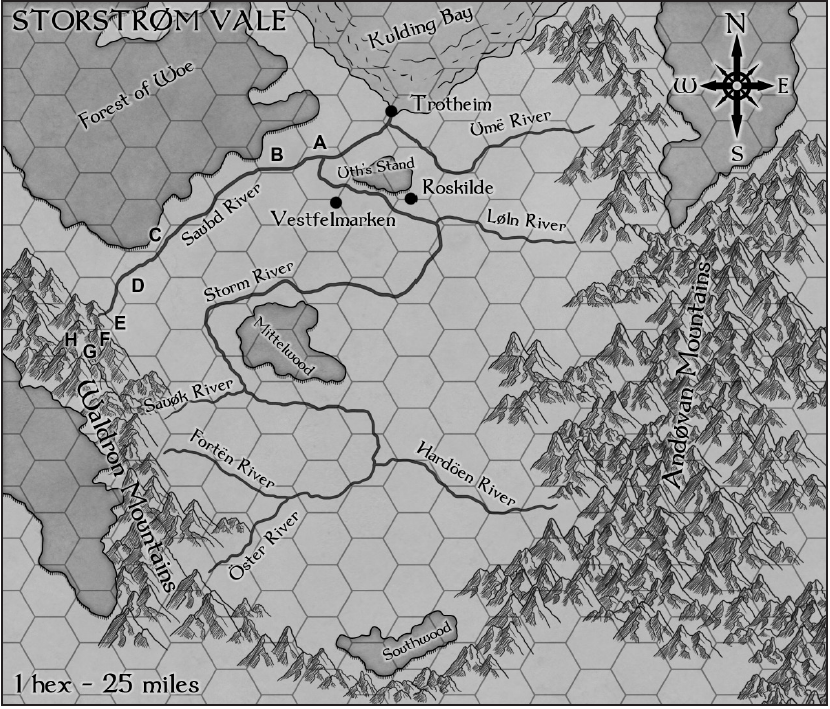
The PCs learn from Heinrig and Runa Gundrikswife that Cnut and his men are somewhere up in the Waldron Mountains. Specifically they are holed up in an Andøvan ruin which has an auto-fail to all divination and teleportation magic within a 1 mile radius, a classic Pathfinder standard of shutting down powerful magic instead of building adventures around their possibility. This is all so that the adventure can force the PCs to rely on mundane means of tracking a 175-mile trail. We even get a one-page description on Trondheim ponies if the PCs need some lent to them, and a possible setback if they do not keep constant guard over their mounts: one of the Ravensons breaks into their stables and absconds with their mounts.
quote:
The PCs may have the magical capabilities to chase down the Ravensons and overtake them before they get too far away, but remind the players that taking the time to do so only gives the other bounty hunter groups more time to get ahead as well. The missing mounts will not be recovered before morning, so the PCs just have to wait and hope to overtake the honorless curs on the road.
At this level, it's entirely possible for a Summoner to have a flying eidolon, for a Sorcerer or Wizard to set up Contingency spells, for a Druid or Ranger to have an animal companion powerful enough to cause a ruckus against some level 8-9 upstart adventurers, or any other number of means to ensure that a simple snatch-and-grab is unlikely to work for long.
Our next encounter involves a first meeting with Doran Helsdottir, who legally purchased a thrall who was working off a weregild so she can sacrifice him for good luck. Technically speaking Dorna is legally in the right, but the thrall was about to pay off his debt in full in 2 months. She will give the PCs an hour to replace him with a more suitable sacrifice, or if they persist she will order the Vicious Get attack the party to take them as sacrifices instead!
After this encounter resolves, Javik returns the PCs' stolen mounts to them. Although he is wary, he has a sense of honor and figures that the PCs would be a better bet in taking down Cnut than some desperate horse thieves. He refuses any offers to work together, stating that he hunts better alone and automatically travels faster than the PCs if they try to follow his trail.
The trail along the Saubd River to the mountains includes seven linear encounters. Two involve tangling with the Ravensons one of which has them sabotage a ferry's crossing, one involves a sudden snowfall, another a completely-unrelated band of Mongat raiders seeking to kill the PCs for loot and experience, and a possible ambush by Dorna Helsdottir.
One of the more interesting encounters involves a crag giant named Norgrun and his gorgimera pet who is scavenging the already-raided ruins of Østfold. He is a tough customer, capable of summoning earth elementals to help him fight. But in exchange for beating him, the PCs get the Regalia of Gunnlagr as treasure (chainmail, maul, and helmet) which can resize to fit them. There are also a pair of human children kidnapped from the hall of Eidrelec which is on the way to the mountains. Bonus Experience is gained for ensuring the children make it back alive.
What I Changed posted:
I had it so that the PCs encountered the crag giant among some Andøvan ruins in the Forest of Woe. He managed to capture Runa (the sorcerous daughter of Jarl Henrikson) for his stewpot when she and Njal got separated from the winter wolves. She replaced the two children, obviously, and the PCs went to Eiderlec on account that it was on the way to Halfstead and likely had other survivors of the burning of Silvermeade Hall.
Our last encounter for this chapter is in the village of Eiderlec, a small mining town ruled by Jarl Luthr Eider and his wife. The two children from the giant encounter are his niece and nephew. Whether they tell him or he guesses, the jarl figures that the party is hunting for the hallburners and reveals that his huscarls saw no sign of them around. He invites the PCs to stay for a spell. Unfortunately Cnut Anglison caught word through contacts that some bounty hunters are headed his way and sent out several warriors to burn down Eiderlec's village. Eight of them (a 10th level fighter and 7 7th-level Warriors) silently take out the village's lax security unless the PCs take precautions. They throw torches on the roof of the hall and wait for people to try and flee out the front door to slaughter them in a chokepoint.
This encounter has a series of round-by-round events of what happens if the fires are not put out, ending at round 20 when the roof of the hall collapses which causes instant death (no save) to anyone not immune to fire and able to survive without breathing. A captured raider confesses to Cnut's hideout. The PCs also get a hefty reward of 1,000 Experience for every member of the hall who survives the hallburning.
What I Changed: The Østfold warriors were changed to Hrolf Vikings (out of disguise), and Eiderlec had Hallbjorn's crew present. The party at this point knew that the Hrolfs were invading Hordaland but since they did not know why at the moment, the PC witch was reluctant to visit their hall and end up drawn into some propaganda trap hinging upon cultural honor. She instead spoke in Nûk to Hallbjorn's wife (an NPC of my own creation) about the false flag operation. They learned that the Hrolfs were planning to attack an abandoned tin mine in the Forest of Woe, so the PCs departed there. As they tipped off Hallbjorn's crew and used stealth to exit the village, an encounter was averted. The Hrolfs would have attempted to burn the hall to kill off the PCs given that the party's reputation and magical powers were well-known in the Northlands by now. Along with their connection to Silvermeade Hall, Jarl Magnus Hrolfsblood didn't want any loose ends.
The High Pass
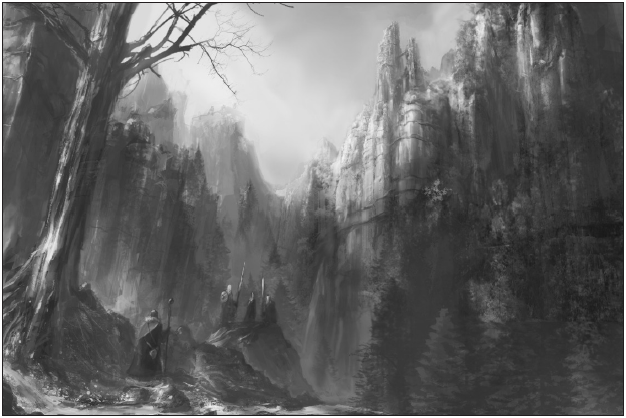
This chapter of the adventure is two dungeons in one. The first is the High Tower which is part of the no-divination no-teleport crumbled Andøvan ruin. It looks over a pass which leads to an abandoned Tin Mine. There are watchers in the tower who will spot anyone during the day unable to conceal themselves, causing them to unload a boulder trap avalanche. If the PCs are on good terms with Javik Wolfsblood, he will come out of hiding. The ranger is willing share the information on the number of enemies and their placements around the tower as well as the entrance to the Tin Mines. He won't fight alongside them, but volunteers to create a distraction to draw away some guards.
The tower itself has two dozen wardogs near the entrance, a trio of hired hill giants, a 10th-level commoner servant with stunted cranial growth and a limp (along with unique special qualities to cover both), 15 Østfold warriors, and Cnut Anglison and his huscarl Hegi Einarrson. There's a secret door in the kitchen (given away by wafting scent of tobacco smoke) which provides an alternate means of going into the tin mines. If you can't tell, the opposition here is woefully undermatched for a party of low-teen-level characters who likely have magical aid. This, along with the heavy emphasis on riding by horseback and mundane tracking makes me believe that this adventure was originally meant to be written at a much lower level.
Cnut's minions will fight as long as they think their leader is safe, but the man himself is cowardly and surrenders to the PCs to face his judgment at the Althing. He is only doing this with the belief that Heinring will somehow acquit him. The adventure presumes that the PCs seek to take Cnut alive, and if they seem intent on killing him while in their custody he will activate his ring of freedom of movement to slip his bonds and escape.
What I Changed posted:
I excised the hill giants to include more Hrolf warriors (who had the same stats as Østfold warriors but wore full plate). Cnut in this scenario was having second thoughts about his role as "villainous Southlander" in the eventual plot to unite the Northlands. When the PCs show up and begin to effortlessly slaughter the false knights he decided that he wanted to die known as a true Northlander and surrendered to the PCs. He offered to use his testimony at the Althing of Halfstead against Jarl Magnus Hrolfsblood on the condition that he be allowed to engage in a duel than to be executed in bondage (a way to secure himself a spot in Valhalla as a warrior). I also made the secret room in the kitchen contain some exotic seeds from Southlander realms which were not present in Silvermeade Hall. Given that such valuables would not ordinarily be taken on a risky voyage to the Northlands, this served as a piece of evidence the PCs could present at the Althing of Jarl Magnus Hrolfsblood's guilt.
In this case the low-level opposition worked in my version. It let the party feel like big damn heroes and showcased how much they rose in power from the common crop of the setting. As one of the PCs put it, "we've fought giant monsters of the Beast Cult and the servitors of Althunak and Loki alike. A jarl mad with power is well within our means." Still, the threat of losing Hordaland to a tyrant as well as the personal nature of their grudge against Magnus Hrolfsblood kept things from feeling too low-stakes.
The mine entrance is concealed, and home to inhabitants all its own such as six wyverns, a carnivorous blob, some traps, and a small family of ogres and their herd of boars. Cnut Anglison has an arms-length relationship with three of the more experienced ogres (trio of Ranger sisters), so he stationed two of his huscarls to keep an eye on them. One's a level 12 barbarian, the other a multi-classed expert/rogue fond of strong-smelling pipe weed. Why so many dead levels in a crappy NPC class I don't know.
The Return to Trotheim
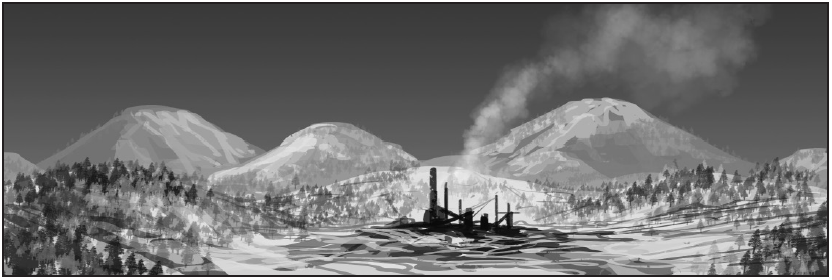
Jarl Heinrig dispatched 13 of his own men (who may or may not be with the Ravensons) to follow the PCs' trail. Their leader, Harald, hails the PCs peacefully. He has payment and a writ of ownership for the longship to give to the PCs as early payment. But if the PCs have no living prisoners, Harald and the Ravensons plan to ambush and kill them and collect the reward for themselves. But if Cnut plus any others are alive, they are nonviolent in their intentions and claim to seek to transport the prisoners back to Trotheim. The scowling faces of the Ravensons are meant to warn the party that they are planning to take credit for the work they done and spur them on. The adventure's all too happy to inform us that any mounts of the PCs are going to be in poor shape from arduous travel and may not be able to keep up. It's mentioned that they can get new fresh mounts at Eiderlec if they saved the jarl earlier.
This is all well and good, but given that the PCs have Cnut Anglisson (or evidence of his death) they can just as easily overland flight/teleport/etc back to Trotheim and the adventure does not take this into account. The next encounter involves Harald planning to execute Cnut (much to the bewilderment of his soldiers and the betrayed Ravensons) and any other hallburner prisoners. Whether the PCs get there in time (and whether or not they can save and ally with the druid survivor) is based on whether or not they gained fresh mounts. If Cnut is dead, a captured warrior will confess to Jarl Heinrig's plot, overcome with guilt over his leader's dishonorable actions. If Cnut is taken alive, he realizes that Jarl Heinrig had no intention of clearing his name, and is willing to cooperate fully with the PCs if they let him die "with a sword in his hand" when the time for sentencing comes. Choosing to honor this grants the party bonus Experience as an appeal to their mind's-worth.
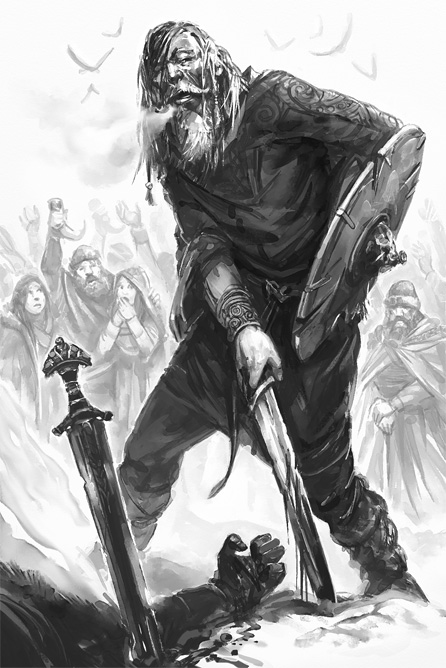
Hillfolk: Holmgang by Merlkir of Deviantart
Once the PCs get back to Trotheim, a crowd begins to stir. An angry one who wants justice to be done and execute Cnut right then and there. Heinrig and Runa Gundrikswife come forth, and there's some social skill checks throughout to calm the crowd, to detect odd body language from the jarl, and whether or not they can call for an Althing for a trial first. Jarl Heinrig and Runa will be very insistent on arguing against this plea, and the PCs have several modifiers they can use as a bonus (saving Eiderlec from a hallburning, showing off the Regalia of Gunnlaugr, etc). There is a "last chance" check to do if they fail at first, but if they fail again a Nonstandard Game Over happens as the PCs will either have to fight every able-bodied warrior in Trotheim and become outlaws or let the prisoners in custody be killed; no testimony against Jarl Heinrig will work until several months later in the spring.
But if an Althing is called, Cnut and the hall burners are put into custody, and Jarl Heinrig will have an assassin disguised as a thrall to poison their food. The encounter after that is the Althing proper, where Jarl Heinrig makes his move:
quote:
“Yes, I’m sure they’ll have quite the story to tell, one worthy of the fireside in the dead of winter when the birch logs burn high and the drinking horns run low. The drunken ramblings of boastful braggarts. I’m sure we’ll all be highly entertained, and the skalds will sing of it for years to come.
“Unfortunately, what I see is a group of foreigners who come to us for a very simple task. Capture a band of outlaws and bring them to justice. Do they do it because they love the Vale and its hard-working people? Do they do it for love of the aggrieved widow who is my sister? No, they do it for silver and a fighting ship in its prime, the last vestiges of wealth from an old woman who has lost everything else.
“Ask them. See if they did not already collect the hacksilver promised for the heads of the outlaws. See if they did not already claim the writ of my sister’s hand for title to the longship Wave Sword. The truth of it is in their eyes even now. No, I know what this is about. They seek to get at the golden goose. Where the wealth of one jarl has been tapped, the wealth of another can be claimed. I’ve had my own men looking into this crew of so-called heroes; I’ve had young lads listening at their doors at night as they went about their chores.
“These cowards wish to finish the ruin of my beloved sister, from whom they have already taken the last of her worldly wealth, and they wish to implicate me in order to get at mine. It is not enough that Runa Eriksdottir must forfeit the work of our father’s hands, no, in their eyes Heinnrig Erikson must as well. And will their bellies for gold be full then? I think not. Then which of you will they lay their greed-filled eyes upon? Nay, these are not heroes of the Vale, they are leeches of the swamp, come to the Vale to bleed us dry in our hour of need. “You there, heroes! You would name me false before the assembly of my own people. I say to you that this will not stand before gods or men. I challenge your champion to the holmgang where the All-Father and his brood can declare the truth of our grievances.”
The assembled Althing is stunned to silence by Jarl Heinnrig’s bold — even brash — words. The silence stretches as low murmurs begin to grow and all eyes turn toward you.
There's so much wrong with this. If this adventure is not being played as a stand-alone, the PCs saved the very city this Althing is in from a horrible plague, in addition to their many other deeds. The immediate declaration of the holmgang is stated by the adventure to be a "trap" so any opinion or ruling of the assembly is nullified due to calling upon the gods. This goes against the Northlands Saga Campaign Guide's rules for the Thing, where a holmgang in a dispute grants half the opposing votes to the winner. And what if one or more of the PCs is a godi of Wotan? Can his holy status counter this?
But that doesn't compare to the anti-climactic ending.
The final encounter of this adventure is a holmgang between Jarl Heinrig and one of the PCs who rose up to the challenge. Heinrig himself is a multi-classed fighter/rogue of 13th total level. He is optimized for sword-and-board fighting and focuses on sundering the PCs' shield rather than going for direct kill with an adamantine longsword (which ignores hardness). But if the PCs' Combat Maneuver Defense is so high, he'll change to lethal tactics. The crooked jarl is also a cheat, having taken a potion of bull's strength beforehand and has a druid within the crowd ready to silently cast warp wood or heat metal on the PCs' shield. Heinrig will declare any obvious magic in this fashion to be the will of the gods, which many in the crowd fall for. Even if caught the judge's lack of magical experience is not enough to declare the duel a forfeiture.
Given that Heinrig isn't going for a kill, it seems that he's trying to disgrace the PCs and have them declare outlaws, right?
Nope! The adventure removes all sense of agency and choice by having a literal Deus Ex Machina to occur. It does not matter if the PC is on the verge of losing or if they're about to win. The goddess Hel intervenes as she possesses the widowed Runa, condemning Heinrig for his crimes as her face takes the visage of the goddess herself. Grabbing a nearby spear she throws it at his throat, ending Heinrig's life.
So in the end, Hel will kill-steal your boss battle and more or less dispense judgment that everyone accepts. The adventure concludes by having Heinrig's longship, the Wave Sword, granted to the PCs along with potential opportunity for the party to claim Cnut or Heinrig's halls for themselves.
What I Changed posted:
Throughout the adventure I provided several opportunities to gather evidence against Jarl Magnus Hrolfsblood; his son Nja's testimony, the lack of kingdom emblems upon the plate mail, the presence of armor markings upon Cnut's skin from the plate mail, as well as the exotic seeds in the tower's kitchen. I had the PCs roll Diplomacy vs Magnus' Perform Oratory to see how many votes they got; there was no need to call for an Althing, as one was already convened in regards to the "Southlander threat." 80% voted in favor of Magnus' guilt, so in order to push himself from 20% to 60% he challenged the party to holmgang. He had a bearskin cloak to use as the arena between the hazel posts, but I allowed the PCs to pick any hides of previous monsters they slain during the Adventure Path. The chose the skull of the Jotund Troll whose mouth was propped open.
I also added customized special moves based upon the advice and fighting styles of a duelists' companions recollected from past adventures. The d20 rolls were made by the appropriate players rather than the duelist, allowing the group a sense of input in the otherwise one-on-one duel.
Our troll-blooded barbarian/rogue won the Holmgang, and the PCs' earlier speech to avoid retaliation against Hrolfland (placing the justice on their jarl) worked as Njal ordered his Vikings out of Hordaland with little consequence.
Concluding Thoughts: The Hallburning is rather weak. The plot is railroady and Cnut's testimony (nor that of other NPCs) does not matter at all given Heinrig's outburst. When it comes to the level of magic at a high-level party's disposal the adventure either does not take this into account or autoblocks it in the case of the dungeons. It's unconnected nature and rather low stakes in comparison to prior quests feels at odds so late in the Saga. The addition of yet another ship (albeit one with superior stats) feels a bit redundant given the PCs had plenty of opportunities to gain vessels of their own earlier in the campaign.
On the plus side, things really pick up again in NS9: Daughter of Thunder and Storm!
NS9: Daughter of Thunder and Storm
Original SA post
NS9: Daughter of Thunder and Storm
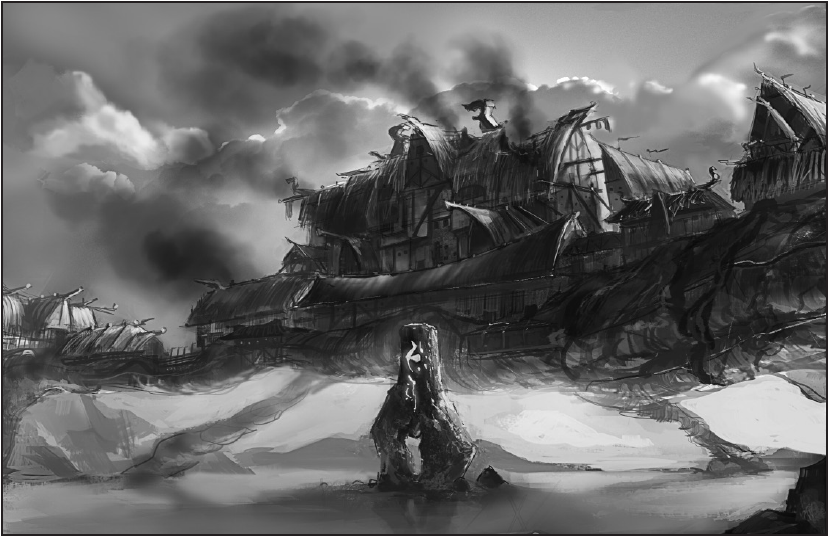
Unlike the previous adventures, Daughter of Thunder and Storms is suitable for levels 13th through 16th. I have not actually run this adventure yet (we just finished NS8: the Hallburning) so I do not have any notes on What I Changed.
There are few great heroes of the North who can match the PCs in power and deed. Hengrid Donarsdottir is one of them*. Unfortunately her time in the captivity of Shibauroth's cultists made her susceptible to demonic influence. After many years Althunak drew upon one desperate attempt before his divine essence is destroyed from the earlier destruction of his temples. And that involves possessing the body of the greatest heroine the Northlands has known.
When Hengrid sails for the Hall of the Hearth Stone, she lays siege to it and steals the sword Kroenarck. This is one of the three artificats necessary to open a portal to the Ginnungagap in Mount Helgastervän, where she can make direct contact with the Lord of Ice and Cold. If the demon-god is successful in this endeavor, he will enact his will on Midgard in full control of Hengrid and bring about the Fimbulwinter...and thus the onset of Ragnarök.
*But if she is dead since the PCs failed Blood on the Snow, Astra Thunderswif is the one to slay the divinity of Shibauroth and her replacement for this adventure.
Our adventure begins with a summons with all possible haste from the Hall of the Hearth Stone. This is the most sacred godshouse in all of the North, and due to its reputation the PCs are assumed to have already been there and studied the environs carefully for teleportation purposes. Hengrid carved a swathe of destruction, leaving plenty of structural damage and an unnatural iceberg covering the hearthstone beneath the building. The senior godi Kollsveinn Hearthson appraises the PCs of the situation: there are unnatural monstrosities within, and he impresses upon the party the need to save the people still inside and to get to the hearth stone as quickly as possible. What Kollsveinn is not telling the PCs is that he has suspicions that Hengrid sought a secret chamber within the stone for the legendary sword. The sword was secret because otherwise all manner of opportunists would have come to claim it and become the next High Køenig.
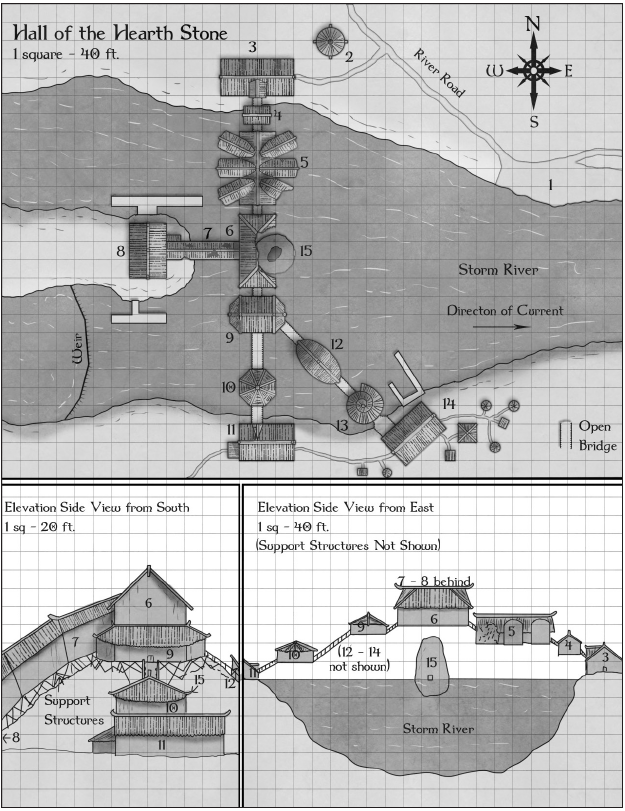
The Hall is an architectural marvel, a walkway held up by magical and mundane supports over a river. Inside are various halls with shrines to gods and carvings displaying the history of the Northlands. The dungeon is rather straightforward, although Area 15 (the hearthstone) is surrounded by an invincible supernatural ice stone. The only way to it is via descending through a hole in Area 6. The complex is full of ice elementals, devil gods (cold-based animals), godi and former members of Hengrid's crew taken over by Althunak's fell power (becoming evil clerics or barbarians), frost drakes, and even a glacial ooze from the Ginnungagap. The "boss" is an ancient white dragon who is summoned if the PCs break the snow crystal, a magical giant snowflake anchoring Althunak's dread influence in the Hall. There are several survivors the PCs can rescue as well as the Warspear of Kein, a treasure in a storage closet. The legendary weapon was originally taken down from a mantle by the godi for cleaning and then forgot about somehow. The island containing the Hearth Stone has evidence of a destroyed room as well as an empty treasure box and debris.
Once the Hall is cleared out, the godi and hirthmenn will move in to make repairs. Kollsveinn meets the party again and explains the truth of the Hearth Stone's secret chamber and the sword within that Hengrid Donarsdottir somehow knew about and stole. Via prayer with the Æsir he learned that she is under the influence of a powerful spirit of the Ginnvaettir: Althunak. However testimony from a surviving godi mentions that even as she destroyed the hall she spared him and gave him her waterskin so he would not die of thirst. This is seen as evidence that the real Donar is still somewhere inside, fighting and exhibiting one of the Nine Virtues of Donar (hospitality).
The Nine Virtues of Donar play a major role in this adventure. Right before the final battle the party has the opportunity to impress upon Hengrid of the hero she still is by using examples found throughout the adventure. The more examples they give, the less power Althunak has over her body. In fact, the form of the final boss of NS9 is effected by the amount of examples given. The saved godi utters a prophecy...
quote:
"Three keys he needs to feed his fury;
Three keys to loose infernal gate.
Nine virtues hold the daughter’s bloodright;
Thrice times three quell icy fate.
When King walks forth from frozen prison
The mountains quake, their stones shall knock.
Stopped must be the Fimbulwinter,
Lest come the war of Ragnarök.”
...and then one of the godi stabs him to free an ice oni secretly implanted within him!
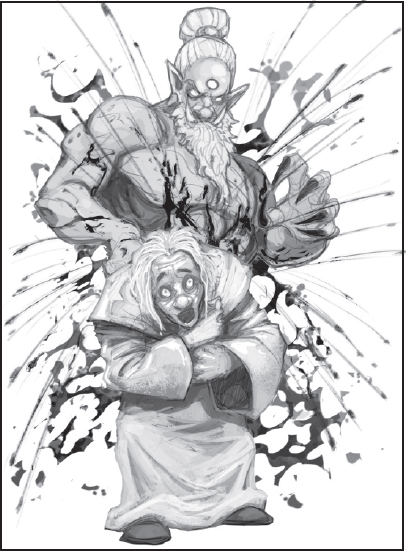
In the aftermath of the combat, the PCs can make knowledge and divination checks about the Nine Virtues of Donar, Ragnarök and the Fimbulwinter*, as well as Korenarck's legacy, how it was forged in the fires of Mount Helgastervän, and the Gates of Hel within that mountain. There is a sidebar on if the party uses divination to track Hengrid: Kroenarck has an anti-divination field, but indirect things like tracing Hengrid's route and lucky yes/no questions via Commune work. Otherwise Kollsveinn will use his spells to reveal that Hengrid crossed the North Sea in record time and wrecked her ship on the Virlik Cliffs (in Nûkland). There's also mention of how wind-based magic can be used to speed the party's travel by ship if they don't teleport.
*the end of the world and the three-year-long constant winter preceding it respectively
Additionally, each chapter further has updated information for divination spells cast regarding Hengrid and the recovered keys required to open the Gates of Hel and thus entry to the Ginnungagap.
The Virlik Cliffs
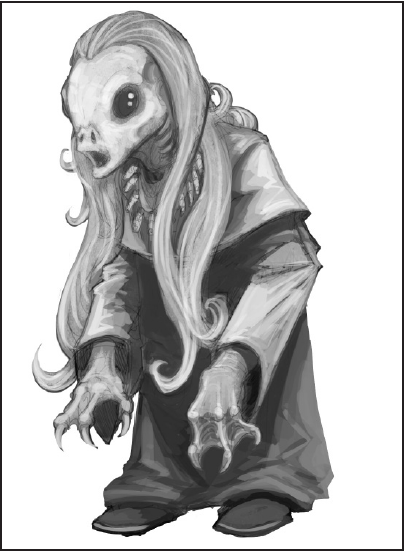
This is another dungeon crawl, where the PCs find the wreck of Hengrid's ship and later on a dungeon in the form of a cave filled with Wikkawaks (goblinoid monsters). In fact, the first time in this entire adventure path do goblins of any sort appear! A secret shrine to Althunak is located in a fog-filled cave near the crash site, where Hengrid claimed a prehistoric idol of Althunak within as the second key to the Gates of Hel. The PCs may find it on their own, or by meeting an entity known as Old Sea Mother (pictured above) who will tell the party about it as well as Hengrid's movements to the Wikkawak lair. But she will only cooperate if they beat one of her children in a game of Hnútukast, a game where two parties throw bones at each other until an eye is taken out or blood is drawn.
The Wikkawak lair feels a lot like filler; Hengrid tortured and corrupted the chief, causing him and the rest of the tribe to resort to previously-unpracticed cannibalism. The Wikkawak within are low-CR monsters with levels in the Warrior NPC class at best, with the only "strong" encounters the chieftain, his jotun consort Griseld, and a pet akhlut in a nearby chamber. The main focus of this dungeon plotwise is to have a surrendered Griseld remark upon how she has never seen a Northlander warband "show such discipline" in regards to Hengrid, which is one of the Nine Virtues of Donar.
The Tundra and Nûkland
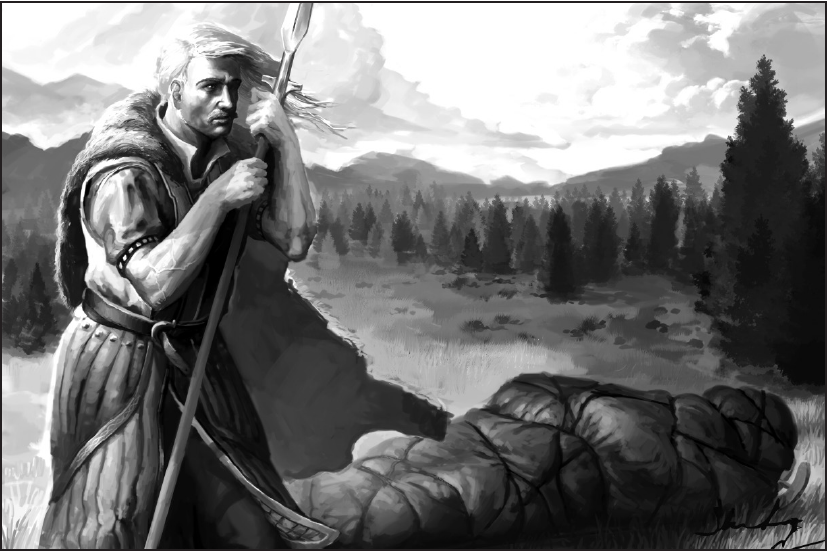
After the PCs make their way out of the caves, the party follows Hengrid's trail out into the tundra. Every few miles are dead wikkawaks and human huscarls with choice pieces of flesh removed. Hengrid is searching for the third key, located in a forgotten crypt where the first Winter King, and first worshiper, of Althunak rests. Along the way the PCs come across the ranger Geirolf who was originally hunting for monsters with his companion. But a savage wolf-beast has been harrowing him, even as he stands guard over his fallen ally's body for 9 days (an oath he swore). It's 8 days in and asks if the PCs can help stand vigil with him for one more night. If they agree, he promises to serve them as thrall for a year and a day. He provides information to the party if they stay, telling of how he met Hengrid's war party. Several of the beasts sought to devour him, but she struck one of them down with her hammer to spare him. In spite of her distinctive appearance he could not believe that she is the heroine of old, but notes that she gave him an amulet of Donar before leaving (loyalty virtue, refusing to be disloyal to the symbol due to her actions and giving it to someone worthier).
As for the wolf-beast, it is an advanced greater barghest with the jotunblood template. Technically a subversion of the rules as the barghest does not have the giant subtype. Later encounters include a wendigo seeking to give nightmares of starvation, cold, and cannibalism to the party while they rest. The next encounter's a camp of Hengrid's left-behind human and wikkawak followers who fell to cannibalism and turned upon each other. They are under the thrall of the wendigo's psychosis. At one point one of them will transform into a wendigo themself and fly off into the night, prompting a surviving berserker to realize his eventual fate and ask the PCs to grant him a merciful death.
The crypt of the first Winter King is a spooky mound containing an ancient skeleton encased in ice with its skull removed. Hengrid ordered her minions to excavate the mound, where she removed the head to take the crown and third key for the Gates of Hel. The wendigo previously stalking the party enters into the crypt with its howl attack to possess the skeleton as a winterwight.
The final encounter for this chapter is in the taiga forest, with increased evidence of Hengrid's band diminishing in number as the bestial huscarls consume each other. The only encounter here is with a manitou who appears as a tree-like giant. He tells the PCs that Hengrid wrestled a forest drake and forced it to fly her to Mount Helgastervän. As for her remaining minions, they transformed into baykoks who interrupt the party's conversation; the manitou vanishes instead of fighting. Due to their cannibalism they will attempt to eat any fallen enemy, but not before wasting time fighting among themselves. The manitou will return, granting a magical pinecone for defending the forest (saving throw bonus) and remark it odd that the monsters stayed. "Apparently she left them behind in order to complete her quest without their help." Self-Reliance, another of the Nine Virtues. If the PCs need help traveling to Mount Helgastervän, the manitous calls an elder air elemental to carry the PCs in its whirlwind.
Mount Helgastervän
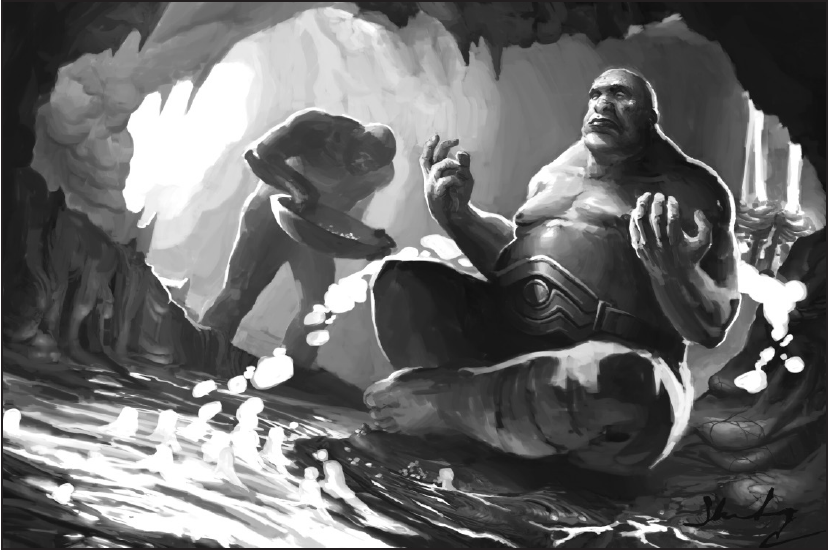
This legendary mountain has a prominent presence in the stories of the North. It was where Kraki Haraldson recovered Kroenarck from its depths after slaying a dragon, and is home to a legendary dwarven forge. It is currently home to a kingdom of giants. There are many communities within this mountain beyond the scope of this adventure: the fire giants are a labor caste for a tribe of jotuns deeper within, and the deepest caverns hold a clan of dwarves. The mountain entrance is guarded by Rethryvimar, a wounded tarn linnorm within a subterranean pool. She is weary from a fight with Hengrid and willing to talk with the PCs instead of immediate battle. She does not wish to let mortals pass through her territory again and informs them of a side passage, only to betray the PCs in a second thought of not wanting others to know of her lair. The PCs may figure out that Hengrid displayed another of Donar's virtues, meaning she "refused to back down and shown great courage even when she didn't have to."
The rest of the dungeon is a fire giant fortress as well as various lava flow caverns and tunnels. Fire giants, volcano giants, and fire lizard pets are frequent encounters. There's a surprising variety of types, from regular old fire giants, fire giant huscarls (Fighter levels), fire giant smiths (hammers but no armor), and even fire giant children who use ogre stats (WHY?!). There's a forgotten tunnel where Kraki Haraldson cavred a Runic inscription into the wall:
quote:
53 days out of the Vale entered the din of spears with the Red Beast Verthenstyr in its cave. 4 good men soaked in battle-dew to stand upon the banks of the Storm nevermore. A sword for kings as a prize. K.H.
It is possible that the PCs may be able to earn an alliance with the volcano giants, who serve an old red dragon named Eskvrcar. Although seeming servants of the fire giants, the dragon wouldn't mind having their lands and resources to herself, so the PCs may be able to get an audience with her via a shaman middle-man. If the PCs act appropriately obsequious she offers to grant them safe passage and an item of choice from her hoard if they bring her the head of the fire giants' jarl.
Speaking of treasure, there is a secret artifact within the dungeon's temple of Surtr: the Mead of Poetry. Given that this artifact instantly grants 3 levels in Skald (the advanced class guide or the Northlands archetype), that does raise the issue of whether or not to let the PC level up in the middle of a session or not. Leveling up in Pathfinder is time-consuming in comparison to other RPGs.
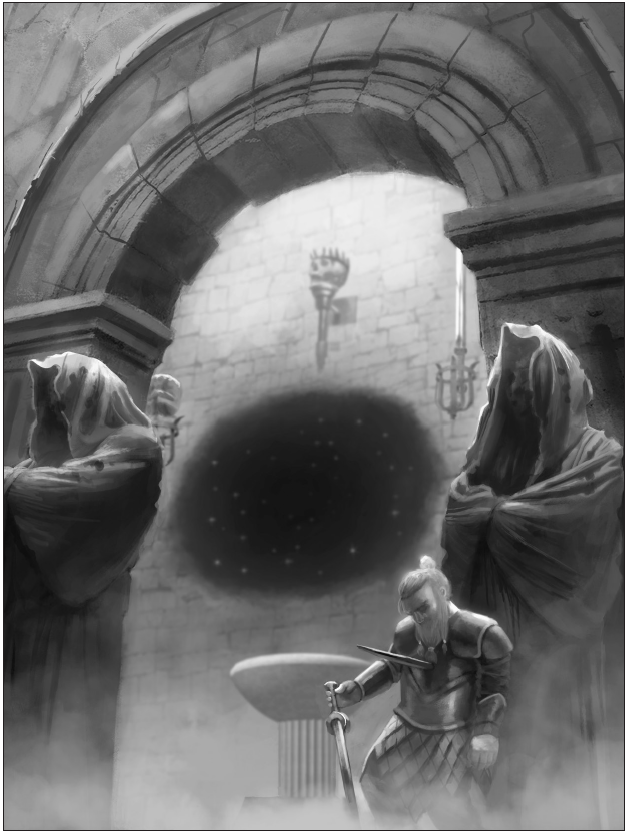
There's also a secret door here leading to the final section of the dungeon. It is guarded by a cinder knight and leads to the Gates of Hel. On the way the PCs can find the fabled forge of Bvalin and a very deadly trap which turns the door and surrounding walls into lava (which deal 20d6 damage per round). Alas, the forge's smith is deceased, pinned to a statue by the Gates by the possessed Hengrid. He has a weapon tied to his hand via a piece of fabric torn from a winter wolf cloak. A successful knowledge check points out that dying with weapon in hand guarantees your place in Valhalla, and Hengrid displayed the virtue of mind's-worth. But due to the dwarf's oath to guard said gates, he still exists as a ghost here.
Bvalin tells the PCs that Hengrid already passed into the Ginnungagap, the void-like portal floating between the statues. Although she used the three keys, all hope is not lost: the PCs may yet deny Althunak's vessel by stopping her "by skill of tongue or spill of blood." He also informs the party that they have enough time to rest if they need it (10 hours), but due to his oath Bvalin must face the PCs in battle before they can cross. He will rejuvenate and keep watch over the three keys (all in depressed sconces) to ensure that nobody closes it while they're on the other side.
The Ginnungagap
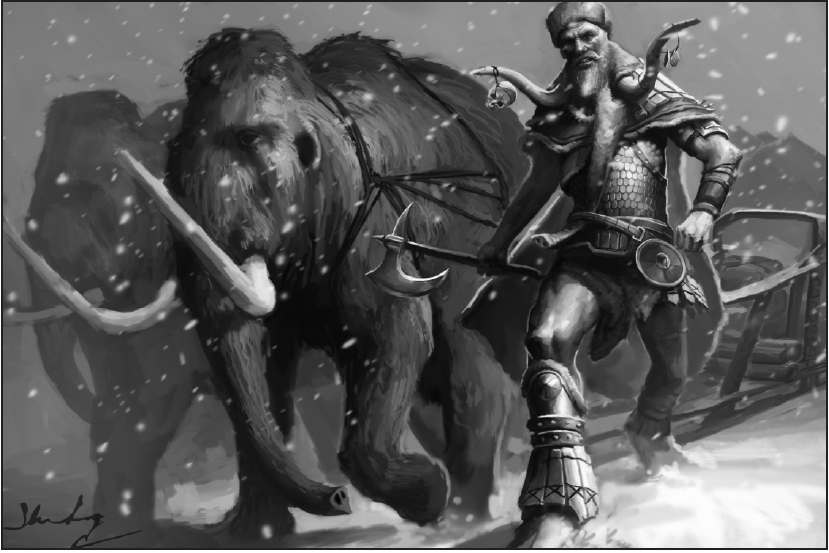
The final chapter of this adventure takes place in another plane entirely, the primordial realm which existed before Creation. It is a hell-like realm home to evil outsiders, wendigos, and the souls of unclaimed mortals. The Ginnungagap has its own planar traits: it is strongly aligned with Chaos and Evil, so characters and spells opposite one or both alignment suffer inferior mental skill checks and caster levels. This portion of the realm is metaphysically beneath the Lake of Frozen Screams, meaning the edges wrap in on themselves. One hour in this place equals one day on the Material Plane.
The first challenge within this realm is a cave full of acidic negative energy geysers which cause the party's flesh to degrade in small black flakes. Hengrid left a trail of flakes behind her, lending evidence of perseverance as one of the Nine Virtues from the horrific damage she endured. Outside the cave is a bleak, black wasteland with smoky and smudged features. The dark sky has bluish light in the impression of a frozen lake, with a distant hillock the major feature with a corpse-like giant laying upon it. Hengrid Donarsdottir is here, holding up her hammer as green flames descend to slowly bring the comatose Althunak to full power.
Travel to the hillock is subjective and does not follow the laws of physics. There will be a certain amount of random encounters beforehand, with the number depending on the Will Save of a designated PC guide. They are appropriately creepy, including advanced gibbering mouthers, lesser banshees, various kinds of demons, and even a mammoth-drawn sled upon which sits Kimrach Ulnslayer, a frost giant who played a major role in the subjugation of the Uln.
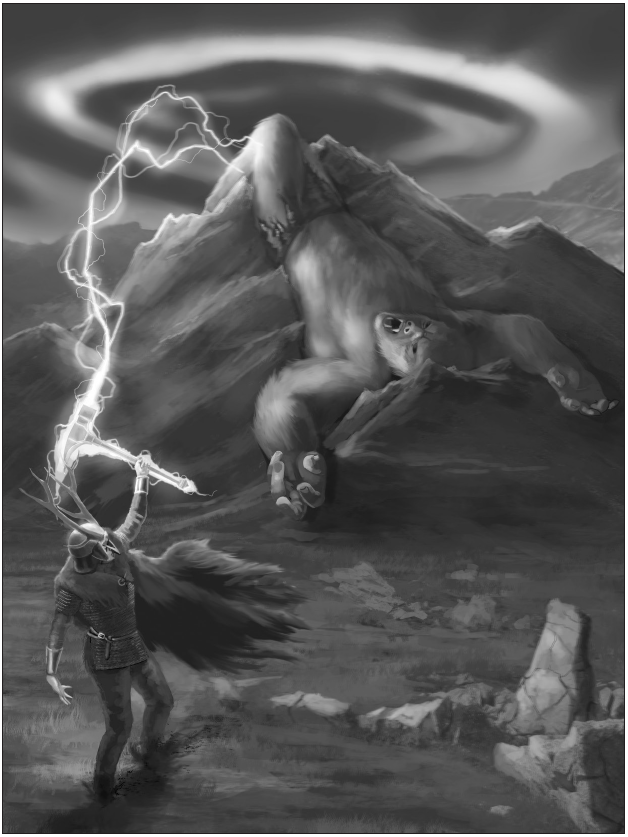
The final encounter of this adventure takes place as the PCs come up to an obviously-corrupted Hengrid Donarsdottir. The ritual to revive the god to his full power is nearly complete, and instead of immediately attacking she engages the PCs in a mocking conversation. Although she speaks confidently of the Fimbulwinter's inevitable arrival, a Sense Motive check looks into her eyes to reveal the distraught heroine within. As the ritual has a few hours to go and she will not attack until the PCs do, the players control the pace. This is handled not by skill checks but by pure improv role-playing. For every example of the Nine Virtues they give, the weaker Althunak's hold gets. PCs who make clever use of kenning, deliver their speeches in a suitably heroic oration, as well as any other examples the PCs come up with that the adventure did not include, add additional "examples." A list of eight virtues are provided along with their place in the adventure. The one I did not mention earlier was her Industriousness into getting into the mountain by collapsing a stone outcrop to create a precarious causeway. The ninth unmentioned one, Truth, comes into play later.
Once the PCs finish their speeches, Althunak loses patience and attacks via a demon-possessed Hengrid. There are one of five forms she takes, all with varying levels of ex-paladin, from most to least powerful: a wendigo (CR 20), an ice yai oni (CR 17), a jotun (CR 14), a cold rider (CR 13), or a yeti (CR 12). As a result, the climactic battle varies largely in difficulty; however this is only Althunak/Hengrid with no assistance against a full party. This means that the action economy is in the PCs' favor. All of the forms allow her to generate a huge iceberg as an AoE attack, DC 28 Will save attacks (touch attack which corrupts the soul, or a bomming voice which Dominates Monster on evil creatures) in addition to the monster's natural abilities and the properties of her signature weapon Thundersurge.
Regardless of the form, the Experience is suitable for a Challenge Rating 20 encounter due to the climactic nature. If Hengrid is defeated in battle, the green fire nimbus retreats from her and her broken body changes back to her original form. The fire takes on the form of Althunak as he attempts to bring the Fimbulwinter to reality:
quote:
“She is no more. She is nothing. Althunak is all. There is no truth but Althunak. Althunak is here!
Yet Hengrid gradually awakens, confused and believing herself to be the evil god as the demon lord begins to shred the last of her identity:
quote:
Tendrils of green flame continue to stream from the maiden’s still form and cause her cheeks to grow hollower, her eye sockets to sink deeper. The demon is drawing the last bit of the essence it needs as it feeds off of her to reach its full might. The sunken eye sockets flicker, and you catch a glimpse of clear blue eyes. The maiden yet lives if only for a moment more. She struggles to speak, “Who? … Is that me? Am I Althunak?"
There is one more virtue: truth. Whether by coming to their own conclusion or via a Knowledge check, they can remind the daughter of Donar of her true self along with bonus Experience to go with this. In a final act of defiance, her soul fades from her body as Althunak rises seemingly at full strength. Yet the icy barrier of the sky cracks open as Donar himself soars down on a goat-driven chariot! With a mighty blow with the power of an erupting volcano, the Æsir slays the Lord of Ice and Cold once and for all!
With a respectful reverence, he places a hammer amulet in his daughter's hand, her faith her truest weapon. He shares a meaningful look at the PCs before he departs for Asgard. Hengrid seemingly rises from the dead, yet she is not of Midgard any longer. She is a valkyrie, and in addition to heartfelt thanks she mentions how her duty is to find the greatest of heroes upon the battlefield to bring them home. And she can think of no worthier heroes than the PCs which stand before her.
Concluding Thoughts: This should have been the final adventure. It is a bit of a straight dungeon crawl with unrelated enemies, but the opposition really sets the epic tone for the Northlands. Giants, dragons, demons, venturing to the primordial void, engaging a role-playing speech challenge with the final boss who is the god-possessed body of the setting's greatest hero. The ending part with the valkyrie hits me right in the feels and is a perfect way to end such an epic campaign.
Overall, Daughter of Thunder and Storm made up for Return of Hallbjorn and The Hallburners because it actually felt heroic. I will say that the alternative option for Hengrid's death in Blood on the Snow feels weak, in that it's an unheard-of NPC cleaning up the PCs' mess from that time. Otherwise I like this.
But what could the foe of the final adventure be? With Althunak's influence gone, what is there left? The Jomsvikings? Loki angry at being thwarted in Plague at Trotheim?
Nah, it's a completely unrelated and unheard-of bad guy faction: the Huuns, inhabitants of a distant mysterious empire from the eastern continent of Libynos. Join us for our final adventure in NS10: the Broken Shieldwall!
NS10: The Broken Shieldwall
Original SA post
NS10: The Broken Shieldwall
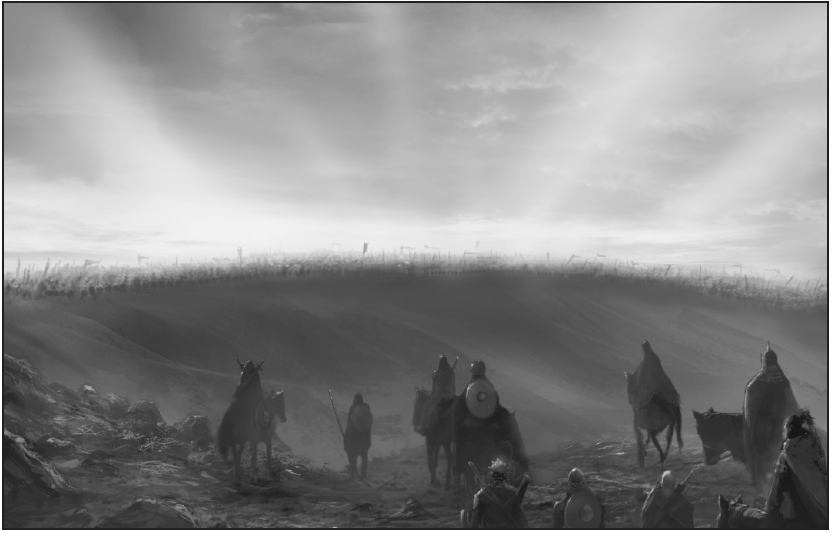
This is it. The final adventure in the Northlands Saga Adventure Path, for levels 16th to 18th. There has been 6 years of relative peace since the defeat of Althunak and the passing of Hengrid Donarsdottir. In that time old Meg's prophecy of nine years of bliss came to be, as Njal Magnusson took up leadership of Hrolfland after the passing of his father. After finishing a successful war against mountain folk and thrydreg raiders he established trade ties with Nieuland . He even established a colony of Hrolfsberf in the far western edge of the continent of Libynos. For a while, things were on the up-and-up, but his wife Sveni died in childbirth after the delivery of their second son. To make matters worse the colony of Hrolfsberg was attacked by strange forces, its entire population slaughtered and ritually staked. It was discovered that the raiders bore coins minted in Mulstahba, a pseudo-Arabian city-state whose land-bridge canals control trade between the northern and southern seas. Normally they were neutral and kept out of people's affairs beyond trade, but this seeming hostility was enough to get Njal to mount an army to take the fight to their citadel-city of Jem Karteis. He also took along his 14 year old eldest son Eymund and eventual High Køenig . The result of the campaign has not been heard of in months, and the loss of such warriors risks opening much of the eastern Northlands to attack. Fritha, the 8-year-old daughter of Njal, is a preternaturally-gifted seer who with the aid of other godi experienced a vision: to save not only the Køenig and his army from destruction (who are alive yet caught behind enemy lines) and to save the entire Northlands, a Great Northern Army must be assembled with the PCs at the helm. But the real masters behind the scenes are the Huuns, whose advance forces more or less took over Mulstahba via a coup. This is but a part of a much larger plan to invade the Northlands and eventually all of Akados.
One Thing to Clear: the PCs gained the sword Kroenarck as a reward for NS9, as the dwarf smith Bvalin may only ass to the afterlife when the sword's placed in the hand of the rightful High Køenig of the Northlands. Given that merely carrying this sword will summon all manner of opportunistic troublemakers and no end of grief, Bvalin transforms the sword to appear as a different legendary blade: Magnarck, a golden sword lost at sea.
The adventure begins with the PCs arriving in Trotheim at a gathering of some of the greatest political rulers of the Northlands and Kollsveinn Hearthson. The above information is more or less relayed (save the details of Njal's ascension which is public knowledge), and after taking a palm-cutting blood-oath to Odin and Thor the PCs have a task: gather up warriors from Storstrøm Vale, Estenfird, and Vastavikland. Gatland and Hrolfland are already willing to commit given Eymund's blood relation, and the Køenig of Hordaland has also committed his forces. The PCs can handle each region as its own sub-plot in whatever order they please, but before they head off Kollsveinn has one more thing to give them: Skíðblaðnir, the magical dwarven ship capable of shrinking down into a portable cloth!
Man, this adventure path hands out ships like candy. But this isn't just for fun; it's meant to get around Mulstahba's territorial defenses later on down the road. The adventure path notes that while the PCs are more than capable of using divination and teleportation to locate Njal's forces, the point of the AP is to gather an epic army and a small-group hit and run would rob them of that.
All Southerners Look Alike to Me posted:
This is not some vapid Southlander adventure where so-called heroes battle evil simply for profit or diversion, and the means to the ends are no more important than the ends themselves. No, this is a Northlands’ adventure, and its heroes are Northlanders for whom concepts such as courage, striving against hardship, and mind’s-worth stand as greater reward than a king’s ransom in hacksilver. As such, a Northlander has no qualms about going at it the hard way rather than finding the easiest route. That’s not to say that they won’t take the easier route if there’s no good reason not to; Northlanders are lusty and often larger-than-life, but they’re not stupid. Rather, in this case the Norns have spoken through the runecasting of the soothsayers and Frítha. Though it may well be within the capabilities of the PCs to quickly travel to Mulstabha on their own and singlehandedly defeat the enemy and rescue Njal, as Northlanders they would not because the fates have decreed it so. The runes said that the venture of the Great Northern Army would be successful only if it the PCs led it personally. For whatever reason, that is what the gods stipulated to prevent failure in the rescue of Køenig Njal, and as true Northlanders, the PCs know it is not the place of mortals to question the will of gods. Instead, it is their place to bear up under whatever hardships the gods have placed before them and prove their mettle so that they may brag about it to legendary heroes of old over drinking horns filled with mead in the corpse-hall of Valhalla. That is the stuff that makes a Northlander. Wyrd bið ful aræd.
It's rather railroady, although I wish the adventure built around this a bit. Although saving Njal is a thing drawing the adventure forward, the larger threat in waiting is the Huun Imperium's plan. Even if Njal is found and taken back, the creation of a Great Northern Army is a necessity if this information is found out by say, scouting around Mulstahba and noticing that the city's underwent a change in leadership. Anyhoo back to the adventure.
The Great Army of the Northlands
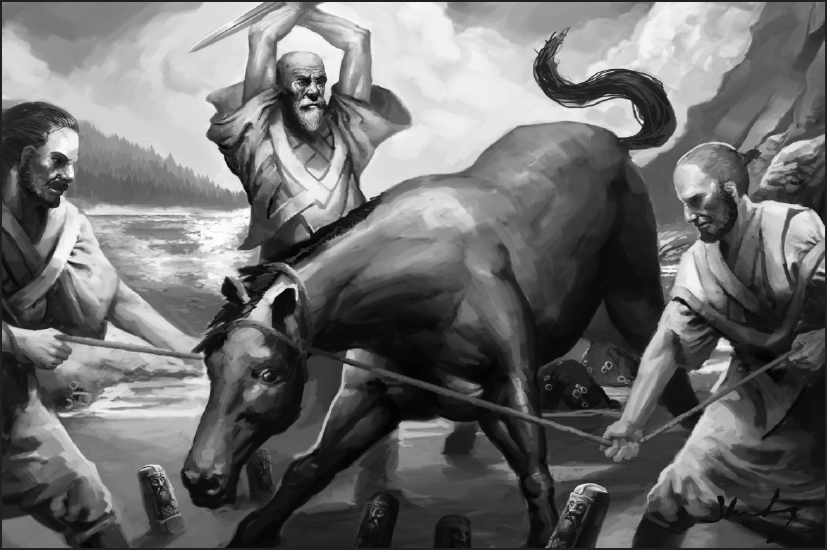
The first chapter out of four is actually the longest at 31 pages, enough to equal an entire adventure in page length. In order to gather the forces for Storstrøm Vale, the PCs must attend the Althing and use Perform (Oratory) and various other skill checks to win over the votes of various factions. Given that the PCs are quite literally the highest-level badasses in the Northlands, holmgang cannot be used to win votes given that the PCs' victory is a sure thing and slaying/disgracing beloved leaders for what is to be a unitary thing isn't a good idea. Additionally, no magic may be used in the hall during the votes. Every faction has a list of their concerns, their spokesmen, how many votes they have, and what arguing points can be used to help persuade them. The actions of previous adventures can play into this: mentioning the saving of Trotheim to sway the traders, having a colony in Nieuland to act as a supply line in war, using NPCs from prior adventures such as Jarl Anud Curse-Spear to vouch for them, etc. I particularly like this, in that it strongly plays upon the actions of earlier adventures to make the PCs' accomplishments matter right now.
If the PCs can score 95 out of 142 votes (2/3rds majority) they get army units from Storstrøm Vale. If not they will have to make do without them in the coming battles.
The side-quest in Estenfird you'd think would be harder, given that they use direct democracy. But the adventure has this covered. The PCs' heroism and the news of a great army has already reached this frontier land, and the larger villages appointed representatives to head for Vöss to hear from the PCs and carry the news back to their people to deliberate. The meeting was intended to take place in a large barn, but Jomsviking assassins under the payment of the Mulstahbin government already got here. The 24 representatives are dead and hanging from the rafters, and the Jomsviking's druid officer transformed the warriors into disguised trees to better ambush the PCs. The Jomsvikings underwent some level-ups since Raven Banners Over Gatland with assassins being multi-class barbarian/fighters/rogues at 4 levels each; the common giants have 5 levels in fighter, and the leader is a 15th-level druid. Mulstahbin coins can be found on their persons or in their longship. News spreads fast of the massacre and soon the Estenfirders are united in a way the PCs could not do. Their anger will initially be towards the Jomsvikings, but the coins are ample evidence of Mulstahba's guilt.
The final realm is in Vastavikland, the hardest and toughest realm of a hard and tough campaign setting. Even the ruler Kol the Redhanded's authority is but as long as his sword-arm, and when the PCs meet him in his fortress-village he's quite eager to explain how things are done here:
quote:
I am Kol the Redhanded, who killed Hermund Giantson on the mountain and drank the blood of Óleifr’s wife before his very eyes — just before I plucked them from his skull. I am the deadliest raider of the North Sea and the Scourge of the Southlands. I am Køenig of Vastavikland by right of the might in my sword arm, and my blood-worm drinks deep of any who dare challenge. I will rule until I am too old to fight and some other comes to challenge and wets the floor of my hall in my battle-dew. This is the way of the true Northlander; this is the way of Vastavikland. None question my right to rule, yet even still my word reaches only the length of my sword. Beyond the walls of Smølsünd other Vastaviklanders may say unto me ‘Køenig,’ but it is not worth a piss in the sea if my sword cannot reach them. They know this, and I know this. This is a land of free men, and it is the way of Vastavikland!
This is but a portion of the boxed text, but I really like this dude. Kind of a shame we only see him in the last adventure. Instead of politicking or voting at a Thing, the only surefire way the PCs can unite Vastavikland for their fleet is to fulfill a prophecy: kill the legendary dragon Hlundel. Before they do this, the PCs can make skill checks to learn of the dragon, the legend, and previous heroes who fought it (Diplomacy attempts gets them laughed at). When they are ready, the party along with Kol and a gathering of people prepare either to fight or watch the proceedings. Hlundel is a taniniver, basically a disease-focused dragon, and the last two heroes it killed are juju zombies under its control. It is powerful in melee and has some sickness-related debuffs and spells, but since the PCs have 3 rounds to prepare before the mountain quakes and it shows up it should not be too hard for characters of this level.
Once the PCs get as many factions as they can, we get a detailed write-up of the Great Northern Army using the Mass Combat Rules. Instead of a single huge unit, it’s a bunch of units separated into smaller armies based upon region. The Vastaviklander and Hordaland armies are by far the most disciplined, being made up of 3rd-level Barbarians and 2nd-level Fighters respectively. Estenfird is the smallest army with 1st-level Warriors, and Storstrøm Vale's Army are also 1st-level Warriors but whose numbers can vary depending on whether the PCs made a deal to keep some warriors at home to defend the Vale or not (in order to gain the votes of one of the factions). Hrolfland has the largest army numberwise but most are 1st-level Commoner feudal peasant conscripts. There are also rules for splitting up the armies into smaller units after they take a certain amount of casualties. All told, the maximum number of this army is 14,000 souls (not counting leaders and PCs) and 280 longships.
Before sailing out the warriors feast, drink, and give their goodbyes to friends and family. Ljot Gatson makes an animal sacrifice of a prized stallion to win Odin's favor and hopefully bring a good omen. The 19-day long journey to Mulstahba has no random encounters, on account that any common dangers by now would be trivial to the PCs and not worth worrying about.
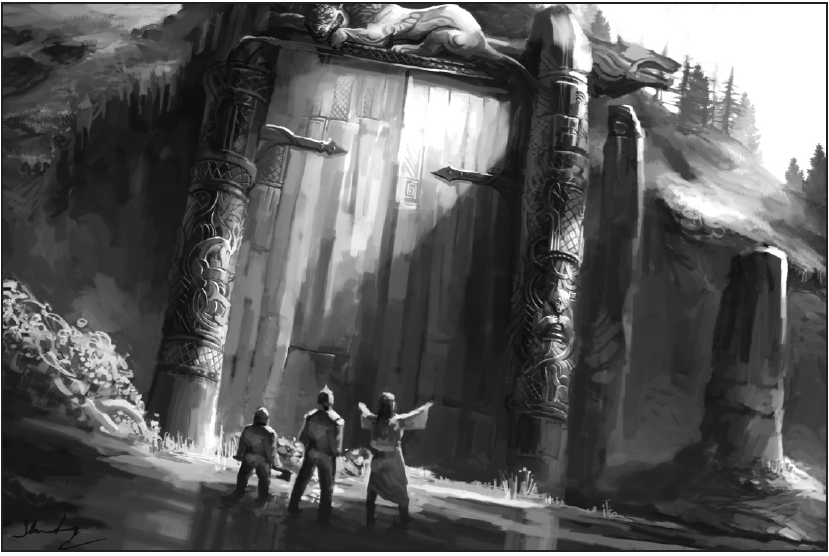
When the fleet reaches Mulstahba, making land is far from straightforward. Much of the island is covered in marshland and the water level changes rapidly based on whether it's high or low tide. To prevent ships from being stranded on land, the people of the peninsular land-bridge use long willow stems known as withies to mark passages that can support vessels in both high and low tides. Unfortunately the city-state's magical diviners are well aware of the planned invasion and moved around the withies. One of the Northlander scout ships is beached, but Skíðblaðnir's portability serves as a useful countermeasure. The PCs cannot carry the whole army with them, but they can scout ahead to find safe landing quickly. There is a swamp fort which must be taken care of to let the rest of the army pass through without incident.
The fortress is kind of a "filler" dungeon. The main entrance is guarded by carved animal statues which transform into enemies in waves for the PCs to fight (but can be dispelled). The interior is full of marsh giants and lizardfolk mooks of middling challenge rating (8). Iskarfa is a green hag witch and commander of the giants, who when killed transforms into a peluda dragon which causes the ground in the room they're fighting to give way to lower flooded passages.
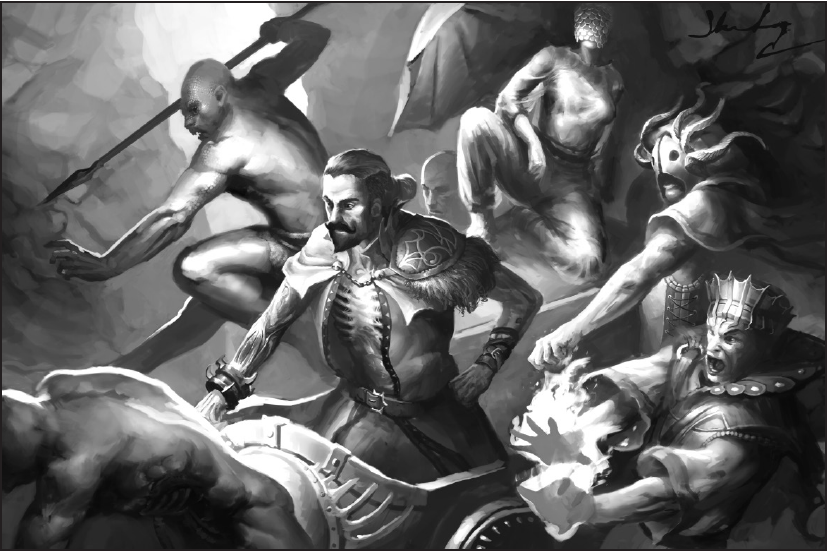
After the fortress is taken care of, the PCs are tasked with scouting further inland. There is no army on the main shore, but there is a small elite team of assayers dispatched to lay magical and alchemical traps along the shore to cripple the Northlander fleet. They also happen to be some of the most politically powerful people of Jem Karteis remaining after the Huun coup. They're a five-person band: Boabey Mhez, a crazed pyromancer who believes he's actually a fire elemental and can wild shape into one; Ezkercia S’tinbxa, a conjurer wearing a veil of coins who has a legion of eunuch bloodragers to carry her in a palanquin to prevent her from touching the ground (a superstition among Mulstahba's rulers); Bolatehbu, a dragon disciple sorcerer who initially wears a cloak but disrobes in combat to fight naked; Shith Kalhe, a necromancer who commands a war chariot pulled by a hill giant; and Tbyx, a crazy fire mage who is eager to kill people and is only along for the ride after the rest extracted a promise from him to obey their every command.
Interestingly all but Bolatehbu do not have stats in the book; the other Assayers make reference to stat blocks from Paizo’s NPC Codex, which is surprisingly common for this last adventure. Most enemies beforehand were fully-statted in the adventure path. It's generally only monsters and mooks who get the 'see book X' treatment. Fortunately all of these statblocks are on the D20PFSRD, so you don't need to buy a whole new book to use this adventure!

The Land of the Bull From the Sea
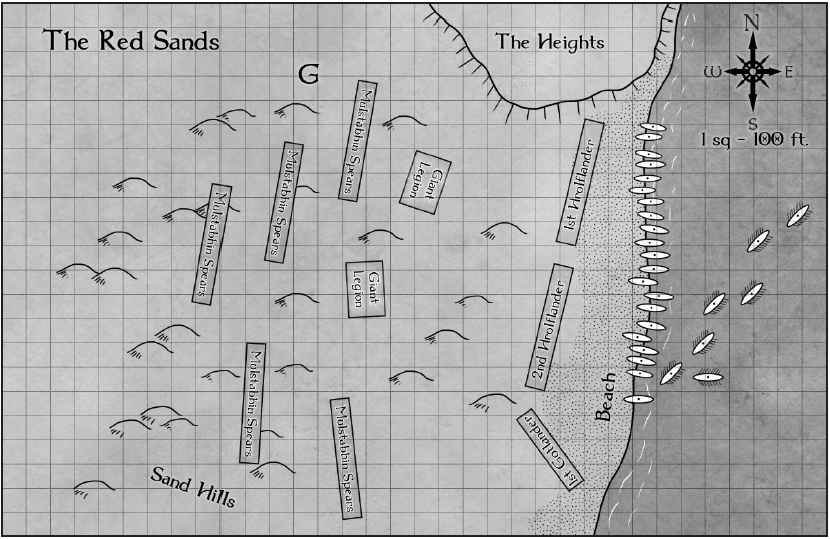
This is a relatively short chapter. From way back in Blood on the Snow we used Mass Combat Rules only once, but now they're coming back in full force! The main battle here is when the ships of the Great Northern Army begin to sail to the shore to meet the first of the Mulstabhin army. The PCs' actions can help even if they don't choose to command the army; using area of effect and terrain-based spells on the army can lower their Offensive and Defensive modifiers when the actual battle comes,. There is an encounter on the plateau when a team of elite assassins will sweep into the northern units to lay havoc if the PCs don't wipe them out as its own encounter. Initially the battle begins with crappy Hrolflander conscripts and a better Gatlander unit on the PCs’ side; although initially outnumbered, every few army phases (basically rounds) more Northlander ships dock to provide more units until the whole Great Northern Army is present.
In case the gaming table's not interested in mass combat rules, there is a Narrative Summary to sum up the action. Although a good idea in principle, it's very wordy and has the feel of reading a fictional novel. It even dictates the actions of PCs (presuming common archetypes), which I personally find a big no-no. There's also a detailed sidebar explaining how to calculate treasure shares gained during this battle and future ones, both to divide among the PCs and the army units. I personally find this extraneous; it's already late in the campaign and given the process it's unlikely the PCs are going to have enough time to craft expensive magic items or buy more longships/siege equipment given that the only major trade city nearby is the one they’re invading. One thing that brought a chuckle out of me is in an example provided in the sidebar, the party cleric keeps a larger share via a loophole where he's the owner of Skíðblaðnir and entitled to a captain's share...with no crew to split the proceeds. The party acquiesces to his demands as he's the only provider of magical healing.
I get the feeling this happened in the Northlands' playtesting phase...
The army makes camp at the shore to recover their losses. The battlefield attracts all manner of carrion, including creepy crab swarms that make distressing scuttling sounds and are kept at bay from the ships via ring of brushfire torches. The assembled godi spellcasters are doing their best to cast divination after divination spell to locate Njal to no avail, while using their own to ward the army from scrying attempts. The reality of the situation is that the wyrd of Njal is not to be hunted and cornered, but to face his foes in open battle. As such the Æsir are engaging in a cosmic spellslinging game with Nergal (the Huun's patron deity) to counter the influences of each other's spellcasters on Midgard. The Northern Army does not have much to go on besides the fact that "the setting sun hides the Køenig of the Northlands," but a distraught new soldier comes in. He claims to have seen the shade of Lord Jorund (a Hrolfand leader who perished in the preceding fight) repeating a single line:
quote:
'The doom of the North lies where the Bull climbs from the sea. They that would stay the hand of darkness must go there and look for the mark of Donar, but they must go alone for the army marches to Ragnarök and not god nor man can say its fate while the Bull yet stands unbroken.’
Certain skills and research infer that Mulstahban folklore tells that a mythical bull rose from the sea to become leader of what is their modern nation, and the city of Jem Karteis has an architectural design akin to that of a bull: two fortress-spires as horns at the front gates, with buildings sloping down a cliff to form the bull’s back, and the "legs" are a pair of sturdy cliffs rising out of the sea where the docks are located. As such the Great Northern Army must continue westward to find Njal's forces while the party infiltrates Jem Karteis to find the mark of Donar.
Along the way the adventure provides optional encounters in the form of mass combat encounters for the army and encounters for the PCs. The adventure advises changing the size and scope of challenges to avoid the army from taking too many casualties for the eventual grand final battle. The "random" encounters for the PCs are one-time occurrences and appropriately powerful, providing a bit of world-lore for Mulstahba:
1.) a road of staked skulls who provide divination to the Deathspeaker necromancer responsible for its upkeep (an astrological divination spoke of a Road of Souls to defeat the Northlanders);
2.) a former battle of Mulstabhins and a portion of Njal's forces dead, where appropriate checks can show that it's not just Mulstahbins they fought (the Huun) and possibly non-humanoid tracks among them;
3.) villages either occupied (whose folk are protected by hobgoblin mamluks, elite forces of the city-state) or empty (Huuns slaughtered inhabitants for withholding tax grain);
4.) the Titan of Mulstahba, a jack-in-irons giant who is has an arcane archer and drummer bard strapped to each of its soldiers, and is one of the islands' most notable guardians.
The Mulstahba of Jem Karteis
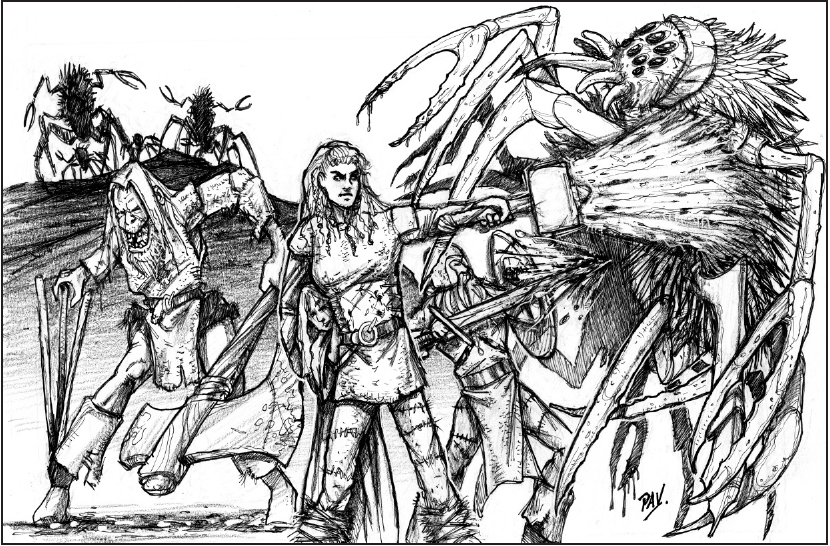
This chapter is a two-parter: the first portion is dedicated to an extensive write-up of Mulstahbin society and culture, and the second half covers the PCs' adventure for the mark of Donar. The detail for Mulstahba is quite commendable, especially on account that ordinarily in the adventure a lot of this would be passed over given the nature of it (sneaking in followed by big battles). I'm not going to cover it all, but I'll cover a few salient points.
“Mulstabha” is a rather interesting word: it's derived from a minotaur sailor of the same name who landed his ship here and conquered the native tribes to build a large city. Very little is recalled of the minotaur king beyond speculation and legend, but the iconography of a bull rising from the waves to walk upon land is a huge fixture in Mulstahban art. The word "Mulstahba" is meant to represent government as well as a social contract forged to unite the people. Therefore, it is used to describe the homeland, the city-state, and its ruling king. The Mulstahba (city-state) of Jem Karteis is located inland, and is ruled by the Mulstahba (king) of Jem Karteis. This confuses a lot of outsiders, and the meaning of the word is meant to be sussed out based on the context of the sentence it's spoken in. Additionally while many people use Mulstahban passage for north-south trade (and indeed Northlanders have to pass through here to raid the Southlands beyond Monrovia), the city of Jem Karteis restricts entry to citizens only. Foreigners may only set foot on and trade in the docks which comprise the city's "hindquarters." Their monetary units are directly inspired by real-world Greek and Jewish currency: staters, shekels, drachma, dekastarter, and electrum staters. Although the sample NPC names don't sound Arabic or Greek that I know of, their use of mamluks and a military rank title of Emir-general were concepts of authority in the real-world Islamic Caliphates (and later the Ottoman Empire).
Mulstahba is a caste-based society, where theoretically a person's lot in life is based upon the astrological divinations and prophecies. There are the Unseen, rulers directly related down five generations to the current and former Mulstahbas. The Unseen mask their faces and have strong taboos upon walking on the ground outside their homes (footwraps and palanquins get around this to varying degrees). The Unbearing are a conglomeration of religious and governmental authorities whose function is vital to running the city but do not otherwise have royal blood. The Unknown comprise common laborers, workers, and business owners, and one among them every year is elevated to the Unbearing caste to encourage loyalty and a sense of contentment ("if I win the nobles' favor I stand a chance!"). The Unwritten are slaves, criminals, and the poorest of the poor. It is common for higher-ranking Castes to be banished to this one for great crimes. The Uncasted includes nomadic tribes living outside the city and certain Hykadrion priests who are tolerated but do not have any specific privileges or restrictions. Then there are those who lie outside the caste system in their own social orders: the hobgoblin slave-soldier mameluks and the Unspeaking, an undead slave labor force responsible for mining, road-building in swampland, and other dangerous jobs.
There are two major religious orders: There is Mulstahbin Astrology, where people chart the course of the future via a combination of study of the heavens and the natural philosophy of the world's elements. The second religion is known as the Hykadrion Prophecies, who hold more temporal authority and believe that dragons are sacred beings to revere and emulate. It is believed that such creatures will help save humanoids from a prophesied "Time of Darkness."
As for the Huun, much less is talked about them, with the bulk in a single-page sidebar. The authors of Frog God Games have been building them up as a mysterious evil force for the Lost Lands Campaign Setting, with scant references to them in other products. This adventure ends with hints at their plans of a magical network of portals as a teaser for their eventual world domination. This is done by transporting whole armies around the world. The book doesn't out and out say it, but after looking at their military titles (aga, chorbaji, etc) as well as their scribes wearing red felt caps (a fez) they are more or less Fantasy Counterpart Ottoman Turks. That is, if Ottoman Turks were uniformly dark-skinned and worshipped the Babylonian death god Nergal. The Huuns live on the far eastern side of Libynos and contributed to several major campaigns fighting the Foerdewaith Empire and most recently the city of Bard's Gate. Their homeland is an arid desert and their warriors dress in black robes and paint their eyes and top half of their faces with kohl (mascara make-up). This last part earned them the title of "black-eyed Huuns" among their enemies. They are ruled by an immortal King of Kings who sat uncontested since their empire's founding, and they believe the people of the continent of Akados (which includes the Northlands) are descendants of one of their ancient enemies, the long-dead Hyperborean Empire. As a result, they have a major grudge against everyone west of Mulstahba and seek to show this in campaigns of slaughter.
What I Changed: I made the Huuns in my campaign based off of real-world Hunns on account of the one-letter difference. They were much more steppe-archers than Ottomans. While their King of Kings still plotted the domination of Akados, he wants to turn the inhabitants into loyal subjects rather than outright genocide. During Return of Hallbjorn I had a colony of lost Huun scouts as one of the settlements along with Northlanders and people from the Ammuyad Caliphate; I had the Transborean Current be a sort of Bermuda Triangle-like effect of taking lost voyages to Nieuland’s shores. Although I still had the Huun as a sort of mysterious stand-offish group, they allied with the PCs when a branch of the Children of Althunak was using supernatural localized winters to force the various settlements and (human!) indigenous people to pledge loyalty. I plan to combine bits of NS10 with NS9 to wrap up our campaign early, where the Huuns invade the Northlands while an Althunak-possessed Hengrid is stirring up trouble. Although the King of Kings is villainous (he wants to find a way to control Althunak's power to direct the Fimbulwinter against enemy nations) the allied Huun NPCs from NS7 can make for potential strange bedfellows. But I have yet to tell that story...
But enough about late-game world-building, let's move on to the adventure!
This part of the chapter is a dungeon crawl where the PCs encounter a massive ringed fortification. As the PCs are presumed to have all manner of magic, class features, and even just high Stealth at their disposal, encounters and eluding detection are assumed to be automatic. There is a section of wall being repaired where a huge split from a great lightning bolt hit many years ago. This is obviously the mark of Donar, and here the PCs can go into an underground section and make an unlikely ally. The dungeon beneath the wall holds brass golems, a pit of chain worms, and legions of undead slave miners in tunnels full of flammable gas. Some undead will notice the PCs' intrusion to report to their master: Islaug, the first Jomsking cast out from the Jomsvikings to sail to unknown shores. He and a crew of loyalists landed in Mulstahba and gifted with undeath from their dark god managed to survive for several centuries underground. If the PCs do not immediately attack, he will explain his story and how he can aid the party in the eventual battle: the undead laborers are commanded by a necromancer bearing a black stone which can bend undead to his will. If the stone is destroyed he can lead an army of the unliving to fight for them. He addresses the PC bearing Kroenarck, even if the blade is disguised and not currently wielded.
Later on in the dungeon the PCs can find several Huun soldiers, who are alternately spear-bearing infantry or astride Karkaddan mounts. There is also a prison where Huun scribes take notes of the confession of Mulstahbin prisoners with the aid of a crucidaemon and a giant martuush (cobra-scorpion hybrid) to feed less compliant captives. The PCs can find a shrine to Nergal tainting a local water supply, as well as an incense-heavy shrine where several priests and Egyptian-style golem guards are maintaining a soul gate where several Huun assassins cross through to teleport elsewhere. This is one of the Huun's major military breakthroughs: via the use of unholy water mixed with blood a watery one or two-way portal can be made that acts as a scrying focus for the connected areas. Although still in the development stages, the Huun Imperium plans to create large enough Soul Gates keyed to strategic locations around the Material Plane to move entire armies around the world in an instant.
In fact, examination of this particular Soul Gate after the battle shows a stone corridor hallway bearing the clan emblem of the Hrolfs. The Huun sent a team of assassins to kill Njal's family and other important people of the Hrolf clan!
The next dungeon takes place in the tower of Stone Keep, the Northlands' greatest (and only) feudal-style castle. It's a short six-room affair, with the rest of the castle beyond the scope of this adventure. A group of Nachtjäger Rogues ambushed the guards while the Huun and their daemon allies went further into the tower. A pair of cacodaemons will shapeshift into guards to convince the PCs that nothing is amiss and the intruders are taken care of, although talking with them reveals that they know little of Northlands culture and a Perception check spots fresh flowing blood leaking out below a nearby doorway they’re guarding. Lady Sanja, the wife of the late Magnus Hrolfsblood, was killed by a daemon who’s now taking her disguise, but the two younger children (Fritha and Grimr) are in the last room. Fritha's precocious magic was able to ward the doors for a time, and when the PCs finished off the assassins she opens the door to thank them. She explains how the future for once is uncertain, where the Norns left their wyrds to chance instead of cutting the string. This is significant, as the forces of Fate do not often let mortals plot their own destiny. Still, Fritha explains the Huun's portal plan for world domination along with an omen from Odin:
quote:
"The sun does set but also rises
’Gainst blackest wyrd of fiends and men
Call forth the dead the North despises
The sword that sleeps must wake again."
And with that she tells of how the PCs are needed in the east again to help their father. The adventure mentions that one of the assassins has boots of teleportation the PCs can use, along with a portable hole to transfer the whole party if they cannot do so themselves (the soul gate to the castle's one-way).
The Battle of Jem Karteis
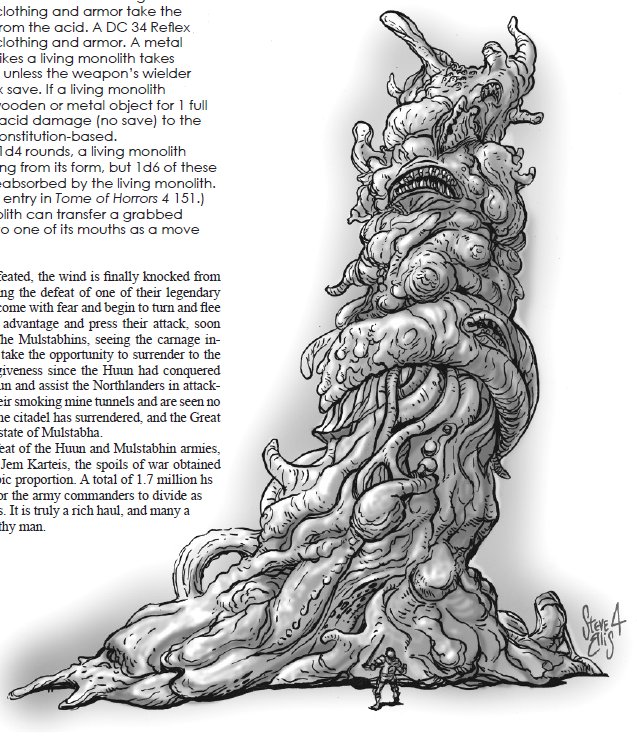
We're in the home stretch baby! The last chapter of the last adventure of the Northlands is a good old-fashioned final battle between tens of thousands of soldiers with a mixture of Mass Combat Rules and personalized encounters for the PCs. The first part occurs when the PCs aren't here: Njal's forces, who managed to survive so far via hit-and-run raids and sacking villages for supplies, are headed to Jem Karteis. Njal saw an omen as two one-eyed ravens visited him while sleeping, which he interpreted as a sign to seek out their ultimate foes directly. Meanwhile the Great Northern Army is closing in on Jem Karteis.
Our first mass combat encounter has Njal's outnumbered, inferior forces facing Mulstahbin cavalry. When the good guys suffer a heavy beating, the Great Northern Army joins the fray to save their Køenig and High Køenig-to-be. There's a bunch of detailed tactics listed for the Mulstabhin forces, along with a two page-long Narrative summary (but no PC-dictating this time!). Unfortunately, the assembled forces are but a fraction of the Huun's true might. Via a complicated series of sluice-gates and canals, a massive Soul Gate forms like a side-ways lake of blood over the wall, revealing a vision of a desert land with an old pyramid...and countless legions of Huun warriors, from humans to giants to Colossal armored glyptodons bearing siege towers! They charge through the join the fray and the Northlanders’ resolve wanes.
Our PCs join the fray once they teleport back to Mulstahba. There is a strong sensation (like fingers pulling at golden threads connected to their souls) to head to the wall which bore the mark of Donar. Upon the wall is Servant Ali-Asekar, Death’s Master and Herald of the Bringer of Peace, the general responsible for Mulstahba's subjugation and the eventual destruction of the Northlands. He does not have his own stat block, instead using the NPC Codex's Death Master but with several domain spells swapped around. The PCs must scale the wall by might or magic and destroy the Soul Gate along with Ali-Asekar and his many guards and zombies. Additionally the black stone Islaug spoke of, is here too and destroying it (and Ali-Asekar) causes the next scene to occur. Setting fire to the tunnels below, sections of wall crumble to disrupt the Soul Gate (the PCs automatically escape harmlessly).
Now the PCs can join the battle directly. If they tarry about on their own rather than shacking up with the larger forces, they encounter a fight with one of the glyptodon war-beasts and its tower's occupants. We go back to Mass Combat Rules, save that an Army of the Dead gives two more units on the battlefield (and of course more Narrative Summary).
The final encounter is the Broken Shieldwall, the same name as the adventure. Some serious shit happens in a long amount of boxed text: Kol the Red-Handed lands a lucky critical hit on a war-beast's neck and sends it and its riders tumbling to their deaths, Eymund grabs a Huun's spear and stabs the eye of another war-beast to kill it, only for Eymund to encounter a pair of giants and Njal follows to save his eldest son. The PC bearing Kroenarck feels a strong pull, and if they get there super-fast via magic a pair of desert giants ambush them while the following boxed text is presumed to happen while the PCs are fighting. This is an interesting touch I haven't seen many other adventures do:
Njal gets into a one-on-one duel with an armored troll. Although at one point the troll loses his weapon, just like way back in Raven Banners Over Gatland does Njal allow his opponent to regain his footing. But instead of rising the troll deceptively thrusts forward with his blade, straight through Njal's stomach and spine before the monster's skull is crushed in from one last blow. Njal breathes his last and a vision of the Norns cutting his thread flash by the PC's eyes. Eymund's sword shatters at the troll’s hands, leaving him weaponless as the enemy advances. He does not take his father's weapon, knowing that he must have it in his hands to reach Valhalla...
At this point the adventure encourages the PCs to give/throw him Kroenarck, and the PC who does so gets 100k EXP and a +1 bonus to an ability score of their choice; the rest of the party gets 50k each. Eymund uses the sword to kill the troll in one hit (what's with all these Cutscene Powers lately?) as a pair of Sand Giants ambush the PCs. They're like desert giants but stronger.
If the PC does not give the sword, the adventure's kind of at a loss for words as to what happens:
quote:
The rest of the adventure assumes that the PCs follow their wyrd set in motion decades ago with a call to the mead hall of Jarl Olaf Henrikson and give Eymund the sword. If they choose to not do so, all is not lost. Continue the adventure as written with the modification to remove Eymund receiving the sword. It may just be that the PC is destined to become the High Køenig of the Northlands, if the GM wishes to develop that campaign ending.
But that's not all. The sword may be united with the High Køenig, but the Final Boss of The Northlands Saga has yet to appear. Continuing on, the Northmen seem to be winning against all odds, but something terrible happens: the bodies of the Huuns twitch, roll, fly, and otherwise move together to form a giant mound. But instead of a pile of bodies the corpses melt together into a giant amorphous pillar of bubbling acidic flesh. This is Ali-Asekar's last gambit, the summoning of one of Nergal's divine messengers into Midgard.
I'm just going to say it. It doesn't compare to the fight against Hengrid Donarsdottir. The "Pillar of Nergal" is a living monolith, a monster from the Tome of Horrors 4. It is a CR 20 extraplanar ooze with good sensory capabilities (tremorsense & blindsight out to 120 feet), regeneration vs non-fire attacks, an impassible DR 10, and Spell Resistance of 30. It has the ability to spawn offfspring every 1d4 rounds (treated as their own monsters) but it's presumed that the Northern armies are fighting them so it's just the Pillar vs the Party. The Pillar has 5 attacks and can deal lots of damage in melee and 10d8 acid to those it swallows whole...
BUT THE FINAL BOSS HAS NO RANGED ATTACKS OR MOVEMENT CAPABILITES!
Yes, a PC with overland flight or even a winged mount can basically stay out of this thing's reach and whittle it down with spells and arrows (ideally fiery arrows). I realize I didn't get time to do an in-depth look at Hengrid in the previous chapter, but at least she had an iceberg AoE and a magic hammer which can be thrown and used to call lightning/wind wall. Besides the least-powerful yeti, each of the forms had some kind of ranged capability: cone of cold (wendigo), polary ray (ice yai oni), rock throwing for the jotun, a fly speed (wendigo and oni), and possibility some battlefield control and defensive capabilities such as a solid fog or gaseous form with the ice yai oni, or an at-will phantom steed and freedom of movement as a cold rider. Both bosses have an action economy disadvantage, but in this case Hengrid is most likely going to be a more entertaining fight.
And the Pillar of Nergal is the ooze type, the second-least common creature type in this AP besides Fey and of a type not vulnerable to the Saga’s most iconic weapons!
Concluding the Adventure
Once the Living Pillar is felled, the remaining Huun forces fall into disarray and retreat. The Mulstahbin forces either surrender to beg for mercy from the Northlanders or attack the retreating Huuns for taking over their country. In the aftermath, a great haul of 1.7 million hacksilver is taken as loot to divide among the commanders and PCs. Many of the most powerful leaders of the Northlands fell in battle, and they cannot be resurrected as they became Victims of Fate. Aha, that explains all those one-hit kills! Eymund inherits the crown of Hrolfland at the tender age of 14 and is appointed ruler of Gatland as well as their Jarl. Køenig Leif Ragison of Hordaland swears fealty to him, and the Althing of of Storstrøm Vale appoints him Køenig of the Vale. Vastavikland and Estenfird are the only lands to not officially recognize him, but the possession of Kroenarck as well as the aforementioned claims of rulership more or less unite the Northlands. Eymund takes the surname Njalson instead of Hrolfsblood in honor of his father.
As for the PCs, they are recognized as the greatest heroes of the Northlands and there's a bullet-point list of suggestions for their futures. They include becoming Køenig of Mulstahba which is conquered as a Northland province, becoming Køenig of Vastavikland for defeating Hlundel, becoming head of the Hall of the Hearth Stone for a godi PC, an arcane spellcaster is appointed to train Fritha, a diplomatic PC is appointed emissary to the Southlands in Bard's Gate, a guardian-type PC replacing Hengrid Donarsdottir as Protector of Estenfird, and for a Nûk or dwarf PC leading their people to establish a new homeland in the Seal Coast or Mount Helgastervän respectively. Finally we have an option of venturing beneath the Wold Tree's roots to bring news of the daughters of Skuld to the Norns, or clearing out the undead beneath Jem Karteis.
quote:
But all of that, as they say, is another story.
So ends the Northlands Saga Complete … Wyrd bið ful aræd.
The last bit translates to "Fate is inexorable."
Concluding Thoughts: The Broken Shieldwall has the right tempo for an epic battle, only to be hamstrung by "but thou must" options and a little too much Cutscene Dialogue in both narrative summary and boxed text. The environs of Mulstahba, although quite evocative and cool, are a place never before mentioned in the adventure path. Eymund and his legacy feels like a bit of spotlight-stealing. Although his legacy was mentioned before by Old Meg 5 adventures ago, Eymund’s an NPC who the party has never interacted with and won't until the final battle. He's 14 years old by the time of this adventure, and the inclusion of a Chosen One Kid Hero doing all this superhuman stuff feels a bit jarring in comparison with the Northland's intended gritty sword-and-sorcery feel. The Huun more or less come out of nowhere and do not have that feeling of leading up to the big confrontation like one would do with say, Althunak's defeat. Whereas the Mulstahbins were portrayed with some nuance and had a surprisingly detailed society, the inner SJW in me can't help but bristle at the Huun being more or less swarthy Middle Eastern invaders part of a death cult.
In short, Broken Shieldwall does not rate highly for me. But I feel that for a more holistic view of the entire sourcebook, we need to separate the Northlands into several "arcs."
First we have the Prequel Arc of NS0, both very strong adventures which in spite of their low level sell you on the setting's themes and make you feel like big badass heroes right from level 1.
Then we have the Kenneth Spencer Arc of NS1-NS4. It too is good, with plenty of variety from one adventure to the next. From Argonauts-style voyages to lift a curse to leading an Inuit uprising, there's something that keeps this Arc feeling fresh instead of stale.
Then we have the Post-Ken Arc, NS5-NS10 where other writers take over based on his existing notes. And hoo boy do we see a massive change here! Raven Banners Over Gatland is good, clean fun. Plague in Trotheim is passable if a bit too high fantasy, and Return of Hallbjorn is straight up "slaughter the Indians for loot and EXP." Hallburning is several levels too high for its concept and involves characters the PCs never heard of or cared about to make things personal. Daughter of Thunder and Storm is perhaps the best adventure in that it wraps up the long-standing BBEG of Althunak with a touching mixture of role-playing and Nordic martial heroism. Broken Shieldwall feels like an extended sequel-bait for a Huun Invasion metaplot for a future Lost Lands book.
But in spite of the gradual downward curve and additional personal changes to make the campaign work, Northlands overall is a very good book. I do not regret purchasing it and running it for 1.2 years. For in spite of the problems I outlined throughout this review, there is a golden core of material for a GM to mold into something beautiful.
Join us next time as we cover a bonus stand-alone adventure in the back of the book: Winter's Teeth!
The Long Night of Winter NLS 1: Winter's Teeth
Original SA post
The Long Night of Winter NLS 1: Winter's Teeth
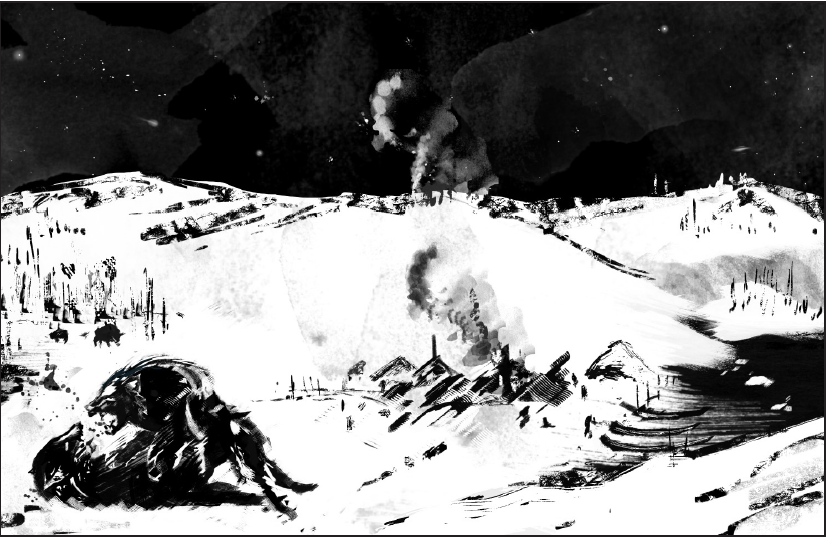
Yes that's reused artwork. And the main monster of this adventure uses the artwork of Grendel back in the Monster chapter too.
So after the major Adventure Path are two appendices: a handout and map appendix, which includes player-friendly copies of all the maps and encounters as well as the GM's versions. I find this to be an excellent gaming aid, something a lot of books of its kind do not include. The pre-generated PCs are nothing special and don't really have anything to stand out being 1st level and all. The only exception's Jón the Tree, a giant-blooded fighter who due to his Large size and 20 Strength has a greataxe which deals 3d6+7 damage at 10 feet of reach. He's so clearly a superior option to the human huscarl fighter it's not even funny.
But back to the main topic: the Northlands Saga had six stand-alone adventures known as The Long Night of Winter series published as their own books. They could be played between the major events of the Adventure Path or on their own. Each of them are prefaced with in-character text from a skald about to tell people a story which just so happens to be the adventure. The first of the series is included for free within Northlands Saga Complete, so I'm reviewing it here.
Winter's Teeth is a horror-themed adventure for parties level 6th through 8th. The backstory is that late in the year the PCs are invited by Jarl Anbjorn Olefson to winter at his hall. Given that winters can very easily snow people in, both sides agreed to a pre-meetup 3 days in advice so that both they can gauge whether the other is agreeable company for several months. But when the PCs finally travel to Jarl Anbjorn's holdings, they find some vicious beast has rampaged through the village and slain just about everyone. The bulk of the adventure is a sort of murder mystery where the PCs look for survivors and possibly find the nature and weakness of the monster so as to slay it.
The responsible party is Ofieg the Axe-Bitten, one of the jarl's Bearsarkers. Remember how way back in the section for new setting class archetypes I talked about inner fires? Well a bearsarker must temper their powers in moderation: rage balanced by wisdom, physical might with divine compassion, and madness with civilization. A bearsarker who becomes too isolated from one's fellows, uses their powers for wicked endeavors, or forsakes the gods is at risk of turning into a slåtten, a creature more bestial than mortal driven by a never-ending hunger. In Ofieg's case, he grew tired of his peers and chose to live up in the mountains by himself, and the next time he came back he slaughtered everyone here.
The stats for a slåtten are given at the end of the adventure, but I'm describing it here for ease of reference. They are very powerful CR 12 creatures, which given the relatively low levels of most Northlanders earns their reputation as slaughterers of entire villages and breakers of shieldwalls. They are melee-focused, with claws and bite attacks (+23 to hit, 1d8+7/1d6+7) with rending powers and very high AC and CMD (27 and 33 respectively). But they are animalistic in nature (Intelligence 2) and besides this their major weakness is their formerly-divine connection. Divine spellcasters of Wotan, Donar, Baldr, or Tiwaz who attack the monster ignore its Damage Reduction, which is normally pierced by good-aligned weapons. When hit by such a foe, the slåtten must make a Will save or suffer degrees of fear which stack with every hit. Additionally, an herbalistic extract known as Wotan's Eye moss can be applied to weapons as a poison to get around its damage reduction.
Personally speaking, I feel that this monster is rather over-powered for the promposed level range, barring PCs with builds to take advantage of its weakness. Although the adventure has some investigation as preface and wants to play up the horror angle of being in over your head, it jives against the Nordic heroism of standing your ground and fighting. To remedy this a bit the adventure proposes that if the PCs do meet the creature early on it may briefly attack delivering grievous injuries (or a death) before retreating.
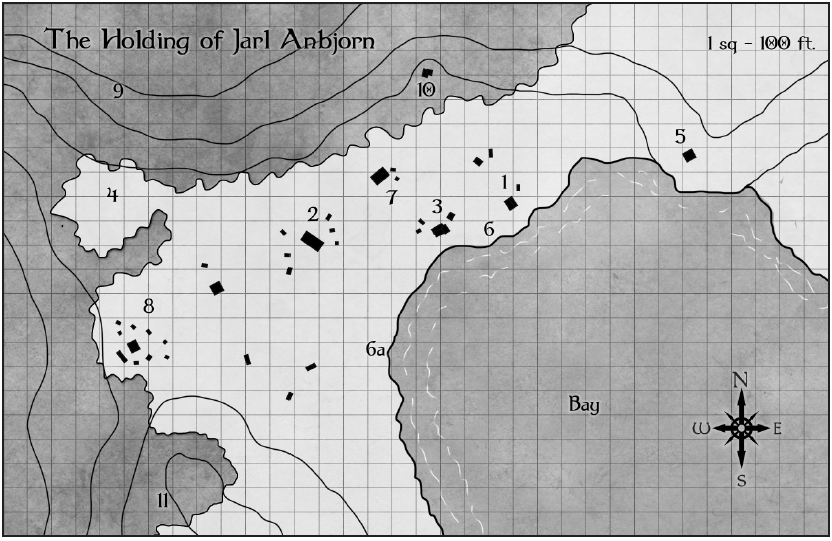
The adventure begins at the beach of area 6, where the PCs presumably sail in and find a dozen dead bodies. After that the plot becomes a mystery sandbox. The adventure has a set of skill checks regarding investigation where the PCs can put together the pieces of what happened by visiting various areas and meeting survivors. When they come to the conclusion of the monster's nature, either by the aforementioned checks, meeting the monster itself, or visiting area 11, they can then roll checks to know more about what a slåtten is. When they learn of its weaknesses, checks to learn about Wotan's Eye moss and its possible location (south-facing slopes of steep cliffs) can let the PCs find its location.
Area 1 is the farm of the now-slain Leifson's, who were done in by human treachery but whose corpses were later found and eaten by the monster. Area 2 is the jarl's hall, which has the scenes of dozens of people killed with rent mail and rotting half-eaten bodies all about. The hall has 3,000 hacksilver worth of treasure but looting the place is considered highly dishonorable.
There are a few survivors, not all of whom are necessarily trustworthy: sometime before the rampage began a beached whale washed up on the dividing line of property between the farms of Bjarik Leifson and Jorund the Bald, whose farm is area 3. Bjarik and Jorund are far from friends and gave the jarl many headaches in resolving disputes over who claimed the whale's resources of ivory, blubber, and ambergris. When the slåtten began going on a rampage, Jorund took advantage of the situation. While the town was either out hunting the beast or staying to guard their homes, Jorund and his three sons attacked Bjarik's farm and set the home on fire. To ensure that the beast would not come for his family, Jorund tied down several goats and one of his thralls to stakes leading away from his home and towards the Haddsons' farm (area 8). But the reverse happened and the monster attacked Jorund's house. Jorund, his daughter Tofa, and his thrall Sigvat barely escaped.
Jorund's group of survivors can be found in the fields of area 4, but although Jorund puts up a good front he is one sneaky snake who has no compunctions in betraying the PCs and other survivors if given the chance. Sigvat is a mute sailor who washed ashore in the village but could not prove his background. So when Tofa saved his life and nursed him back to health Jorund declared he had to pay off the debt as a thrall. Sigvat is very smart and loyal to Tofa in spite of what Jorund claims about him. There's also the jarl's son Egil who although capable of wielding a blade, yet is only 15 years old and filled with fear and survivor's guilt.
Another survivor can be found in a secret sea cave (6a) who can reveal a rough description of the beast to the PCs. Area 7 is a safe haven being a godshouse and thus avoided by the slåtten. There are 3 survivors in here: Halli Buisdottir, a pious daughter of the village godi, Gnupa whose mind is broken and is reduced to crouching and stuttering, and Little Bolla, a 9 year old girl who was injured by the monster but managed to survive. Although lucky, she has the inner fire of a Bearsarker which is now just coming to the fore. Depending on the PCs' actions they can help her learn to temper this and not do anything stupid (like flying into a pseudo-rage at the slåtten's arrival). In time she will eventually grow up to be one of the greatest Bearsarkers of the Northlands. I almost feel as if this was meant to tie in to the late-game adventures in the main book on account of the year progressions or just a bit of personal plot development for the GM to take as they may.
Area 8 is the Haddsons' farm, a sprawling collection of homesteads thanks to the clan patriarch having many children sired from his wife and thralls. In fact the slåtten was so busy killing the Haddsons it took the creature 3 days to kill them all. Now their large herds of cattle are roaming free in panicked packs about the place.
Area 9 is Ofieg's cave retreat where he now sleeps during the day as a monster and leaves at night to hunt. Area 10 is the cottage of a local herbalist who wrote a clue in Runic about Wotan's Eye extract, and she fell to her death in area 11 trying to pick some from the cliff (which requires a risky climb check and/or Reflex save to avoid falling 50 feet).
Rounding out this adventure is a table of random encounters, using a d20 table where +1 is added to the roll for every previous encounter for progressively more difficult fights. The slåtten can be encountered on a roll of 20 or higher, but the adventure advises having it show up immediately until the right tempo/progression has been met. Otherwise the author cautions you to have it be an indirect encounter: seeing a vague shape of the monster tearing cattle in half a fair distance away, a vague shadow of the creature shining down from a hilly slope, and so on and so forth. The other encounters include a very ornery dire bear who doesn't want to give up its hunting grounds to some new predator, a wolverine that went mad drinking the monster's blood, dismembered human body parts which animate as undead due to the slåtten's lingering malice (a one-time event), packs of wolf scavengers, very desperate bandits hoping to loot the farmsteads fast enough before whatever did this returns, a two-headed troll with a +2 morningstar wandering down from the monsters driven by the smell of blood, and a small family of yetis hunting the slåtten after it killed and eaten one of their kin.
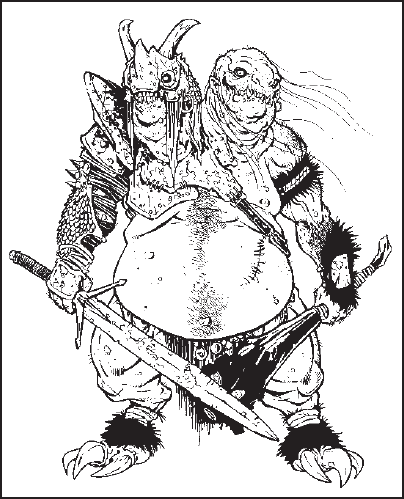
The troll encounter may be a bit of a red hearing. Such a monster is relatively rare enough in adventures and supposedly strong enough to kill a bunch of people. The PCs may assume it to be the culprit.
Concluding Thoughts: Winter's Teeth does not have a set conclusion or epilogue, unlike the main adventures. It has the right structure for a horror mystery, although the slåtten's stats should be considered carefully for GMs. Given the investigation-based nature, it favors PCs trained in Knowledge and wilderness skills to suss out clues, and less cerebral warriors may not do as well.
Overall, this is a fine adventure. It doesn't wow me, but it's not bad and can make for a fine change of pace.
So, that's it. We literally have nothing else to cover besides the OGL, the book's back cover, and a full-color poster map of the Northlands. I am glad that I got the opportunity to review this thing in such fine detail and share with you this truly unique adventure path and setting.
I can't make any promises, but I have plans to review another setting I am passionate about in the near future: Midgard World Book by Kobold Press!
Revisions
Original SA post
So on other message boards I posted this review there's a bit of a demand in curiosity on my revisions for NS7: The Return of Hallbjorn. I compiled a list of the major changes here:
1.) Half-Face in this case was still a Dorvae, but he took on the guise of Harald, a bearded Northlander godi who visited the witch PC at the end of Plague in Trotheim to commend her on the sacrifice she made for her beloved. Now he can treat her as an equal, given that she made a pact with her patron to let him take Althunak's place once she killed said god. He said that the Lord of Ice and Stone sends his regards, just as a huge jotund troll rose out of the stormy waves to throw giant rocks at Silvermeade Hall. After subduing Harald with black tentacles she reunited with the rest of the party who were sending out a fleet to attack the new threat.
2.) During the fight 3 longships from the sea arrived, Hallbjorn was among them. When the PCs were knocked off their summoned shark mounts and saved, only then did I reveal the adventure's name when they discovered the identity of their rescuer. In addition to Northlander Nieuland colonists, I had Ammuyad Caliphate and Huun sailors among the fleet, including two named NPCs for the respective factions: Nejla, a dimensional dervish Magus and Uldin, a Ranger whose hawk companion delivered potions and spell scrolls to characters climbing the troll/on other ships. My final NPC was Turid, Hallbjorn's wife and a Cleric of Odin. They did not get much screen-time save to give a "face" to the colonist factions, although I plan to have Uldin reappear in NS9 when the Huun invade the Northlands.
3.) I initially had no plans to have Nieuland contain indigenous people, troll or otherwise. But after some thought I decided to on account that our Norwegian gamer noticed hints of the Vinland Saga in the initial set-up. So instead I had the Oestryn Isles be home to a people known as the Crey, a human ethnic group strongly based off of real-world Cree people.
4.) The impetus to travel back to the Isles was motivated not by greed or crushing the natives, but when Hallbjorn discussed strange weather as of late in the normally temperate isles. When the witch PC informed him about Harald and discovered that said "godi" was gone, the tracks he left before teleporting had soil found only on the Oestryn Isles. The party realized that their old friend Althunak was making a comback in the place Hallbjorn ended up, and they disembarked to set sail once again. This was not a hard choice, as the sailors had friends and family back there.
5.) When the PCs arrived to Kasternack, they found a supernaturally cold fog over the area. A group of cloaked cultists of Althunak were holding a lottery where they gave each villager stones of different colors. Many of the stones were similarly-hued, but one of them was different from the others. When the cultists drew a stone from the bad, the person with the matching color was their pick. Said stone was enchanted with a geas spell to make the person travel alone to the Wolf Cairn Mountains. There were similar lotteries among the colonist and Crey villages. When the PCs arrived to stop this lottery, the cultists summoned a monstrous shadow dire bear (which existed in NS7 as a unique random encounter) to fight them.
6.) The witch PC ended up taking the stone from the "winner" in an effort to stop the lottery, only to be affected with the geas herself.
Granted, this was a risky maneuver, although she had a cohort NPC she could play for the duration so the group was fine with this. I had the PCs basically follow her tracks and get involve in encounters on the way to help lead them to her.
7.) In Smoking Lake Crannog, Half-Face/Harald converted parts of the ruins into an arena-like stage for the champions to fight each other. The Cult of Althunak is most active on the fringes of the world, and it was not hard for them to learn of the Oestryn Isles' unique situation. With a "ship's graveyard" style mishmash of marooned cultures, the Cult could use it as a testing ground for the martial prowess of those respective cultures without incurring the wrath of their homelands. Half-Face threatened to plunge various villages into deadly winters if they did not choose a "champion" among themselves via the lottery system. He planned to have the champions fight each other and the winner would join the Children of Althunak (this is not a yes/no choice).
8.) In addition to Kasternack, I added the villages of Duhran near the south and Uliastai to the north to represent where the Ammuyad and Huun settled respectively. The troll villages I replaced with Crey villages. I had it so that the Ammuyad people were the only village who refused to pick a champion, so I had an encounter when a pair of osyluth (bone devils) were planning to blow up a large beaver dam and flood the village. The PCs managed to stop them, although Nejla did not know that and already offered herself as Duhran's Champion (much to the consternation of the community).
9.) I reworked one of the stone golems at Giant Hill to be a multi-armed ice golem which rose to attack the party for interfering with the aforementioned osyluth encounter. The witch PC met a champion from one of the Crey villages (Beaver Lodge) and his sister. There was worry he'd kill her right then and there, but the specifics of the geas compelled both of them to fight each other in the arena and not right here and now.
10.) I had inspirations from Vengeance of the Long Serpent to have Althunak-sympathizers among the various colonist and Crey villages which the PCs could root out and destroy. However this did not occur given that the PCs were in one form or another heading directly for the Crannog. The PCs were allowed entrance, weapons and all, in that the Children of Althunak were confident enough in their numbers and strength of arms that they "wouldn't be stupid enough to try something here."
11.) I imported the Lair of the Thrall Collector's giants from NS6 to be guardians at the Crannog, along with various Children of Althunak recruited from the various villages. Non-members were allowed inside as spectators for the eventual games, as Harald wanted a Rome-like Bread & Circuses element. He even told a story about the legend of Spartacus, a slave-paladin who in a decadent empire convinced his masters to pit him against the colosseum's monsters instead of the other slaves. Harald spun this tale into a similar act of self-sacrifice the respective champions chosen. What I revealed with a successful knowledge check was that Harald did not tell the part where Spartacus led a successful slave rebellion.
12.) The witch PC managed to exploit a wording in the geas spell ("travel alone to the fortress in the eastern mountains and fight the other champions there"). It said nothing explicit about killing them, so she used a covert message spell to the other Champions. The champions feint-fighted about while the other PCs snuck about to scan the crannog's defenses.
At this point the player who used to play a skald but was now a fighter wanted to bring his old PC back, so I had him show up on an enchanted ship to disrupt the blood-sport. This distracted Half-Face/Harald and the various Children of Althunak that the witch, the Champions, and the rest of the PCs fomented a rebellion and started killing the cultists around the crannog.
13.) I planned to introduce the Jomsvikings as a hostile third-party, angered at the PCs for killling the Jomsking and wanting revenge. However this part was excised due to time constraints.
14.) Skraeling troll mooks were replaced with a mixture of human barbarian cultists and low-grade demons.